 19/06/2009 15:23 19/06/2009 15:23 |
|
| | | OFFLINE | | Post: 17.747
Post: 419 | Registrato il: 28/08/2005
Registrato il: 20/01/2009 | Administratore | Utente Senior | |
|

 Please see preceding page for earlier posts today.
Please see preceding page for earlier posts today.


 Before everything, I think it is unfair to consider the Austrian dissident bishops and the Chinese 'official' bishops in the same breath.
Before everything, I think it is unfair to consider the Austrian dissident bishops and the Chinese 'official' bishops in the same breath.
The Austrians have been openly defiant of Catholic orthodox doctrine and practices, and even more spefcifically, of the Pope himself; whereas the 'official' Chinese bishops, under coercion, though they nominally 'take their orders' from the government through the so-called Patriotic Association, have not been accused in any way of otherwise violating Catholic doctrine and practice.
We can only pray that the bishops of the world will take to heart the lessons that Benedict XVI wants to impress on all the priests of the world with the Year of Priests. The fact that judging from their recent actions, some German and Austrian bishops obviously never read teh Pope's March 10 letter to the bishops of the world, does not raise much hope that they will even feel alluded to by the Year for Priests!
Some of the bishops may have become so arrogant - in their mistaken belief that Vatican II conferred on them near-equal ahutority to the Pope - that they perhaps have stopped thinking of themselves as priests, first and foremost. Benedict XVI has never been remiss in showing his own awareness of this in his own person.
Austria and China:
The Vatican's problem bishops
Austrian bishops were called to a meeting with the Pope, who is not happy
that they have allowed rebellions and abuses to run free.
And in China, there are bishops who obey the communist government more than Rome -
though Vatican diplomacy is also at fault, says Cardinal Zen.

ROME, June 19, 2009 - At the end of the month, the bishops of the Fraternity of St. Pius X will ordain new priests, and the Holy See has confirmed that these ordinations as well will be considered illegitimate.
But the Lefebvrist schismatics are not the only bishops who are causing concern for the Roman Church. In recent days, the spotlight has also been shone on two episcopacies that, for different reasons, are also gumming up the works: Austria's, and China's.
On June 15 and 16, all of the bishops of Austria came to Rome [not all - only four out of 9], called in for a debriefing with Benedict XVI.
They met behind closed doors with the Pope and five heads of the Curia: Cardinals Giovanni Battista Re, of the Congregation for Bishops; William J. Levada, of the Congregation for the Doctrine of the Faith; Claudío Hummes, of the Congregation for the Clergy; Zenon Grocholewski, of the Congregation for Catholic Education' and Stanislaw Rylko, of the Pontifical Council for the :aity. There was also the apostolic nuncio to Vienna, Peter Stephan Zurbriggen.
The statement released at the end of the meeting didn't say so, but for two days in a row the Austrian bishops faced severe criticism.
Papa Ratzinger is very familiar with Austria. At the beginning of his pontificate, the Austrian bishops were among the first to have an audience with him. And on November 5, 2005, at the end of their "ad limina" visit, the Pope really let them have it.
He accused them of remaining silent on important points of Christian teaching and morality, out of fear of protest and ridicule. He urged them to finally take the catechism in hand and to teach it from start to finish. He ordered them, literally, to "change course."
Evidently, after more than three years [that also saw an apostolic visit by the Pope to Austria!], Benedict XVI's impression is that the Austrian bishops have made little or no progress.
More evidence of this comes from what has happened in recent months in the diocese of Linz. On January 31, the Pope had appointed Gerhard Maria Wagner, 54, a local priest with a reputation as a conservative, as auxiliary bishop of this diocese.
There was an immediate explosion of protest from progressive Catholic circles, which criticized the bishop-elect for statements made years ago equating the tsunami in Asia and the hurricane in New Orleans with "divine punishments," and the Harry Potter saga with a diabolical plot. These laughable accusations rapidly led to demands for the withdrawal of his appointment.
The worst thing, in Rome's view, was that the Austrian bishops were careful to avoid defending Wagner's appointment, and so were many of the clergy. The archbishop of Vienna, Cardinal Christoph Schönborn, also went along with the crowd. The pressure was so strong that Rome gave in.
On March 2, a terse Vatican statement let it be known that the Pope had "excused" Wagner "from accepting the office of auxiliary bishop of Linz."
The final blow: one of the leaders of the anti-Roman revolt, Josef Friedl, a prominent priest in the diocese of Linz, in declaring victory also revealed that he was living with a woman and paid no attention to the obligation of celibacy, with the approval of his parishioners and of other Austrian priests who also have lovers, and with the tolerance of the bishops.
But the Wagner case was only the culmination of a more general malaise. The final statement of the meeting on June 15-16 listed an extensive series of critical points concerning doctrine, pastoral action, the teaching of the catechism, the clergy, the seminaries, the theological faculties.
Against this backdrop, there is an even clearer contrast between the timidity with which the Austrian bishops govern their respective dioceses and their arrogant claim that it is the role of public opinion to designate new bishops or veto the ones appointed by Rome.
Another glaring contrast concerns the highest ranking Austrian bishop, Cardinal Schönborn. He is supposed to be one of Papa Ratzinger's trusted friends, but at home he gives the anti-Roman forces free rein.
Between February and March, at the height of the controversy over the revocation of the excommunication of the Lefebvrist bishops, the Austrian bishops were among those who made the least effort to defend the Pope.
The bishop of Salzburg, Alois Kothgasser, opined that under Benedict XVI, the Church "is being reduced to a sect."
At the meeting on June 15-16, the Pope tried to bring the Austrian bishops back into line, as can be intuited from this passage in the final statement:
"The Holy Father recalled the urgency of the strengthening of faith and of complete fidelity to Vatican Council II and to the postconciliar magisterium of the Church, and of the renewal of catechesis in the light of the Catechism of the Catholic Church.
As for the cohabiting clergy, Austria falls under the more strict general norms established by the Pope last January 30. When a priest lives with a woman and continues to carry out his ministry, the Vatican Congregation for the Clergy has the authority to remove him from the clerical state.
***
The case of the Chinese bishops is more complicated. There, the hierarchy is divided between an official branch recognized by the government of Beijing, and a clandestine branch that does not have this recognition.
This second branch is extremely loyal to the Pope. The 'official' Church, with its bishops nominated by the government, was created by the Communist authorities with the express intention of separating the Church of China from obedience to Rome.
In recent years, many of the official bishops have reconciled with the Pope, with the tacit approval of the government. In 2007, Benedict XVI, with an open letter to the Chinese Catholics, told all of them how to proceed in order to heal the split completely and bring the entire Chinese Church into full communion with Rome.
But more recently, the Chinese authorities have revived the politics of separation. And various official bishops have given in to the pressure.
Cardinal Joseph Zen Zekiun, bishop emeritus of Hong Kong, paints this picture of the current phase in an extensive interview published on June 16 by AsiaNews [full interview posted in the CHURCH&VATICAN THREAD on that day]:
The shift toward clarity has not taken place. On the contrary, it seems to me that there is an alarming slide along the slope of compromise.
The most alarming episode of this constant compromise, which goes against the pope's guidelines, is the celebration of the fiftieth anniversary of the first illegitimate episcopal consecrations.
This celebration is scheduled to take place in 2009, and if, as I fear, it were to succeed in obtaining significant participation from bishops and priests, that would be the end.
It would be the complete waste of all of the efforts made in previous years, and an insult to the Holy Father. Yes, it would be just like slapping him in the face, because it would be like completely ignoring his letter to the Chinese Catholics.
But in the same interview, Cardinal Zen also said: "Of course, in China they did everything they could to downplay the pope's letter. But I think that the Holy See should also have given more support to the letter. The Holy See should have followed the Pope further along the line of clarity. It seems to me that this did not take place."
Last March 30, there was a two-day meeting at the Vatican of the commission that Benedict XVI set up in 2007 to study the issues relating to the life of the Catholic Church in China.
The commission is composed of the heads of the dicasteries in the Roman Curia with responsibilities in this area, and some representatives of the Chinese episcopacy and religious congregations.
Cardinal Zen, who took part in this meeting and also in a previous one on March 10-12, 2008, maintains that the Vatican Secretariat of State gives in to compromises with the Chinese authorities because it is aiming above all at reestablishing diplomatic relations:
Diplomatic relations do not fix everything by themselves. On the contrary, they can be deceptive, because they can give the false impression that religious freedom exists.
The most important thing is religious freedom, and certainly this can be facilitated by diplomatic relations. But it is not always true that having one necessarily means having the other.
All else aside, at this moment the possibility that China would establish diplomatic relations with the Vatican seems less likely because relations between Beijing and Taiwan have significantly improved.
So just as there is division among the Chinese bishops in their relationship with Rome, so also Vatican policy appears to be divided. On the one side there is the approach of Cardinal Zen, on the other that of the Secretariat of State.
This second division is also reflected in the specialized Catholic magazines. The agency AsiaNews, under the Pontifical Institute for Foreign Missions, is with Cardinal Zen. The international monthly 30 Days, directed by former Italian head of state and foreign minister Giulio Andreotti, is with the Secretariat of State.
[Two examples are hardly representative of the world of Catholic media! More research should have been done.
Still, the basic problem with trying to comprehend what is happening in China is the obvious lack of appropriate information getting to the outside world.
Cardinal Zen made this very clear in his interview with ASiaNews - even he, with all his contacts - and as the Pope's point man for monitoring the situation of the Catholics in China - only has a general sense of what is happening: he has no knowledge of what is really taking place in each diocese.
Obviously, neither does the Vatican Secretariat of State, which is normally the lead Vatican agency responsible for collecting in-country information for the Church. But without diplomatic relations, it has no official representation inside China, and must therefore rely on spotty isolated reports from missionaries and other priests within the mainland who are able to communicate with the Vatican.]
[Modificato da TERESA BENEDETTA 20/06/2009 06:24] |
| |
|
| |
 19/06/2009 16:56 19/06/2009 16:56 |
|
| | | OFFLINE | | Post: 17.748
Post: 420 | Registrato il: 28/08/2005
Registrato il: 20/01/2009 | Administratore | Utente Senior | |
|

 Thanks to Lella and her invaluable
Thanks to Lella and her invaluable
 for leading me to this
for leading me to this:
The theologian Pope draws
inspiration from a country curate
by Lucio Brunelli
Translated from

June 19, 2009
To be a priest these days has become a difficult occupation. There was a time, for a long time in the West, when to become a priest was a form of social emancipation.
Today the common thinking - which is no longer Christian - looks at the priest with commiseration, if not outright pity [or ridicule!].
Priests are almost considered as condemned by a despotic authority to be deprived of human love - the love of a woman and of one's own children.
In bar chitchat, or in talk shows which amount to the same thing, whenever priests are discussed, there is always a wise guy who will predictably say that the only antidote to the sexual offenses by priests is to 'liberate' them from the chains of celibacy.
It is almost as if one can no longer conceive that a normal person today, even by the grace of God, could possible make such a radical choice. Much less, that anyone could feel himself realized - or even potentiated - in his emotional aspects.
The Pope is well aware that the times are difficult.
Yesterday he wrote an 8-page letter to the more than 400,000 priests of the Catholic Church. It is a manifesto for the Year of Priests which he declared to begin today, June 19, in conjunction with teh 150th death anniversary year of the Holy Curate of Ars. St. Jean-Marie Vianney.
The online editions of the major newspapers said in their headlines that this was a new 'admonition' from the Pope, as though Benedict XVI had taken pen in hand expressly and only to take priests to a scrubbing, denounce the shame brought by the sex scandals among priests, and to call to order those who are demanding abrogation of the requirement of priestly celibacy.
Only a combination of prejudice and ignorance would reduce the Pope's letter to these issues.
Obviously, Papa Ratzinger is well aware of the real situation of the clergy around the world. He has always called the 'filth that is in the Church itself' by name. And he knows there is a growing effort by organized groups, such as those in Austria, to pressure the Church into doing away with priestly celibacy.
But the Pope makes clear in his letter that the crisis in the Catholic clergy should not end only with "a frank and complete acknowledgment of the weaknesses of her ministers, but also a joyful and renewed realization of the greatness of God’s gift, embodied in the splendid example of generous pastors, religious afire with love for God and for souls, and insightful, patient spiritual guides".
It is a letter to be meditated upon, before even beginning to analyze it - enriched as it is with beautiful quotations from the Curate of Ars, St. Jean-Marie Vianney, who served as parish priest in a small French village of less than 300 souls in the first half of the 19th century.
And it is this which is most striking at first glance: This theologian Pope, an intellectual, looks to a humble country priest for inspiration. A priest whose studies were a disaster, who was rejected by seminaries, who found it difficult to learn Latin, and who became tongue-tied every time he had to speak in public.
And yet, he was a figure, the Cure of Ars, who amazed and attracted crowds from all over France.
All this without performing any miracles, merely by spending most of his time hearing confessions. And the rest in visiting the sick, comforting young people in difficulties, and being available all the time to his parishioners. The very image of the 'good shepherd'.
He spoke often of 'the torrent of divine mercy' that surpasses any human measure, including his own consciousness of his inadequacy for his role. And every useless form of clerical rigor and formalism - and in this he had a very modern attitude.
He took a loving approach - not limiting himself to admonitions - which is what the estranged Catholic today needs.
“It is not the sinner who returns to God to beg his forgiveness, but God himself who runs after the sinner and makes him return to him”, the saint said.
And to priests who are uncertain what manner to adopt in the confessional, he says: “I will tell you my recipe: I give sinners a small penance and the rest I do in their place”.
 Mr. Brunelli was off to a very good start, with an astute appreciation of the Pope's letter, but somehow, the article seems unfinished....Among other things, because he does not make the connection that Benedict XVi himself has always been a model priest, even in circumstances far different from those of St. Vianney.
Mr. Brunelli was off to a very good start, with an astute appreciation of the Pope's letter, but somehow, the article seems unfinished....Among other things, because he does not make the connection that Benedict XVi himself has always been a model priest, even in circumstances far different from those of St. Vianney.
I am trying to look up a testimonial by someone who knew him from his eaarly days as a professor in Bonn, to the effect that unlike other priest-professors, Fr. Ratzinger never stopped being a priest first, never missing the obligation of offering daily morning Mass, for instance.
And now, as Pope, Benedict XVI appears to have 'invented' a new genre of papal Magisterium - a sort of mini-encyclical addressed to specific groups of Catholics instead of to all Catholics at large, first with his letter to all bishops, now this. Very personal, very intimate, and always, very beautiful and richly spiritual.
[Modificato da TERESA BENEDETTA 19/06/2009 16:57] |
| |
 19/06/2009 23:01 19/06/2009 23:01 |
|
| | | OFFLINE | | Post: 17.751
Post: 423 | Registrato il: 28/08/2005
Registrato il: 20/01/2009 | Administratore | Utente Senior | |
|

 POPE RECEIVES CATHOLIC PATRIARCH
POPE RECEIVES CATHOLIC PATRIARCH
OF ANTIOCH OF THE SYRIANS

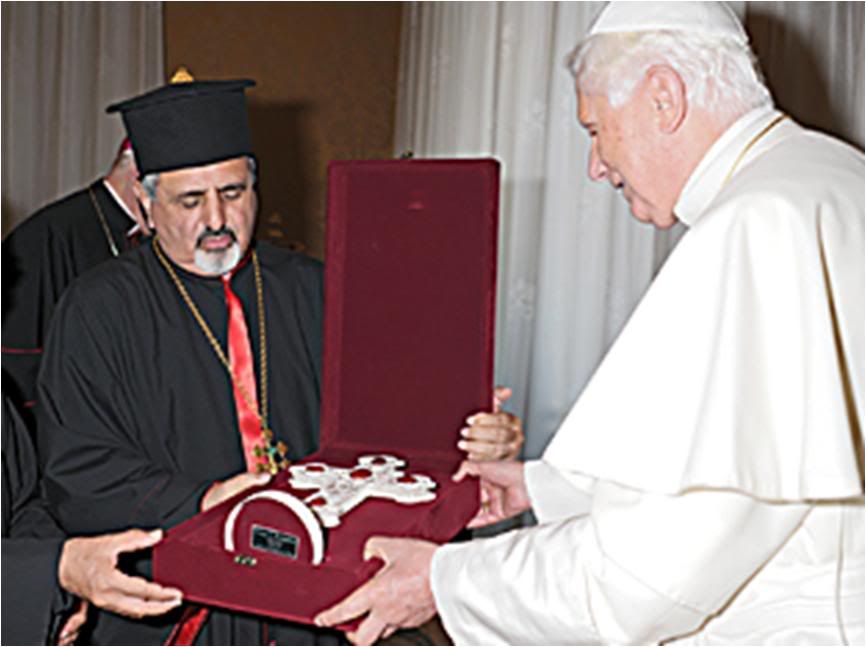
VATICAN CITY, 19 JUN 2009 (VIS) - In the Vatican this morning, Benedict XVI received His Beatitude Ignace Youssif III Younan, the new Catholic patriarch of Antioch of the Syrians, accompanied by various members of the Synod of that Church.
"Divine Providence", said the Pope in his address, "has made us ministers of Christ and shepherds of His one flock. ... Christ Himself, our Lord, appointed the Apostle Peter as the 'rock' upon which He founded the spiritual edifice of the Church, calling upon His disciples to remain in full unity with Peter, under his sure guidance and that of his Successors".
"Over the course of your millenarian history", he continued, "your communion with the Bishop of Rome has always been accompanied by faithfulness to the spiritual tradition of the Christian East. These are complementary aspects of a single heritage of the faith which your venerable Church professes".
The Pontiff then recalled how, in order to emphasise "the Eucharistic roots" of this communion, he had granted "ecclesiastica communio" to the patriarch when he was elected head of the Synod.
Addressing the patriarch directly, he added: "With a public sign - yesterday's Eucharistic celebration in the basilica of St. Mary Major - you most appropriately demonstrated the close ties binding you to the bishop of Rome and the Universal Church".
Finally the Holy Father expressed his satisfaction at the return to full activity of the Synod of this Church and encouraged "efforts being made to favour unity, understanding and forgiveness, which must always be considered as priorities for the edification of the Church of God".
"I pray continuously, among other things, for peace in the Middle East, especially for Christians living in the blessed land of Iraq, whose sufferings I offer every day to God during the Eucharistic sacrifice".
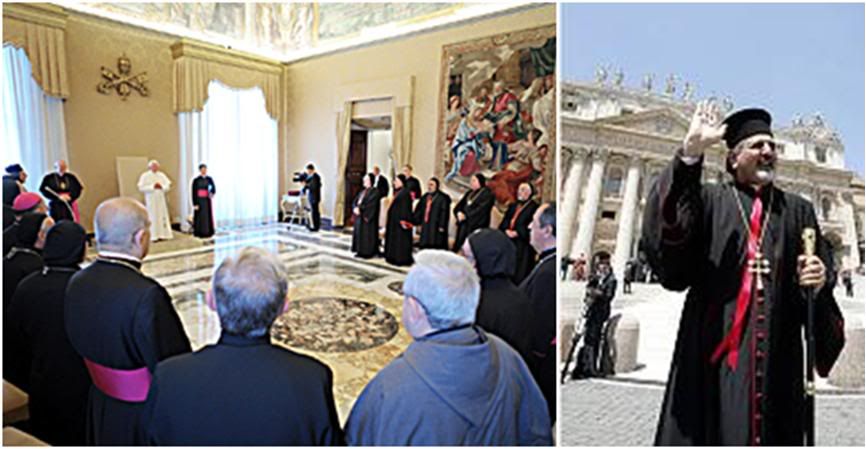 Right photo: The Patriarch and his delegation with the Pope; left photo: The Patriarch at St. Peter's Square before the General Audience last Wednesday.
Right photo: The Patriarch and his delegation with the Pope; left photo: The Patriarch at St. Peter's Square before the General Audience last Wednesday.
6/20/09
I apologize for failing to pay due attention to this story yesterday. The Holy Father's address, which was the main item on Page 1 of the OR today, was delivered in French, so I have to translate that.
Also, I will try to find any photos of the Mass in Santa Maria Maggiore that the Pope refers to. Today's OR carries a number of inside-page articles about the Patriarch's visit, and there's a brief item that the Mass was celebrated according to the Syro-Antiochian rite, with Cardinal Leonardo Sandri, Prefect of the Congregation for Oriental Churches, and Cardinal Bernard Law, Arch-Priest of Santa Maria Maggiore, concelebrating with the Patriarch. The OR today also carries the homily delivered by Cardinal Sandri.
Pope prays every day for peace
in Middle East, Christians in Iraq
By Carol Glatz

VATICAN CITY, June 19 (CNS) -- Pope Benedict XVI said he prays every day for peace in the Middle East and especially for Christians in Iraq.
"I pray constantly for peace in the Middle East, in particular for Christians who live in the beloved Iraqi nation; I present their sufferings to the Lord in the Eucharistic sacrifice every day," the Pope said in an audience with the new head of the Syrian Catholic Church.
Patriarch Ignace Joseph III Younan and members of the synod of the Syrian Catholic Church met with Pope Benedict in a special audience June 19 at the Vatican.
Patriarch Younan was the head of the Newark-based Syrian-rite diocese in the United States and Canada from 1995 until his January election as the new patriarch of Antioch.
The Syrian Catholic Church has archdioceses in Iraq, Syria, Egypt and Sudan. The church includes approximately 200,000 members around the world, including in the Holy Land, Turkey, Venezuela, the United States and Canada.
In his address, Pope Benedict urged members of the Syrian Catholic Church to continue to focus their lives on the Eucharist. It is the bread of life that "nourishes your communities and makes them grow in unity and charity," he said.
He said they should draw strength from the Eucharist so they can "overcome the difficulties that your church has experienced in recent years, and follow the paths of forgiveness, reconciliation and communion."
THE HOLY FATHER'S ADDRESS
Here is a translation of the Holy Father's address to the Patriarch of Antioch of the Syrians and his delegation. It was delivered in French:
Béatitude,
The visit that you are making to Rome to venerate the tombs of tHE Apostles and meet with the Successor of Peter brings great joy to me. Today, I renew with sincere and fraternal affection the greeting and kiss of peace in Christ that we exchanged at the start of tHE year, after your election as Patriarch of Antioch of the Syrians.
I thank you for the kind words you addressed to me in the name of your patriarchal Church. I also wish to express my acknowledgment to Their Beatitudes Cardinal Ignace Moussa Daoud, emeritus Prefect of the Congregation for Oriental Churches; and Ignace Pierre Abdel Ahad, both emeritus Patriarchs of your Church, as well as to all the members of the Episcopal Synod.
My gratitude comes with prayers particularly for you, Beatitude, as the new Patriarch, as I extend my fraternal solidarity during your first steps in your new ecclesial service.
Beatitude, Divine providence has made us ministers of Christ and Pastors of his one flock. Let us therefore keep the eye of the heart on him, the Supreme Pastor and Bishop of our souls, assured that once we had taken on the episcopal service, he will never abandon us.
It is Christ himself, our Lord, who designated the Apostle Peter as the 'rock' on which would rest the spiritual edifice of the Church, asking his disciples to walk in full unity with him, under his sure guidance and that of his successors.
In the course of your more than a millennium of history, communion with the Bishop of Rome has always gone hand in hand with faithfulness to the spiritual tradition of the Christian Orient, both being complementary aspects of a single patrimony of faith that your venerable Church professes.
Together, we profess the same Catholic faith, uniting our voices to that of the Apostles, martyrs and saints who preceded us, raising to God the Father, in Christ and in the Holy Spirit, a hymn of praise and thanksgiving for the immense richness of this gift which has been entrusted to our fragile hands.
Dear brothers of the Syrian Catholic Church, I thought of you specially during the solemn Eucharistic celebration of the Feast of Corpus Domini. In the homily at the Mass in front of the Basilica of St. John Lateran, I cited the great Doctor of the Church, St. Ephrem the Syrian, who said, "During the Last Supper, Jesus immolated himself; on the Cross, he was immolated for all the rest".
This beautiful observation allowed me to underscore the Eucharistic root of the ecclesiastica communio that I granted to you, Beatitude, after your election by the Synod.
And most opportunely, you have shown a public sign of this close link which unites you to the Bishop of Rome and the universal Church during the Eucharistic sacrifice you celebrated yesterday at the Basilica of Santa Maria Maggiore, with the participation of my specially mandated representative, the Prefect of the Congregation for Oriental Churches, Cardinal Leonardo Sandri.
Indeed, it is the Eucharist that brings together our diverse traditions within the unity of the one Spirit, making of them a treasure for all the people of God.
May the celebration of the Eucharist, source and summit of ecclesial life, keep you anchored within the ancient Syrian tradition which prides itself on keeping the language of the Lord Jesus himself, and at the same time, may it open to you the horizon of ecclesial universality.
May it always make you attentive to what the Spirit suggests to the Church; may it open the eyes of your hearts so that you may scrutinize the signs of the times in the light of the Gospel and that you may know how to comprehend the hopes and expectations of mankind, responding generously to the needs of those who live in the most serious conditions of poverty.
May you draw from the Eucharist, Sacrament of unity and communion, the power to overcome the difficulties that your Church has known in recent years, in order to find once more the paths of forgiveness, reconciliation and communion.
Dear brothers, I thank you once more for your visit which allows me to express to you my profound concern for your ecclesial problems. I greet with satisfaction the full functional recovery of your Synod and I encourage your efforts to promote unity, understanding and forgiveness which you must always consider as priority duties in building up the Church of God.
Moreover, I constantly pray for peace in the Middle East, particularly for the Christians who live in the beloved nation of Iraq, whose sufferings I commend daily to the Lord during the Eucharistic sacrifice.
Finally I wish to share with you one of my major concerns: the spiritual life of priests. Precisely today, on the Solemnity of the Sacred Heart of Jesus, day of priestly sanctification, I will have the immense joy of opening the Year for Priests, to commemorate the 150th anniversary of the death of the Holy Curate of Ars.
I think that this special jubilee year, which starts just as the Pauline Year is coming to a close, will be a fecund opportunity for the whole Church.
On Calvary, Mary was with the Apostle John at the foot of the Cross.
Today, we too spiritually come to the foot of the Cross, with all our priests, to look towards Him who was pierced on the side and from whom we receive the fullness of all grace.
May Mary, Queen of the Apostles adn Mother of the Church, watch over you, Beatitude, over the Synod, and over the entire Syrian Catholic Church.
I assure you that my prayers go with you and I impart the Apostolic Blessing, which I extend to all the faithful of your venerable Church throughout the world.
Today's OR also had a separate news item on the words that Patriarch Ignace addressed to the Pope:
'Justice and respect
for the rights of all men'
Translated from
the 6/20/09 issue of

"We have come to Rome to greet you as the Successor of Peter and to live a moment that is very significant in the tradition of the universal Church - that of exchanging ecclesial communion between our two Apostolic Sees, that of Rome which 'presides in charity' (St. Ignatius of Antioch) and that of Antioch where the disciples of Christ were first called 'Christians'."
With these words, Patriarch Ignace Youssef III Younan addressed Benedict XVI at the start of their meeting at the Apostolic Palace on Friday morning.
"Yesterday," he recalled, "on the day dedicated to the memory of St. Ephrem of Syria, patron of our Church, who was called 'the harp of teh Holy Spirit', we experienced with joy and profound gratitude, the sacramental expression of this communion, in concelebrating the Divine Liturgy according to the Syriac rite of Antioch, with your representative, Cardinal Leonardo Sandri, Prefect of the Congregation for Oriental Churches."
The Patriarch then referred to the first ordinary synod that took place after he was elected to the Patriarchal See of Antioch.
"In this synod," he said, "thanks to your prayers and your paternal guidance, we committed ourselves to episcopal collegiality in a spirit of fraternal communion, as we took on our responsibilities as pastors of our beloved Church."
He also referred to the Pontiff's recent pilgrimage to the Holy Land during which, he said, Benedict XVI "conveyed a message of peace, tolerance, and reconciliation to all the communities of the region that has been torn apart and divided by unjust conflicts without end."
"Holiness," he added, "you are well aware of the nature and reasons for our concerns, as those of other Christian communities in the Middle East. Our calling is to be witnesses for God, who is good and merciful towards all men, by living his message of love. We have come to draw courage from you, Holiness, so that we may remain faithful to our pluri-century mission."
He said the Church of Antioch of the Syrians would continue to pray so that the Pope "may be able to convince the powerful of the earth to work for peace based on justice and the respect of fundamental human rights in all the countries of the world, but in particular, in some countries of the Middle East, like Iraq, Lebanon and Palestine".
His Beatitude recalled the words said by Benedict XVI at the Greek Melkite church in Amman "which expressed with unequivocal clarity and great affection your paternal concern for the Christian communities and Oriental Churches of apostolic origin".
He quoted the Pope: "The ancient living treasure of the traditions of the Oriental Churches enrich the universal Church and should never be understood merely as an object to preserve passively."
He thanked the Pope "who does not cease to encourage us to bear witness to our faith, witn fidelity to our centuries-old traditions that go back to the first communities of the Church, while living the words of the Gospel in our respective fields."
He noted the happy coincidence of their meeting with the Pope and the start of the Year for Priests, and ended by vowing "faithfulness and unshakable attachment to the Chair of Peter".
[Modificato da TERESA BENEDETTA 20/06/2009 22:03] |
| |
 20/06/2009 06:11 20/06/2009 06:11 |
|
| | | OFFLINE | | Post: 17.753
Post: 425 | Registrato il: 28/08/2005
Registrato il: 20/01/2009 | Administratore | Utente Senior | |
|

 VESPERS AND OPENING
VESPERS AND OPENING
OF THE YEAR FOR PRIESTS
ON THE SOLEMNITY OF
THE MOST SACRED HEART OF JESUS
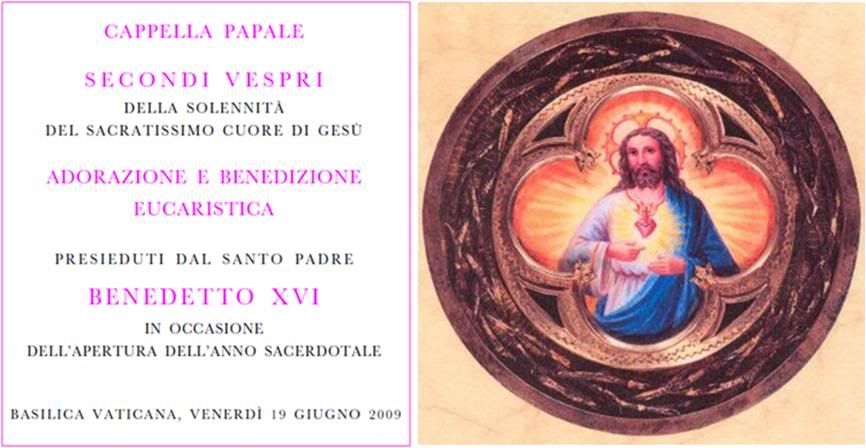 Here is a translation of the Holy Father's homily at the Vespers celebration tonight
Here is a translation of the Holy Father's homily at the Vespers celebration tonight:
Dear brothers and sisters:
In the antiphon to the Magnificat, we shall shortly sing: "The Lord has welcomed us in his heart - Suscepit nos Dominus in sinum et cor suum".
In the Old Testament, there are 26 references to the heart of God, considered as the organ of his will: Man is judged through the heart of God.
Because of the pain that his heart bears for the sins of men, God decided to send the deluge, but he was moved by the evidence of human weakness and forgave.
Then there is an Old Testament passage in which the subject of God's heart is expressed in absolutely clear terms. It comes in Chapter 11 of the Book of the prophet Hosea, where the first verses describe the dimension of the love with which the Lord addressed to Israel at the dawn of her history: "When Israel was a child I loved him, out of Egypt I called my son" (v. 1).
In fact, Israel responded to God's tireless favor with indifference and even outright ingratitude: "The more I called them," God said, "the farther they went from me" (v. 2).
Nonetheless, he never abandoned Israel to the hands of the enemy, because, as Verse 8 says: "My heart is overwhelmed, my pity is stirred" - so says the Creator of the Universe.
God's heart stirs with compassion!
In today's Solemnity of the Most Sacred Heart of Jesus, the Church offers this mystery for our contemplation, the heart of a God who is moved and who pours forth all of his love on mankind. It is a mysterious love, which in the texts of the New Testament, is revealed to us as God's incommensurable love for man.
He does not give up in the face of ingratitude, not even to rejection by the people he had chosen. Rather, with infinite mercy, he sent the world his only Son to take upon himself the ultimate outcome of a love that had been destroyed - so that by defeating the power of evil and death, he could restore to human beings who had become slaves to sin the dignity of being God's children.
All of this at a dear price: the Father's only Son immolated himself on the Cross: "He loved his own in the world and he loved them to the end" (cfr Jn 13,1).
The symbol of such love that goes beyond death is his side ripped open by a lance. About this, an eyewitness, the apostle John, says: "One soldier thrust his lance into his side, and immediately blood and water flowed out" (cfr Jn 19,34).
Dear brothers and sisters, thank you for responding to my invitation and coming here in numbers to this celebration with which we begin the Year for Priests.
I greet the Cardinals and Bishops, particularly the Cardinal Prefect and the Secretary of the Congregation for the Clergy and their co-workers, as well as the Bishop of Ars.
I greet the priests and seminarians of the various colleges and seminaries in Rome, the religious men and women of the various orders, and all the faithful.
I address a special greeting to His Beatitude Ignace Youssef Younan, Patriarch of Antioch of the Syrians, who came to Rome to meet me and to publicly manifest the "ecclesiastica communio" that I have granted him.
Dear brothers and sisters, let us pause together to contemplate the pierced Heart of the Crucified Lord. We heard once more, earlier, in the brief reading taken from the Letter of St. Paul to the Ephesians, that "God, who is rich in mercy, because of the great love he had for us, even when we were dead in our transgressions, brought us to life with Christ... raised us up with him, and seated us with him in the heavens in Christ Jesus" (Eph 2,4-6).
To be with Jesus Christ is already to sit in heaven. The essential nucleus of Christianity is expressed in the Heart of Jesus. All of the revolutionary novelty in the New Testament was revealed and given in Christ - the Love which saves us and makes us live in the eternity of God.
The evangelist John writes; "For God so loved the world that he gave his only Son, so that everyone who believes in him might not perish but might have eternal life" (3,16).
His divine Heart calls out to our hearts. It invites us to get out of ourselves, to abandon our human certainties in order to trust in him, and, following his example, to make of ourselves a gift of love without reservations.
If it is true that Jesus's invitation to 'remain in his love' (cfr Jn 15,9), is intended for everyone who has been baptized, then on the feast of the Sacred Heart of Jesus, which is also the World Day for Priestly Sanctification, this invitation resounds with greater power for us priests, particularly this evening, the solemn beginning of teh Year for Priests, which I have declared on the occasion of the 150th death anniversary of the Holy Curate of Ars.
A beautiful and moving statement from him immediately comes to my mind, which was cited in the Catechism of the Catholic Church: "Priesthood is love for the Heart of Jesus" (No. 1589).
How can we not remember with emotion that the gift of our priestly ministry comes directly from this Heart? How can we forget that we priests were consecrated in order to serve - humbly and authoritatively - the common priesthood of the faithful?
Ours is an indispensable mission for the Church and for the world, which demands full faithfulness to Christ and incessant union with Him. It demands, therefore, that we constantly aim towards holiness as St. Jean-Marie Vianney did.
In the Letter I addressed to you for this special jubilee year, dear brother priests, I wished to highlight certain qualifying aspects of our ministry, with many references to the example and teaching of the Holy Curate of Ars, model and protector of all priests, and, particularly, of parish priests.
May this letter help and encourage you to make this year a propitious occasion to grow in intimacy with Christ, who counts on us, his ministers, to extend and consolidate his Kingdom, to spread his love, his truth.
Thus, "in the footsteps of the Holy Curate of Ars", my Letter concluded, "let yourselves be enthralled by Christ. In this way you too will be, for the world in our time, heralds of hope, reconciliation and peace!"
This was the purpose of the life of St. Paul, to whom we have devoted our attention during the Pauline year which is now coming to a close. This was the goal of the entire ministry of the Holy Curate of Ars whom we invoke especially during the Year for Priests. Let this be also the principal objective for each of us.
To be ministers in the service of the Gospel, study is certainly useful and necessary, along with careful and continuing pastoral formation, but still more necessary is that 'science of love' which can only be learned in a 'heart to heart' with Christ.
Indeed, it is he who calls us to break the bread of his love, to remit sins and lead the flock in his name. Because of this, we should never stray far from the spring of Love which is his heart that was pierced on the Cross.
Only then will we be able to cooperate effectively in the mysterious 'plan of the Father' which consists in "making Christ the heart of the world". A plan that is realized in history to the degree that Christ becomes the Heart of human hearts, starting with those who are called to be closest to him, namely, priests.
Recalling this commitment constantly to us are the priestly vows which we pronounced on the day of our ordination and which we renew each year, at the Chrismal Mass on Maundy Thursday.
Even our shortcomings, our limitations and our weaknesses should lead us back to the Heart of Christ. If indeed it is true that sinners, contemplating him, should learn the necessary 'sorrow for our sins' which leads them back to the Father, this is even more true for his holy ministers.
In this regard, how can we forget that nothing can make the Church - Body of Christ - suffer as much as the sins of its pastors, especially of those who become 'robbers of lambs' (Jn 10,1 ff), or who deviate from the Church with their own private doctrines, or who ensnare the Church in sin and death?
Dear priests, the call to conversion and recourse to Divine Mercy also applies to us. Likewise, we must address with humility an incessant invocation to the Heart of Jesus to preserve us from the terrible risk of harming those whom we are bound to save.
Just now, I was able to venerate at the Choir Chapel a relic of the Holy Curate of Ars - his heart. A heart that was inflamed with divine love, that was moved at the very thought of the dignity of priests, and spoke to the faithful in sublime and touching tones, saying that "After God, the priest is everything!... Only in heaven will he fully realize what he is" (Letter for the Year of Priests, p. 2).
Dear brothers, let us cultivate the same sentiment, whether it is in carrying out our ministry with generosity and dedication, or to guard in our hearts a true 'fear of God' - the fear that through our negligence or fault, we may be depriving the souls entrusted to our care of so much good, or, God forbid!, of harming them.
The Church needs holy priests, ministers who can help the faithful to experience the merciful love of the Lord and of whom they are convinced and convincing witnesses.
In the Eucharistic Adoration, which will follow the celebration of Vespers, let us ask the Lord to inflame the hearts of each priest with that 'pastoral charity' that is able to assimilate the personal 'I' into that of Jesus the High Priest, in order to be able to imitate him in complete self-giving.
May the Virgin Mary obtain this grace for us, she whose Immaculate Heart we shall contemplate tomorrow in great faith. The Holy Curate of Ars had a filial devotion to her, such that in 1836, anticipating before its time the dogma of the Immaculate Conception [proclaimed in 1854, five years after his death] he consecrated his parish to Mary 'conceived without sin'.
He kept up the practice of frequently renewing the offering of his parish to the Blessed Virgin, teaching the faithful that "it was enough to address her in order to be heard" for the simple reason that she "wants above all to see us happy".
May the Blessed Virgin, our Mother, be with us during the Year of Priests that we begin today, so that we may be firm and enlightened guides for the faithful whom the Lord entrusts to our pastoral care. Amen.
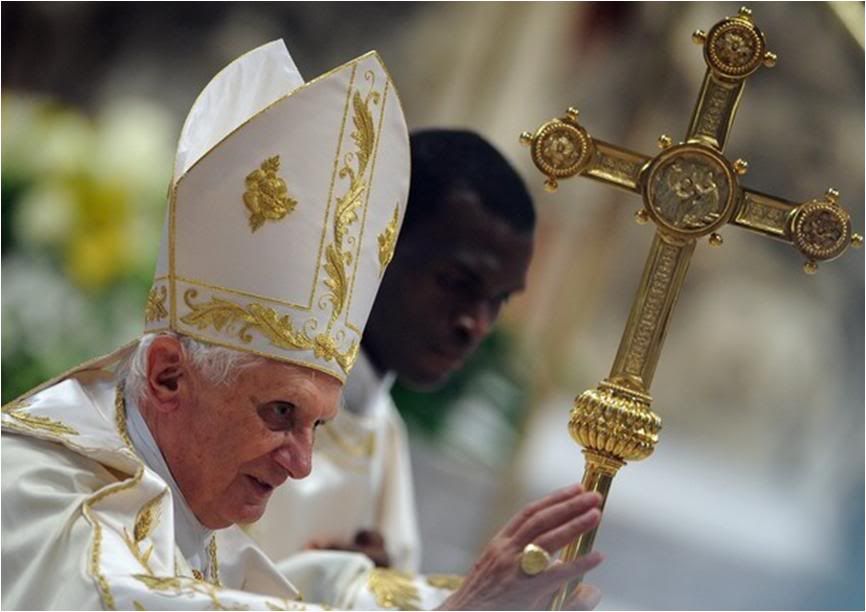
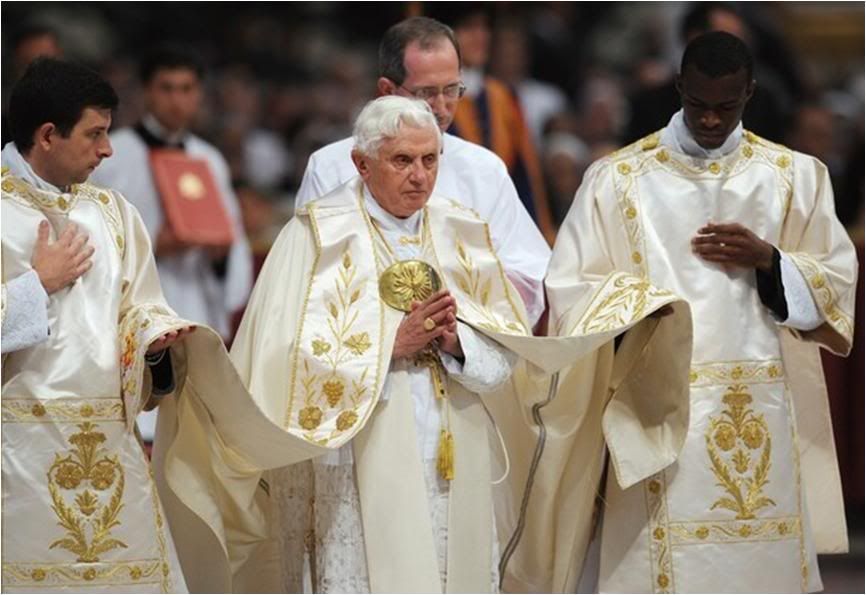
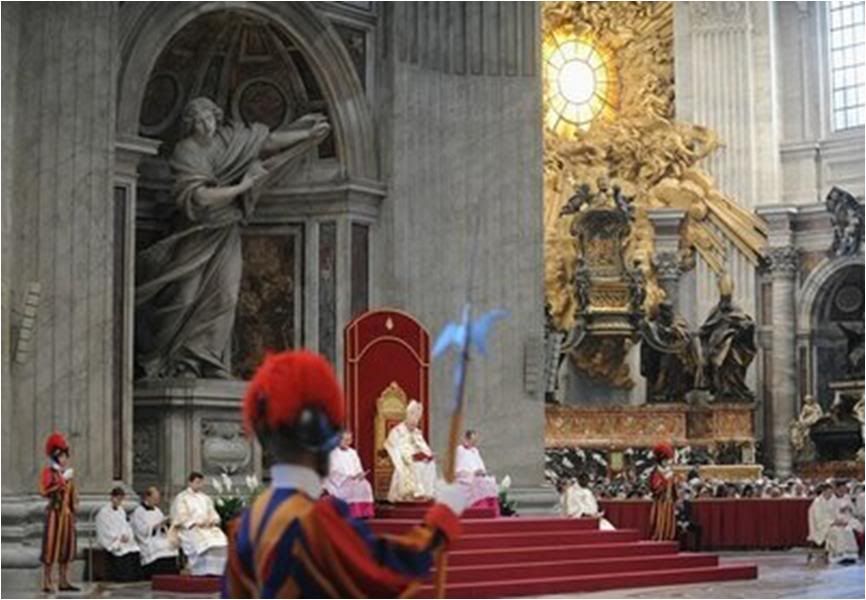
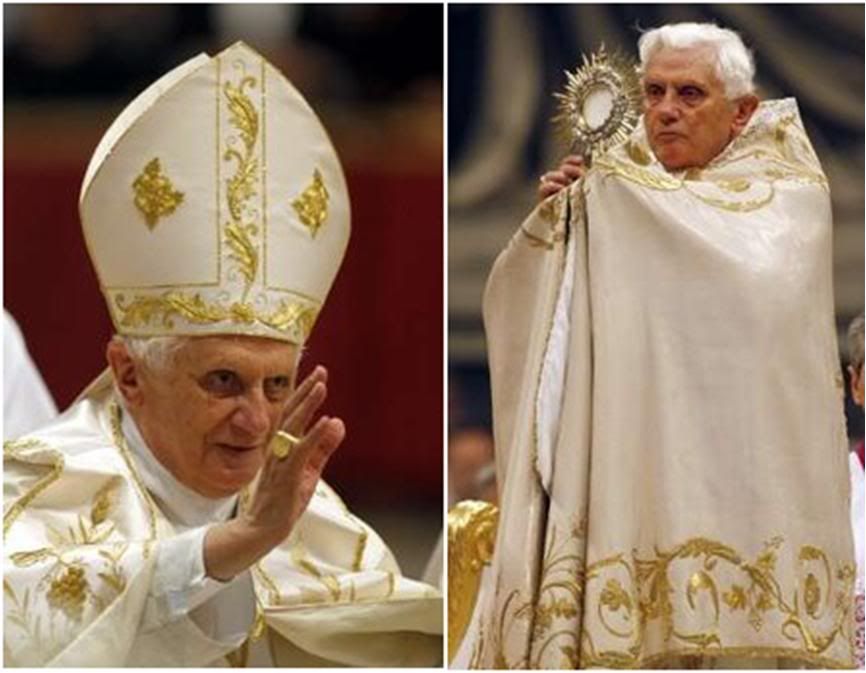
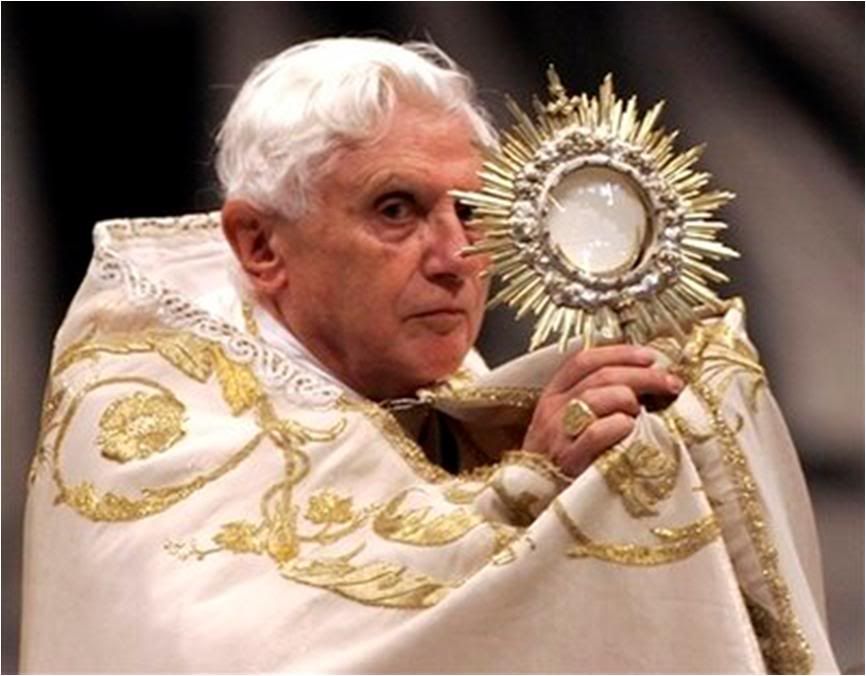
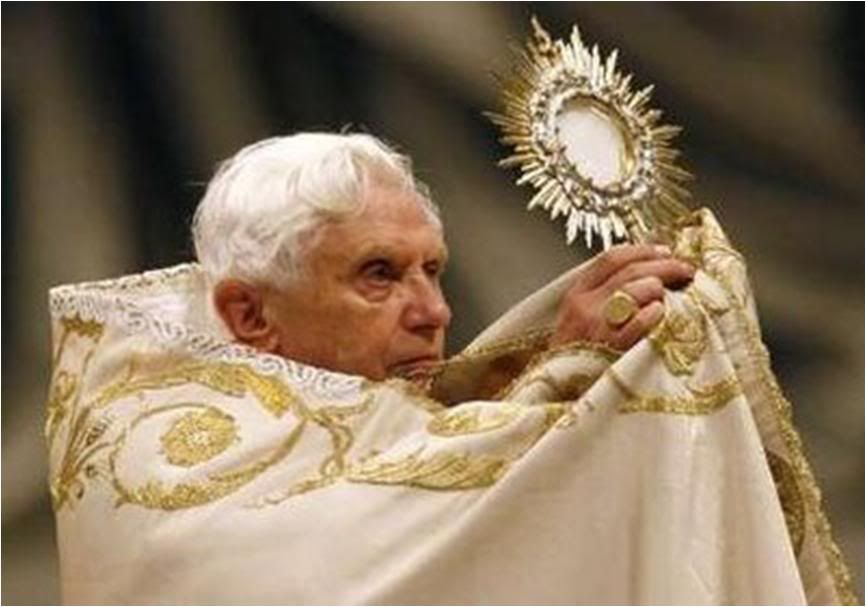
 I had been wondering how the Holy Father would frame his homily for the formal opening of the Year for Priests, after the exquisite hymn to priesthood that he composed from the life and teachings of the Cure of Ars in his Letter to all the Priests of the World.
I had been wondering how the Holy Father would frame his homily for the formal opening of the Year for Priests, after the exquisite hymn to priesthood that he composed from the life and teachings of the Cure of Ars in his Letter to all the Priests of the World.
And, of course, as it is the Feast of the Sacred Heart, the perfect epigraph for tonight's homily was St. Jean Marie Vianney's own line, "Priesthood is love of the Heart of Jesus", highlighted in the poster for the occasion prepared by the Congregation for the Clergy.
As I listened to the homily today on Vatican Radio - while watching the picture on EWTN, where the Holy Father's voice was almost turned down completely to accommodate the translator's voice - it struck me that besides the content, structure and style of Benedictian homilies (I saw an Italian website today that uses the adjective 'benedettiano', Benedictian, to describe things associated with B16, as opposed to 'benedettino', Benedictine, which has become exclusively an attribution to St. Benedict, so I am going to start using the adjective 'Benedictian' for B16), other priests could and should learn from the gentle but uncompromising way in which he 'denounces' or 'deplores' bad things. In this case, all the sins and shortcomings to which every priest is liable.
He shows how it is possible to excoriate evil firmly without thundering down fire and brimstone as old-fashioned preachers did, while tempering it all with the charity of divine mercy.
And it is a continuing wonder how many ways he finds to restate his ideas freshly, whether it has to do with the essentials of the faith or more specific things, as in this case, the failings of priests.
BENEDICTUS QUI VENIT IN NOMINE DOMINI!
[Modificato da TERESA BENEDETTA 22/06/2009 02:40] |
| |
 20/06/2009 13:53 20/06/2009 13:53 |
|
| | | OFFLINE | | Post: 17.754
Post: 426 | Registrato il: 28/08/2005
Registrato il: 20/01/2009 | Administratore | Utente Senior | |
|
|
| |
 20/06/2009 14:36 20/06/2009 14:36 |
|
| | | OFFLINE | | Post: 17.755
Post: 427 | Registrato il: 28/08/2005
Registrato il: 20/01/2009 | Administratore | Utente Senior | |
|


June 20
 St. Paolino of Nola (Italy, 364-431)
St. Paolino of Nola (Italy, 364-431)
Bishop
Friend of Sts. Augustine and Ambrose
OR today.
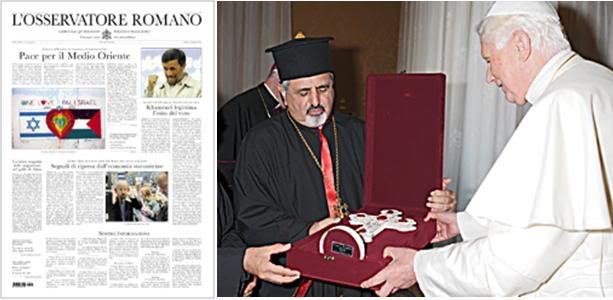
Benedict XVI to the Patriarch of Antioch of the Syrians:
'Peace for the Middle East'
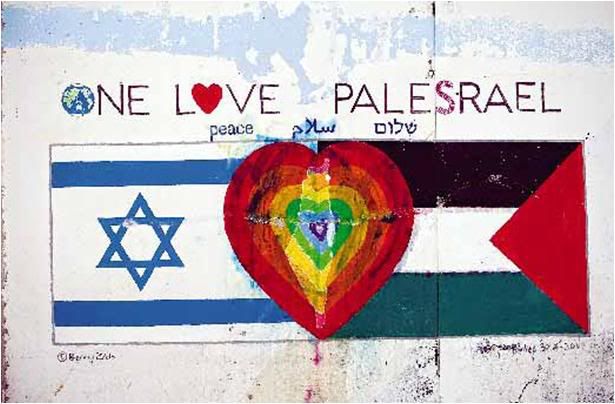 Graffiti on the security wall between Israel and the West Bank.
Other Page 1 stories: Iran's Supreme Leader legitimizes Ahmadinejad victory in the presidential elections;
Graffiti on the security wall between Israel and the West Bank.
Other Page 1 stories: Iran's Supreme Leader legitimizes Ahmadinejad victory in the presidential elections;
and signs of economic recovery in the United States [Is this another case of the OR editor's bias?]
THE POPE'S DAY
The Holy Father met today with
- Cardinal Giovanni Battista Re, Prefect of the Congregation for Bishops (weekly meeting)
- Cardinal Ivan Dias, Prefect of the Congregation for the Evangelization of Peoples.
- Members of the council of the Fondazione Alcide De Gasperi. Address in Italian.
PAPAL ENVOYS TO PAULINE SITES
FOR CONCLUDING RITES OF THE PAULINE YEAR

The Vatican today released the names of the cardinals who have been named by Benedict XVI to represent him
at the concluding ceremonies of the Pauline Year in the sites associated with St. Paul:
- Cardinal Walter Kasper, president of the Pontifical Council for Promoting Christian Unity, to the Holy Land
- Cardinal Ennio Antonelli, President of the Pontifical Council for the Family, to Malta
- Cardinal Raffaele Martino, President of the Pontifical Council for Justice and Peace, to Cyprus
- Cardinal Jean-Louis Tauran, President of the Pontifical Council for Inter-Religious Dialog, to Turkey
- Cardinal Jozef Tomko, emeritus President of the Pontifical Council for the Evangelization of Peoples, to Greece
- Cardinal Antonio Rouco Varela, Archbishop of Madrid, to Syria
- Cardinal Andre Vingt-Trois, Archbishop of Paris, to Lebanon
[Modificato da TERESA BENEDETTA 20/06/2009 14:48] |
| |
 20/06/2009 16:08 20/06/2009 16:08 |
|
| | | OFFLINE | | Post: 17.756
Post: 428 | Registrato il: 28/08/2005
Registrato il: 20/01/2009 | Administratore | Utente Senior | |
|

 A late-breaking story yesterday that I failed to post.
Vatican rejects pressure
A late-breaking story yesterday that I failed to post.
Vatican rejects pressure
on Pius XII beatification
By Phil Stewart

VATICAN CITY, June 19 (Reuters) – Pope Benedict must be left alone to decide on whether to promote Pope Pius XII to sainthood, the Vatican said on Friday, rejecting apparent pressure from within the Church to move ahead.
Pope Pius XII has been accused by some Jews of turning a blind eye to the Holocaust during World War Two, a charge his supporters and the Vatican deny.
The Vatican issued an unusually strong statement hours after Italian media quoted Rev. Peter Gumpel, the chief Vatican judge investigating Pius' sainthood cause, as suggesting Benedict had not yet acted out of fear it would harm relations with Jews.
[Fr. Gumpel is the chief postulator for Pius XII's beatification cause, not a Vatican judge. He is therefore in charge of promoting the cause and putting together all the requirements called for by the Congregation for the Causes of Sainthood.]
The Vatican, citing news reports, said the Pope's decision on whether to sign beatification decrees "is the exclusive competence of the Pope, who should be left completely free in his evaluations and decisions".
"If the Pope thinks that study and reflection on Pius XII's cause should be further extended, his position must be respected without interference or unjustified and inopportune declarations," the Vatican's press office said.
Some say Pius did not do enough to save Jews. The Vatican and his Jewish defenders say he worked behind the scenes to help because direct intervention would have worsened the situation.
The Vatican's saint-making department in 2007 voted in favor of a decree recognizing Pius' "heroic virtues", a step in a long process toward possible sainthood that began in 1967.
Benedict has so far not approved the decree -- which is needed for beatification, the last step before sainthood -- opting for what the Vatican has called a period of reflection.
Gumpel, a major proponent of sainthood for Pius, said Benedict had been 'struck' by some recent meetings with Jewish organizations.
[Stewart is translating the word Gumpel used, 'impressionato', as 'struck', when Gumpel used it in the sense of 'paid attention'. However, the Italian news agency Apcom headlined its story "Pius XII's postulator for beatification: 'Jews are blackmailing the Pope'" - although in the story itself, Gumpel never used that term. I believe it was the use of that term that prompted Fr. Lombardi to issue a response promptly.]
"(Jewish groups) told him loudly and clearly that if he did anything in favor of Pope (Pius), relations between the Catholic Church and Jews would be definitively and permanently compromised," Gumpel was quoted as saying by ANSA news agency.
Jewish groups have asked the Vatican to freeze the procedure that can lead to his sainthood pending more study of wartime records.
Pius is one of several issues that have strained Catholic-Jewish relations. Benedict's decision to readmit to the Church a bishop who denied the extent of the Holocaust in January also strained ties.
In fairness to Fr. Gumpel - who does have a history of making impulsive statements that he needs to clarify later - even the Apcom story with the outrageous headline was mainly positive, and leads off by him saying Pope Benedict has a great admiration for Pius XII and what he did for the Jews, and that he has "absolutely nothing against the cause for beatification".
He was speaking at a roundtable discussion on Pius XII held yesterday at the headquarters of the Congregation for the Evangelization of Peoples. He made the controvesial statement while pointing out that not all Jews are against the beatification, especially as more historical material is coming to light about Pius XII's wartime record. He does add this is reason for the Vatican to move ahead with the beatification process.
The rest of the material quoted from Gumpel is an informative summation of the status of Pius XII's cause in the Congregation for the Causes of Sainthood. It deserves a full translation if only for this - and I hope to do it.
Further, Vatican Radio said in a report on its Italian service today that Fr. Gumpel has said his statement was misrepresented to the point that "it does not sound like me".
Perhaps, Fr. Lombardi should have given Fr. Gumpel a quick call first - they are both Jesuits after all. In any case, his statement was necessary because the distorted headline was already out there.
The following interview by Michael Paulson of the Boston Globe is about Jewish-Catholic relations in general, including the Pius XII controversy, but I would like to rearrange the print order to call attention first to what the Israeli ambassador to the Holy See had to say about Pope Benedict XVI and his recent pilgrimage to the Holy Land. He also has surprising things to say about the case of Pius XII which are not the usual party line.
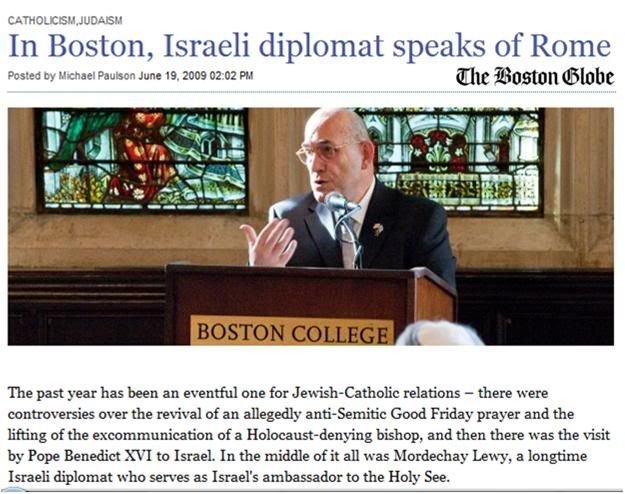
Lewy, who previously represented Israel in Germany, Sweden and Thailand, visited Boston this week, primarily to speak at a conference at Boston College, and I spoke with him Friday morning at his hotel in Newton.
Here are edited excerpts of our conversation:
What is your assessment of the Pope's visit?
The visit was a success. No doubt.
There was some criticism of the way he characterized the Holocaust.
People who were expressing those disappointments, which to my mind were unjustified, were on second or third thought retracting them. It didn't cast a real shadow on the visit. It was filling the columns in the press for one or two days.
The speeches of the Pope were of enormous importance to everybody, not only to us, but to everybody. What he contributed at Yad Vashem was a completely different approach which was an enrichment to the culture of memory, and it was almost a wake-up from an unexpected corner for people to think a little bit differently, and not to expect a ritual.
This Pope is not one who is getting into existing patterns of rituals – it's not a challenge for him intellectually – so he would like really to set his mind and contribute his own thoughts, which are rather deep thoughts about what Yad Vashem means.
This Pope…didn’t come as a German pope, and this was a second misreading of him – I never saw him as a German Pope, although we communicate in German with each other. He wasn't elected as a German pope, and he doesn't see himself as a German pope, no matter what the Germans say.
So it's more through the head, the theological mind… He's not a newcomer to sort out what kind of approach Catholics should have toward Judaism as a result of the Second Vatican Council. He has contributed a lot, and we have a friend in him. This is often misunderstood, because he's a conservative.
He is an example that you can be a conservative in terms of theological approaches, (and) also in terms of what he calls the hermeneutic of continuity after the Second Vatican Council, and then, all of a sudden, still be very friendly to Jews.
This is a little bit surprising for many liberals within the Catholic Church who feel very much frustrated and think that the main prerequisite of this liberal spirit is their approach to Judaism. We need to work a lot to make them understand that continuity doesn’t mean necessarily to have anti-Jewish approach.
Why do relations with the Vatican matter?
We cannot afford, as a Jewish state, and we cannot afford as a Jewish people, to continue on after 1,900 years of bad experience, traumatic experience with the Christian world. Now, if we take the Christian world as a whole, it's quite an amorphous body.
But at least if we have a well-known structure, as the Catholic Church, with a top echelon of it in Vatican, I think that would be a missed opportunity not to get along with them as much as we can, knowing that we will not ever be able to come to terms on all aspects the questions which lie between us.
You've been at the Vatican for a year. What have you learned?
From the books you can see that it is an absolute monarchy, but it is not. Far, far from that.
Structural absolute monarchy doesn't mean that the monarch is trying to exercise, on an everyday basis, his authority. You are reducing your authority if you are using it too often.
In military terms, if you have a power of deterrence, keep the power, don't use it, because after using it, everybody will know what you are worth. You can also (apply that) with authority. If you are really applying it all the time, you are likely to get a lot of frictions, and by that you are losing at least a degree of the authority you had at the beginning.
And I think the Pope is very well aware of that.
What do you actually do on a day to day basis?
(Laughs) Try to convince Jews that the menorah is not any more in the cellar of the Vatican Museum. I'm not joking. I've had very many requests of that kind. To intervene, to find it, and to bring it back in a diplomatic pouch.
There is a legend that says the menorah from the Second Temple, after the destruction, was the war booty of Titus, brought to Rome, was shown where war victories were shown, in a temple of peace. It's shown in the Arch of Titus.
What else?
AThere are a lot of issues between the Vatican and Israel where the Vatican is coming to us. Often I am a go between, as many ambassadors are. Most of the requests are in the realm of the broad concept of religious freedom, which Israelis subscribe to, but theory is one thing, and another thing is how to implement it.
Visa issues are a very serious problem, and I cannot say we are solving the problem, but we are alleviating it. It is one thing to come to Israel as a tourist, it's not a problem at all, but another thing is if a clergyman would like to stay more than three months.
And if a Syrian Catholic would like to come, or is invited by his Church, to assume a priestly post in Jerusalem, he has Syrian documents, he will be not admitted - as long as Syria is defined as enemy country, he will not be able, in spite of the fact that there is religious freedom.
So this is a problem which we have to see how we can alleviate it.
Does Israel have an interest in preserving a Christian population?
It's not a question. We are obliged to. To be a holy land is not only a blessing, it's a burden. And if you are saying 'holy to three monotheistic religions,' it's an obligation to make it happen, or to preserve it as it is, but not to work against it.
What about the controversy over the Catholic Church's relationship with the Society of Saint Pius X?
This is a very, very severe problem. Matters of excommunication are not our problem – we should not interfere. But if these internal matters are affecting the public sphere, to the extent that they affect our own attitudes and emotions… Williamson's reconciliation, without the Holocaust denial, would not have made this affair sexy to everyone.
The Holocaust denying was the point which brought the whole Jewish interference, which was not into the internal matters of the church but to the Holocaust denying…This was a rare case where he (the Pope) admitted mishaps in the church.
Is this issue over?
No. It's not over when it comes to the effort of bringing them (the Lefebvrites) back to the Church. I don’t think that many of them would like to go back. They are likely to become a daily provocation, or an embarrassment at least. They are going to consecrate new priests. They are conducting negotiations, but they seem not to want any results.
[I find it troubling that the ambassador should speak of the 'Lefebvrites' as though they were all like Williamson! His statements about them are obcviously based on the general impression resulting from media reports about them.]
But this affair was for us, at least in one sense, productive. It was clearly said by the Church that no Holocaust denier can assume any function as bishop…Now the parameters are clear. We got the clarification which we needed, because they are going to embarrass the Church indefinitely, to my mind, because they don’t want to go back, some of them. This is my read. {See, he talks as though everyone in the FSSPX is a Holocaus8 denier!]
Does Israel have a role to play in the canonization of Pius XII?
Canonization is not our concern. We don’t believe in beatification. What concerns us is the historical role of Pius XII. This is a real issue which has been, to my mind, deliberately, but still mistakenly, combined with the matter.
Do you have a position on Pius XII's historic role?
Historically speaking, I think he was neither a hero nor a villain. It is probably the right thing to think of a more balanced view of him. The problem is that we are looking at him through the filter of a post-conciliar church. He is definitely a protagonist of the pre-conciliar church, and the pre-conciliar church has, as its main assignment, to seek all possible means to salvation for its own flock.
He is not a Pope for the Jews; he is not a Pope for the Mohammedans; he is not a Pope for everyone who was not Catholic. 'My main task is to save the souls of the Catholic Church.' This is why he did a concordat with the Germans. [A historical correction here: Pius XII negotiated the Concordat for Pius XI as Secretary of State.]
He didn't make a concordat because he was Hitler's Pope. This is a mistaken concept. He did it in order to survive, to make it happen that the Church can survive a godless regime. This was the term that they used. He tried also to make a concordat with the Soviet Union, but the Russian Orthodox Church didn't like this idea. It is wrong to look for any affinity between him and the Nazis.
It is also wrong to say that he didn’t save Jews. Everybody who knows the history of those who were saved among Roman Jewry knows that they hid in the Church, they hid in Roman monasteries, in the Vatican itself people were hidden. To look for written evidence, an order of the Pope, well…this is odd. This is not how it works.
So I hear you explaining why he was not a villain. Why was he not a hero?
He was very, very timid. He was a diplomat. This is why the Xuria is very much advocating for him as a saint. He was brought up politically by Benedict XV, who was the protagonist of neutrality during the First World War, wanting to keep up relations with everyone in order to get involved in mediation, humanitarian aid, good things.
This is the concept with which Pius XII, as a pupil of Benedict XV, approached the Second World War. He misread, completely, the situation. He cannot be blamed for it. He was who he was, with shortcomings. To be neutral meant for him to be quiet, to rely on quiet diplomacy.
The main argument is why he was silent, not why he didn't help. And by the way, after the war, he was silent as well. If we take the whole tenure, before the war and after the war, he was silent all the time. He never spoke up. He was saying… the Church was a victim of those regimes. With that mindset, there's not much space to have a place to have another victim, if you feel yourself a victim. And, by the way, that's our problem in the Middle East.
[It is surprising that the Jew Lewy appears to be clearer about the the fact that one need not be a hero to be a saint than the Catholic Paulson who did the interview!
[Modificato da TERESA BENEDETTA 20/06/2009 23:54] |
| |
 20/06/2009 17:35 20/06/2009 17:35 |
|
| | | OFFLINE | | Post: 17.757
Post: 429 | Registrato il: 28/08/2005
Registrato il: 20/01/2009 | Administratore | Utente Senior | |
|
 Chinese ambassador to Italy says
Chinese ambassador to Italy says
'work going on to normalize
relations with the Vatican'
by Salvatore Izzo

VATICAN CITY, June 20 (Translated from AGI) - "Relations between Italy and China have never been better. And work is going on as well to normalize relations with the Vatican", according to the Chinese ambassador to Italy, Sun Yuxi, whop attended a special screening Friday of the docufilm, "Matteo Ricci: A Jesuit in the Kingdom of the Dragon".
Perhaps the most eloquent testimony of progress along that line was his presence at the screening alongside the Pope's private secretary,
Mons. Georg Gaenswein, and Cardinals Ivan Dias, Stanyslaw Rylko and Camillo Ruini.
After the screening, Ambassador Sun said in his remarks that "The Italian and Chinese governments are working on a series of initiatives to spread more information about Fr. Matteo Ricci (1552-1610), a historic personality known to practically all the Chinese, and whom I have studied myself through books and scholarly works. He had a noteworthy influence on initiating relationships between the West and China."
His words were echoed by the host for the event, Archbishop Claudio Maria Celli, president of the Pontifical Council for Social Communications.
Celli called Ricci 'an emblematic figure', saying that the docufilm was "a recognition of Matteo Ricci's cultural contribution. He was the bridge that allowed China to know Europe and vice-versa."
Mons. Claudio Giuliodori, Bishop of Macerata and former spokesman of the Italian bishops conference, read the message sent by Pope Benedict XVI to the Diocese of Macerata last May at the start of the jubilee year 2009-2010 to mark the fourth centenary anniversary of Ricci's death, in which the Pontiff recalled "the farsighted work of inculturating Christianity in China" accomplished by the 18th-century Jesuit )a native of the central eastern Italian region of the Marche) in "constantly seeking contacts with China's scholars".
The Pope said that Ricci possessed 'the innovative and special ability' to approach Chinese cultural and spiritual traditions 'with full respect'. He said that this distinguished Ricci's mission "to harmonize the noble millennial Chinese civilization with the novelty of Christianity, which is a ferment for freedom and authentic renewal within every society" since the Gospel is "a universal message of salvation intended for all mankind, in any cultural or religious context".
For his part, Fr. Federico Lombardi, Vatican press director, said that the jubilee year for his fellow Jesuit "would be an occasion for contacts and deepening of relations between the Catholic Church and Chinese culture".
The 50-minute docufilm by veteran Kosovar director Gjon Kolndrekaj was shot completely in the Italian city of Macerata and in China, with the sponsorship of the Jesuit order and the approval of the Chinese government.
Kolndrekaj said, "I came to learn about Matteo Ricci in 1975 when I travelled to Beijing, after which I decided to dedicate myself to studying this great Italian missionary whom the Chinese call Li Madou. After dedicating years to deepening my knowledge of the three monotheistic religions, it was fascinating for me to consider this Catholic missionary adn Italian scholar who thoroughly engaged Oriental philosophy and thinking. I hope this film will help make him known to the larger public and not only to scholars and historians."
The docufilm is just one of the initiatives promoted by the Jesuits, as well as the Marche Region, the province and city of Macerata, and the University of Macerata, for the fourth centenary jubilee year honoring Ricci.
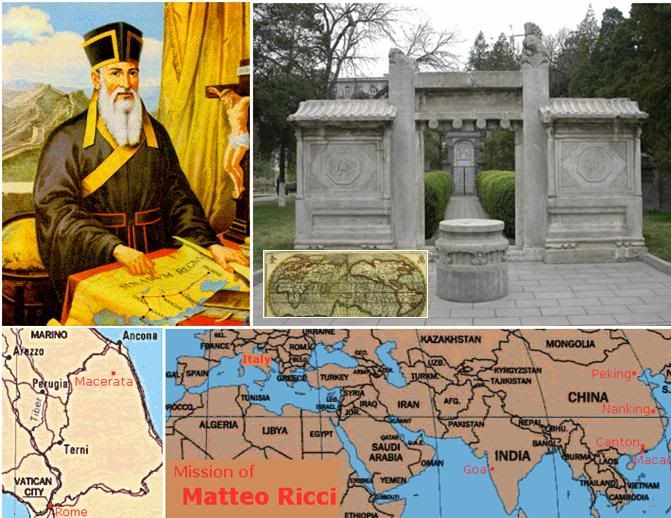 Many portraits exist of Fr. Ricci dressed as a Chinese scholar; upper right photo shows his tomb in Beijing, where
Many portraits exist of Fr. Ricci dressed as a Chinese scholar; upper right photo shows his tomb in Beijing, where
he died; the inset is the map of the world that he drew in 1600.
[Modificato da TERESA BENEDETTA 20/06/2009 17:38] |
| |
 20/06/2009 18:54 20/06/2009 18:54 |
|
| | | OFFLINE | | Post: 17.758
Post: 430 | Registrato il: 28/08/2005
Registrato il: 20/01/2009 | Administratore | Utente Senior | |
|
 The Pope's teaching ministry
The Pope's teaching ministry
finds little echo in the media
By John Thavis

VATICAN CITY, June 20 (CNS) -- News coverage of Pope Benedict XVI tends to leap from big event to big event, so perhaps it's no surprise that after his Holy Land pilgrimage last month the German pontiff has fallen off the mainstream media radar.
To cite a single but typical example, in the month following the Holy Land trip, the New York Times did not report about any of the Pope's activities at the Vatican. Even in Italy, coverage of Pope Benedict has fallen off markedly.
[That's not exactly true. If Thavis ever checks an efficient 'papal news collection' outlet like Lella's blog, it would be abundantly clear to anyone that the Italian news agencies are always prompt in reporting highlights of the Pope's discourses and homilies in separate news bulletins, by topic, almost as soon as he delivers them, and even the major newspapers do report what the Pope says, even if these items are not played up. None of it, of course, gets into the Anglophone media, unless the papal text happens to touch on an international issue or on a buzz topic dear to the media.
In fact, even John Allen, who normally tries to write about everything, has not yet written a single word about the Pope's Letter to Priests, much less the homily, electing to devote his lengthy Friday column yesterday to the post-Notre Shame climate among the US bishops. And his magazine, National [nominally-] Catholic Reporter, has not said a word this week about the Year of Priests either.]
The Pope is likely to step back into the spotlight when he meets with President Barack Obama and when he issues his encyclical on social justice -- two major events expected in the first half of July.
But then the Pope goes on vacation outside of Rome, and re-emerges only at the end of September with a visit to the Czech Republic. He doesn't completely disappear, of course; he continues to give talks and meet with individuals and groups. But the press will take little notice.
The pattern of media attention -- or lack of it -- has led some Vatican officials to privately lament what they see as a paradox of Pope Benedict's pontificate: the Pope's primary focus and greatest talent is teaching, they say, but it's the kind of teaching that rarely breaks into the news cycle.
"You don't get soundbites from this Pope, and that is a challenge to journalists. Another challenge is that he often speaks a language that presupposes faith," said one senior Vatican official.
[On the contrary. There generally are too many possible 'soundbites' for whoever wants to use them. Proof of this, as mentioned above, are the 'theme' bulletins that the Italian news agencies file almost in real time on almost every Papal discourse or text.
His Letter to the Priests, for instance, or his Vespers homily yesterday, constituted a collection of potential headlines if only for what he said about the proper conduct of priests, especially in relation to those who are entrusted to their care.
One would think that, given their obsession with sexual offenses by priests, the Western media would report the Pope's clear and firm but compassionate exhortations for priests to live up to their vows, but outside of Thavis himself - who writes for a Catholic news agency, none of the Anglophone news services has reported on the homily nor even on the Letter to Priests, which is in many ways a landmark document for a Pope.]
One priest complained that controversies generated by such episodes as the rehabilitation of a Holocaust-denying bishop have detracted from the Pope's newsmaking capability.
"They're not interested in him. I think part of the reason is that there is a prejudice there now," he said.
Whether or not the whole world is watching, the Pope takes his day-to-day ministry seriously. As a sampler, here are four recent talks that received little or no coverage in the mainstream media, but which touched on essential themes of his pontificate:
-- God is love, and can be perceived in the created world. On June 7, the Pope delivered another mini-lesson on this favorite topic, saying God can be sensed in the macro-universe of galaxies and planets as well as the micro-universe of cells and genetic material.
"God is wholly and only love, the purest, infinite and eternal love. He does not live in splendid solitude but is rather an inexhaustible source of life that is ceaselessly given and communicated," he said.
The reason he keeps hammering on this theme? Because he sees the rupture of the human being's relationship with God as the source of countless threats to the moral order in modern society.
-- Reason is open to truth, and Scripture can help lead it to truth. At his general audience June 10, Pope Benedict turned his attention to John Scotus Erigena, an obscure ninth-century Irish theologian and philosopher.
The Pope said Erigena outlined a process by which scriptural texts help bring "intelligent creatures toward the threshold of divine mystery," so that they can move beyond their own shortcomings "with the simple, free and sweet force of the truth."
Like Pope Benedict, Erigena believed that "true religion and true philosophy coincide," as the Pope put it, and that authentic authority and reason can never really disagree, because they are both rooted in divine wisdom.
While the Pope's arguments may go over the heads of many of the pilgrims in St. Peter's Square, they are an important part of his effort to convince contemporary society that rational thought is based on objective truth, and that the modern trend toward relativism marks a dangerous path.
-- The influence of secularization, even in the Church's liturgy. Celebrating the feast of the Body and Blood of Christ June 11, the pope spoke of "the risk of a creeping secularization even inside the church, which can translate into a formal and empty type of Eucharistic worship." It was the second time he's made that point in recent weeks.
He added that a similar danger lay in "reducing prayer to superficial and hurried moments" in the midst of more mundane affairs.
The Pope wants liturgy to be beautiful, but it's not simply a matter of aesthetics; it is beautiful, he says, because it's based on the truth -- the Eucharist as the body and blood of Christ.
For the Pope, the liturgy is tied deeply to doctrine, and that was seen in an important appointment he made June 16, naming U.S. Dominican Father J. Augustine DiNoia as secretary of the Congregation for Divine Worship and the Sacraments.
Father DiNoia had been undersecretary at the doctrinal congregation; the new head of the worship congregation, Spanish Cardinal Antonio Canizares Llovera, was a leading member of the doctrinal congregation.
-- The need for a new global economic model. Addressing the "Centesimus Annus" Foundation June 13, the Pope offered a preview of his upcoming social encyclical, saying that "certain economic-financial paradigms that have been dominant in recent years need to be rethought" so that more attention is paid to the rich-poor disparity in the world.
He took up the same theme the next day, saying that a U.N. financial summit in late June should promote a fairer distribution of resources and decision-making power to favor poorer countries.
The Pope has repeatedly said the solution to the current global economic crisis will require lifestyle changes and "strategic choices that are sometimes not easy to accept." Given his previous remarks, some expect the encyclical to challenge not only the obvious excesses and abuses of modern capitalism, but its philosophical underpinnings as well.
 Perhaps we shouldn't really expect the mass media to report on the Pope's 'teaching ministry' because, in their mind, that would be like 'preaching' for Catholicism.
Perhaps we shouldn't really expect the mass media to report on the Pope's 'teaching ministry' because, in their mind, that would be like 'preaching' for Catholicism.
The fact is that coverage of the Pope in the mass media was always scarce and only on exceptional occasions, but that changed with the advent of global TV which coincided with the years immediately following Vatican-II, and increased exponentially when John Paul II became a media superstar.
But mass media reporting on the Popes, even on John Paul II, has hewn to the standard journalistic dictum that 'good news is no news', which favors reporting only the sensational (including positive ones, however, such as mega-crowds when the Pope travels abroad) or the purely negative or the controversial.
Moreover, the always-existing liberal bias against Catholicism, in general, and against anything 'Papist' in particular, has helped insure a slant that tends to over-emphasize anything that can cast the Church or the Pope in a negative light.
For instance, consider this continuing disgrace on Google, whenever you search for any news on the Pope or the Vatican. Right after the Yahoo news and photo round-up - which one expects to find at the head of such a search - is the headline for the UK Daily Telegraph's contemptuous article of March 19 - written shortly after the Pope's statement on condoms - with that God-awful headline that was clearly meant as an easy way to discredit the Pope for the great majority of casual readers who only get to see headlines.
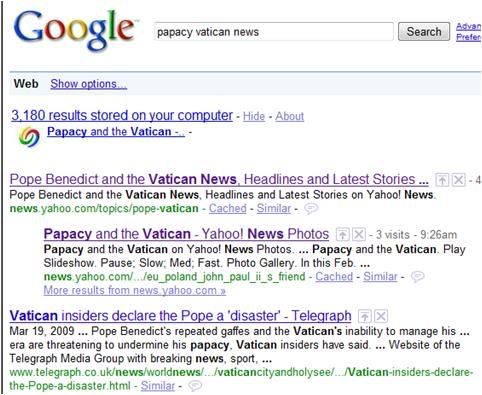 That item has persisted up there months after the episode, as though the Pope had done nothing newsworthy since March 19. And for what reason? Did the UK's Telegraph pay a premium price to be at the head of any search list on the Pope? Unlikely.
That item has persisted up there months after the episode, as though the Pope had done nothing newsworthy since March 19. And for what reason? Did the UK's Telegraph pay a premium price to be at the head of any search list on the Pope? Unlikely.
The better explanation is that some ignorant and/or bigoted 'responsible' punk at Google has coded it so that it stays up there. When will they take it off? When another headline just as bad or worse comes around to serve their malicious purpose.
[Modificato da TERESA BENEDETTA 20/06/2009 19:04] |
| |
 20/06/2009 19:59 20/06/2009 19:59 |
|
| | | OFFLINE | | Post: 17.759
Post: 431 | Registrato il: 28/08/2005
Registrato il: 20/01/2009 | Administratore | Utente Senior | |
|
PLACEHOLDER FOR POPE'S ADDRESS TO THE 'DE GASPERI FOUNDATION' 6/19/09
[Modificato da TERESA BENEDETTA 21/06/2009 12:58] |
| |
 21/06/2009 12:04 21/06/2009 12:04 |
|
| | | OFFLINE | | Post: 17.761
Post: 433 | Registrato il: 28/08/2005
Registrato il: 20/01/2009 | Administratore | Utente Senior | |
|

 I do not know why even a veteran Vaticanista like Salvatore Izzo of AGI, who generally has very shrewd comments, should find it 'remarkable' that Benedict XVI should come to venerate Padre Pio.
I do not know why even a veteran Vaticanista like Salvatore Izzo of AGI, who generally has very shrewd comments, should find it 'remarkable' that Benedict XVI should come to venerate Padre Pio.
Even the Franciscan friar, Brother DiLeo cited in the CNA article in the preceding post, ended his remarks by saying that "the picture of teh theologian Pope kneeling before Padre Pio's urn will be more significant than any words."
The assumption is that an intellectual like Joseph Ratzinger is too far removed from the faith of the simple folk. Yet this is someone who grew up amid the simple traditional Catholicism of Bavaria, and who, even as the Prefect of the Congregation for the Doctrine of the Faith, defined his job as keeping the faith whole and intact for the simple folk.
As a boy, he frequented the Marian shrine at Altoetting with his family, and there he also learned to venerate St. Conrad of Parzham, the lay Capuchin who served as a humble porter at the shrine for 40 years.
In fact, Pope Benedict XVi often cites Padre Pio whenever he refers to contemporary saints.
All manifestations of Christian faith are welcome, provided they do not remain empty manifestations but are translated into a genuine conversion of the heart to Christian love.
The theologian Pope and defender of the faith
will kneel before the mortal remains of the saint
by Salvatore Izzo and Franco Colomo

SAN GIOVANNI ROTONDO, June 20 (Translated from AGI) - Benedict XVI, the theologian Pope who spent half of his life as a university professor and the next half as defender of the faith, will render homage tomorrow to San Pio of Pietrelcina, a monk who dealt with his people with great simplicity and who had been investigated for some time by the former Holy Office [in the 1920s and 1930s].
He will pray before the urn containing the body of the Capuchin who bore Christ's stigmata in life and who has been on public exposition for more than a year now.
It is a significant visit which comes 10 years after Padre Pio's beatification in May 1989, and seven years since he was canonized on June 16, 2002.
Then the Pope will celebrate Mass in front of the futuristic church of San Pio (designed by Renzo Piano and decorated by mosaic artist Mark Rupnik). In the afternoon, he will visit the patients and personnel of the hospital Casa Sollievo di Sofferenza [started by padre Pio but now a property of the Vatican, administered by the diocese], and finally with priests, religious, seminarians and young people in the Church of San Pio.
Papa Ratzinger's predecessor, John Paul II, came here on May 23, 1987.
Last October 2006, on the 50th anniversary of the Opere di San Pio (Works of San Pio, referring to his various social projects in San Giovanni Rotondo), Benedict XVI addressed the staff and personnel of the Casa Sollievo and the members of Padre Pio's Prayer Encounter Groups at a special audience in St. Peter's Square.
"Padre Pio," he told them, "was above all a man of God. From childhood, he felt called by the Lord and he responded with all his heart, all his soul, all his strength. Thus, divine love could take possession of his humble person and make it a chosen instrument in his plan for salvation. Everything in the Church comes from God, and without him, nothing can stand."
"The works of Padre Pio," he said, "offer an extraordinary example of this truth. One can well call the Casa di Sollievo a miracle. And if the scientific and technological dimension distinguishes the hospital, prayer extends throughout all of the works."
The prayer encounter groups, he said, "continually knock on the heart of God, like an army of intercessors and reparationists, to obtain graces needed by the Church and the world".
These prayer groups, born in 1942, are today one of the most concrete proofs of the friar's legacy - more than 3,000 spread throughout all the inhabited continents.
"Padre Pio still offers a reference point for us today," John Paul II told the Capuchin community when he visited in 1987, "because the two aspects which characterize Catholic priesthood found particular acceptance and spiritual resonance in him: the faculty to consecrate the Body and Blood of the Lord and that of remitting sins. Were not the altar and the confessional the two poles of his life? His priestly testimony has a message that is as valid as it is relevant today."
At the beatification ceremony in 1989, he noted, that "Padre Pio's charity poured forth like balsam over the weaknesses and sufferings of his brothers. And so he united his zeal for souls with attention to human pain, leading him to build a hospital in San Giovanni Rotondo."
With the Casa di Sollievo, John Paul said, Padre Pio showed that "God's 'ordinary miracles' are made possible through our charity".
At the canonization rites on June 16, 2002, the Pope proclaimed to the world that "the new saint invites us to place God above everything else in the world and to consider him as our best and only good."
"The ultimate reason for Padre Pio's apostolic effectiveness was the profound roots of his spiritual fecundity in his intimate and constant union with God of which the long hours he spent in prayer were an eloquent testimony."
As for Padre Pio's relations with the Popes, John XXIII's great mistrust of the monk was well known, but towards the end, he changed his mind at the urging of Cardinal Giuseppe Siri, the Archbishop of Genoa who was the first president of the Italian bishops' conference, according to Siri's biographer, the famed ex-Vaticanista and historian Benni Lay.
"I often had to meet with Pope John because of my duties as CEI president and also of the 'social weeks' (annually observed by the Italian bishops to highlight the social work undertaken by dioceses and parishes], and we always ended up talking about Padre Pio," Lay quotes Siri as saying.
John XXIII, a good man and a true saint, was concerned because serious accusations were reaching the Vatican about Padre Pio. Sometimes it was the Capuchin's own defenders who contributed by an excess of zeal and the impression of wanting to rush tings.
In the end, the Pope, according to Siri, was convinced that the monk "had nothing to do with the accusations that were mobilized against him".
But even a giant of the faith like Cardinal Siri could do little against the prejudices of the Franciscan doctor Agostino Gemelli (founder of the hospital in Rome and the Catholic university of teh Sacred Heart in Milan) who could never accept that the poor Capuchin could share the same gift given to Francis of Assisi - namely, the stigmata.
Gemelli nursed a stubborn prejudice that Siri could not manage to dent. "Facts are facts", Siri wrote about Padre Pio's stigmata. In the process, he revealed a curious episode with Padre Pio.
Siri had been perplexed and anguished over a problem and he had to make a delicate choice between two courses of action 'in the dark', so to speak.
"The next day," he told Lay, "I received a telegram from Padre Pio who said that the decision I took was the right one/ How on earth did he even know?"
Eventually, Siri brought all this to the attention of Paul VI after Padre Pio's death and was able to get the process of beatification under way. This remained stalled for a long time until it was taken up again by John Paul II.
I will post here a story about Cardinal Ratzinger who visited Pietrelcina, Padre Pio's hometown about two weeks before the monk's canonization. The story first appeared in an Italian magazine in 2005 and I posted this translation in the thread ENCOUNTERS WITH THE FUTURE POPE on the PRF in June 2006 after Ratzigirl unearthed it.
CARDINAL RATZINGER'S HOMAGE
TO PADRE PIO OF PIETRELCINA
by Roberto Allegri
“June 1, 2002 was a Saturday. In Pietrelcina, we were all in great commotion in preparation for the proclamation of Padre Pio as a saint, which would take place on June 15. All of Pietrelcina, Padre Pio’s hometown, was mobilized for the event.
“Then came the surprise that no one expected. In the afternoon, Cardinal Joseph Ratzinger arrived, the man who is now Pope Benedict XVI, requesting to visit the places associated with Padre Pio.
“We accompanied him with great joy, and it was a most beautiful and touching occasion – especially because we had not thought that the great German theologian, Prefect of the Congregation for the Doctrine of the Faith, would be so visibly interested in the mystical story of Padre Pio, who is considered the saint of the simple folk, a saint of the people.”
So recalls Father Marciano Guarino about that day. His image, happily smiling, is immortalized next to Cardinal Ratzinger in photos taken during that visit [I've tried searching for these photos online but without success].
At that time, Fr. Marciano was the parish priest of the main church in Pietrelcina. Today he is the chaplain of the hospital called “House of Relief from Suffering” in San Giovanni Rotondo [ the little town near the Adriatic Sea in the central eastern part of Italy which is the site of the principal shrine to Padre Pio].
“As one can see in these pictures,” Padre Marciano says, “I was really very happy. The Cardinal had put us all at ease. We had thought that he would be a severe person, but he turned out to be simple and very friendly.”
But not one newspaper reported that visit in 2002. It was a private visit. In addition, everyone in Pietrelcina at the time thought that Ratzinger – precisely because he was Prefect of the CDF, which was once called the Holy Office, that had issued several condemnations of Padre Pio in the 20s and 30s - would not be a sympathizer of the monk from Pietrelcina.
Indeed, it was thought that Ratzinger, with his profound theological culture and his tranining as a great intellectual, would not have a ‘feel’ for the humility of Padre Pio and for the popular devotion demonstrated for him by simple people.
Some even suspected that the stern ‘guardian of the faith’ may have actually come to investigate whether there were devotional exaggerations, based on superstition, practised in the saint’s hometown.
But now that Cardinal Ratzinger has become Benedict XVI and has shown in his daily activities that he was always in harmony with his predecessor, all the prejudices have fallen away.
“Truthfully,” Fr. Marciano says, “we immediately realized that Cardinal Ratzinger was a great admirer of Padre Pio. To everything that we told him about Padre Pio, he listened attentively, with great interest, and asked questions. “
“In the places where Padre Pio lived and where so many mysterious phenomena were verified to take place, like the apparitions and the stigmata, the bloody ‘battle’ with Satan, the Cardinal visited in silence, almost as if he were listening to voices, almost as if he were imagining the events that had taken place. And he prayed. I could see him go into prayer.
”Even I had always had that mistaken image of the Cardinal. Like everyone else, on the basis of what was said about him, I imagined him stern, taciturn, reserved, mistrutful. Instead he was very sweet, affable, smiling, humble – someone who immediately put you at ease, one who was immediately likable.”
How was this visit arranged?
There was no arrangement. The cardinal was in Benevento for the closing of the diocesan Eucharistic Congress. Pietrelcina is only about 15 kilometers away from Benevento, so the Cardinal decided he wanted to visit the places associated with Padre Pio. And the superior of our convent simply received a telephone call informing him that the Cardinal would be arriving.
Was he accompanied by others?
By his secretary and by two priests from Benevento. No outward appearances. No official reception. He stopped awhile at the convent to speak to our superior (Father Nazario at the time), and then he began his visit. The first stop was at my parish church.”
Important because it was there Padre Pio said Mass in the early years of his priesthood...
And it is called the Mother Church of Pietrelcina because it is the most important. Padre Pio said Mass every morning in that church. We told Cardinal Ratzinger that as a young priest, Padre Pio had seen many apparitions of the Madonna in that church.
These are wondrous things for believers, but many others think they are simply legends or fantasizing. But Cardinal Ratzinger, great theologian, defender of the faith, simply listened very attentively, and I never saw his face express the slightest sign of surprise or reservation.
How long did he stay?
Quite some time. He wanted to visit every place unhurriedly. I remember he congratulated us on how clean the Church was. He is very watchful and observant, nothing seemed to escape him. He noted how the church was clean even in the most remote corners.
Inside the church, we also had a bell that we had ordered to mark Padre Pio’s canonization two weeks later. It was inside the church to be blessed. It would be a historic bell. The Cardinal stopped to inspect and admire it.
There was a reliquary, with a glove of Padre Pio that was stained with blood from his stigmata. The Cardinal looked at everything with great attention and admiration.
Later, where else did he go?
We went to the historic zone of Pietrelcina, in which is located the Church of St. Anne, where Padre Pio was baptized, and the houses where he was born, where he passed his infancy, and where he lived during his long years of sickness.
The cardinal even went up to the ‘torretta’, a little room that had been made into a sort of tower, to which Padre Pio often retreated for prayer, and later, even became his bedroom.
In that ‘torretta’ many mysterious, mystic things happened that are difficult to explain, and therefore, many people don’t consider them factual. But they are historical facts that truly occurred, and we recounted these to Cardinal Ratzinger, who listened seriously and with active participation.
After the visit to the historic zone, he was accompanied to the countryside location in Piana Romana, where Padre Pio received his stigmata.
So the Cardinal showed great interest in all these mystical events associated with Padre Pio?
A great deal of interest, but not only that. As I said, in every place that he visited, he would gather himself in prayer, showing devotion, admiration and love for Padre Pio.
In 2002, the newspapers rwere reporting almost daily about Padre Pio. The visit to Pietrelcina of a cardinal as famous as Ratzinger should have been a big thing for the press, ut instead it went by unnoticed, and it is only made known now that he is Pope.
I don’t know. Maybe it was not played up because Cardinal Ratzinger was always resevred. Or maybe out of prejudice. As I said, it was thought that Ratzinger was not an admirer of Padre Pio.
Instead, it turns out to be the opposite. I learned, reading an artile in the magazine ‘Pietrelcina, the Land of Padre Pio’, that the cardinal spoke amply of Padre Pio in one of his books written before he came to visit us. And he spoke precisely of those aspects that are linked to the popular devotions to Padre Pio.
He recalled the story that a pregnant woman told a reporter – she had been gravely ill bur was cured after praying to Padre Pio. In commenting on this, the Cardinal did not say that this was an exaggeration, or fanaticism. Instead he pointed out that the woman’s behavior showed her true faith.
Indeed, this is what he wrote: “It may have been ingenuous or childlike, but her behavior reflected something of the original trustfulness that we had been given as a gift and which is rooted in the awareness that we have friends in the world beyond this, that such friends are near, that they can help us, and that we can call on them with trust.” And that is exactly what people did
who turned for help with great simplicity to Padre Pio.
How long did the visit last?
Several hours. I was not able to participate in all of it because I had evening Mass to say at my church. Before he left, the cardinal signed the guest book in Pietrelcina, saying a beautiful thing: “May Saint Padre Pio always help his brothers and all pilgrims to love the suffering Christ and make a commitment to charity that springs from the open heart of the Lord.”
[Modificato da TERESA BENEDETTA 21/06/2009 12:07] |
| |
 21/06/2009 12:50 21/06/2009 12:50 |
|
| | | OFFLINE | | Post: 17.762
Post: 434 | Registrato il: 28/08/2005
Registrato il: 20/01/2009 | Administratore | Utente Senior | |
|

 Pope’s visit to Padre Pio
Pope’s visit to Padre Pio
will inspire greater closeness
to Christ, says Capuchin rector

Rome, Italy, Jun 20, 2009 (CNA).- On the eve of Pope Benedict XVI’s visit to the tomb of Padre Pio, Brother Francesco Dileo, Rector of the Shrine of Our Lady of Graces (Santa Maria delle Grazie), where the Pope will celebrate Mass this Sunday, said his visit will encourage the faithful to imitate the saint from Pietrelcina and thus follow Christ with more devotion.
In an interview with L’Osservatore Romano, the rector noted how “Padre Pio once said, ‘I will make more noise dead than alive.’ And in fact, the number of pilgrims is much higher compared to the end of 1968,” with some seven million visiting the shrine annually.
Speaking about the number of faithful who come to San Giovanni Rotondo to pray to the saint for a miracle, Brother Dileo said he receives an enormous amount of letters from people praying for Padre Pio’s intercession.
The letters are directly addressed to Padre Pio, “as if he were still alive, to ask for some physical or spiritual healing,” the brother said.
“I am firmly convinced that the grace of God that touches the hearts of men and makes the faith blossom and be reborn continues to work in this place, even after the death of Padre Pio,” he said. “I think it is difficult to encounter the life of this saint without sensing a desire to renounce sin and change one’s conduct.”
Referring to Pope Benedict XVI’s visit tomorrow, Brother Dileo said, “The picture of Benedict XVI in prayer in front of the remains of our beloved brother saint will certainly be more eloquent than many words.”
It is a significant coincidence that soon after inaugurating the Year for Priests, the Holy Father is making a pilgrimage to a saint who was a legendary priest widely recognized for his saintliness while he was alive.
Today's issue of OR carries an interview with a young Capuchin in San Giovanni Rotondo who says that in many ways, Padre Pio was like the Cure of Ars. I will try to translate it as soon as I can. My problem is that there is a flood of excellent material on Padre Pio that has come out in the Italian media the past few days, so I must choose what I can realistically have the time to translate.
Here's the official poster for the Pope's visit:
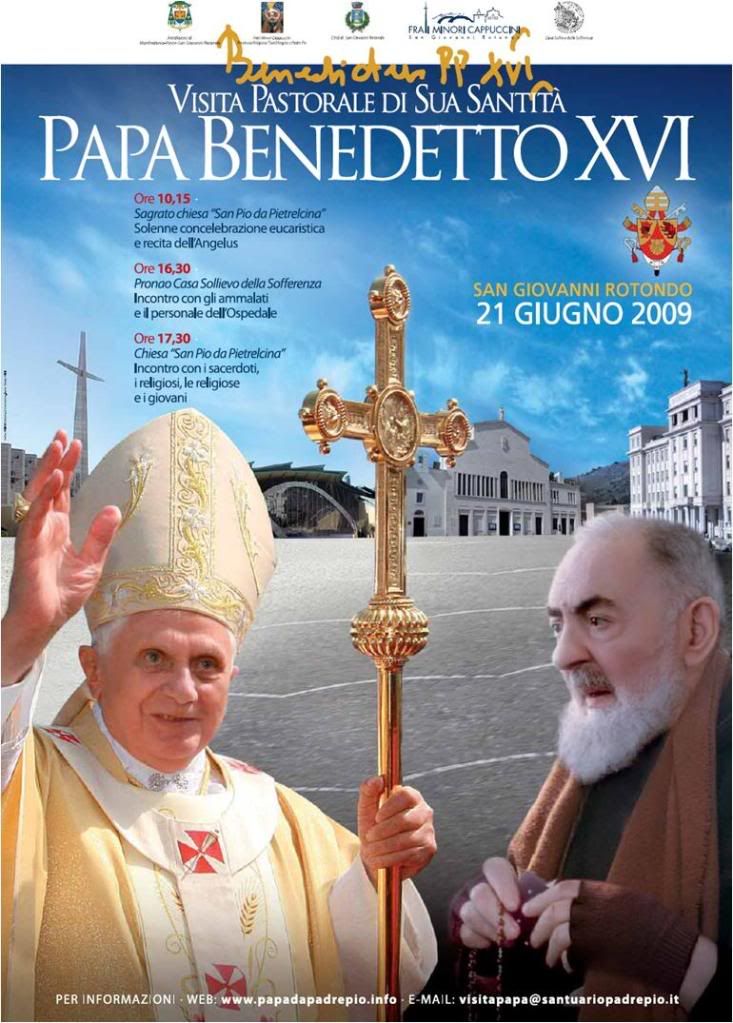 www.papadapadrepio.info/papa_san_giovanni_rotondo_interna.php?...
Here's a good pre-visit situationer from Vatican Radio:
The Pope's visit to San Giovanni Rotondo
Translated from
www.papadapadrepio.info/papa_san_giovanni_rotondo_interna.php?...
Here's a good pre-visit situationer from Vatican Radio:
The Pope's visit to San Giovanni Rotondo
Translated from
the Italian service of

June 20, 2009
San Giovanni Rotondo is in ferment for the arrival tomorrow of Benedict XVI who will visit the important sites in the life of St. Padre Pio of Pietrelcina, seven years after he was canonized.
It is the second visit by a Pope, after that of John Paul II. And it is Benedict XVI's third visit to the Puglia region, having been to Bari in May 2005 and to Leuca and Brindisi in June 2008.
Some 30,000 pilgrims are expected to line the 4-kilometer route of the Popemobile through the city.
Preparations are impressive and the joy and anticipation is great among the people of Puglia and the Franciscan Capuchins who are in charge of the Padre Pio shrine and sites.
Correspondent Denora Donnini has this report:
A bright sun and a gentle breeze make the climate in San Giovanni Rotondo quite pleasant as it awaits Peter, the Pope who comes here tomorrow for a visit to the town where Padre Pio exercised his mission as a Franciscan monk and where he died in 1968.
More than 30,000 pilgrims are expected, and 550 policemen and firemen will keep order. The visit will certainly leave an impression on this town as did the visit of John Paul II in 1987, who would canonize Padre Pio 15 years later.
In fact, John Paul II, as a bishop in Cracow, had a personal correspondence with Padre Pio in which he asked him to intercede for the health of friends.
In 1962, Bishop Wojtyla wrote him to pray for a friend who had been diagnosed with cancer. Eleven days later, he wrote a second letter to thank him because the woman was miraculously healed. [This was Dr. Wanda Poltawska who was in the news recently because she published a book recalling her rirendship and correspondence with Karol Wojtyla over a pereiod of 55 years.]
Karol Wojtyla actually met Padre Pio in person in 1948 when he was a young priest. He came to San Giovanni Rotondo in 1978 after Padre Pio's death as a cardinal.
Anticipation and joy radiate from the faces of the Capuchin brothers of the convent here, the many pilgrims, and the doctors, personnel and patients of the Casa Sollievo della Sofferenza (House of relief from suffering), the hospital started by Padre Pio in 1956 with 250 beds, and which is now one of Europe's best tertiary (specialized) hospitals with 1200 beds, a center for genetic studies, and a research center to study rare diseases.
Tomorrow, Benedict XVI will have time for everyone. First he will visit Cell #1 where Padre Pio died, in the church of Santa Maria delle Grazie, and then he will pray before the saint's mortal remains which have been on public exposition in the church crypt since last April after it was exhumed from his grave in the church itself.
The Pope will light two 'eternal flames' to symbolize the two papal visits to the shrine.
Then he will celebrate Mass and lead the Angelus in the vast piazza in front of the Church of San Pio, built by architect Renzo Piano and inaugurated in 2004.
In the afternoon, he will inaugurate the mosaic scenes from the lives of Jesus, St. Francis and Padre Pio created by artist Marko Rupnik, a Jesuit priest, for the crypt of the new church.
During the Mass, the Pope will receive a commemorative medallion of the visit from Matteo Pio Colella, who, as a boy, had been miraculously cured of fulminating meningitis through Padre Pio's intercession - the miracle that led to his canonization.
In the afternoon, the Pope will visit the Casa di Rilievo and then meet with the clergy, religious, seminarians and young people at the Church of Padre Pio.
It will be a very significant visit by a Pope to one of the great contemporary saints who has much to say to man today.
The visit will be "an exhortation to Christians to grow in their education in the faith, not to stop in contemplation of a great saint or hoping for miracles, but to learn to be witnesses to Christ, as Padre Pio was all his life", according to Antonio Belpiede, spokesman of the Capuchins' monastic province in Foggia.
What is the relevance of Padre Pio today in a world that is too rationalistic, nihilistic and skeptical? He always underscored the importance of backing up the announcement of Christ and his message with charity.
The world has an order that comes from God's love, and the history of man has its own order. Even children know the formula for water - as if to say that the important elements of life are simple. Christianity is simple and it is always the same: love for God means love for our brothers.
Padre Pio admirably expressed this love in total abandon to the outpouring of the Holy Spirit, to the embrace of the Trinity, but never taking his eyes off from his people, never forgetting about the poor and the suffering,
One can only love truly by loving God and one's fellowmen - that is Christianity, that is the simple formula of our faith.
Padre Pio also experienced in his own body the wounds that Christ suffered on the Cross. Why is that?
St. Paul aays in his letter to the Philippians: "We have been given the privilege not only to believe in Jesus Christ but also to suffer for him". And then he wrote to the Colossians, as someone who had profound experience of pain: "I complete in my flesh what Jesus Christ suffered for his Body which is the Church".
Padre Pio was chosen by the Lord to be an icon of his Son the tEernal Priest, who was crucified for love of mankind. And it is true that there is no greater love than to give one's life for those we love.
We spoke to Dr. Lucia Miglionico, pediatric oncologist (cancer specialist) at the Casa di Sollievo, on how the sick children were prepared for the visit.
Dr. Miglionico: They are all extremely happy about the Pope's visit. Besides the preparations they have worked on with their teachers - prayers, streamers, flyers - we also prepared them for a possible meeting with the Pope. Some of them cannot leave the ward, but they will be able to follow the visit on TV. And those of them who will be out there to meet the Pope will carry with them the prayer intentions of those who are left in bed.
You are in chazge of a department that has children of all ages struck with cancer or tumors. So you and your staff are in constant contact with the suffering of innocents. How do you help them through their ordeal in the light of faith?
St. Pio made it clear that everyone who works here cannot be concerned only with physical healing of the body, but to accompany all our work with prayer, in prayer, to consider even this as a mission of evangelization.
Debora spoke to two children who will be among those meeting the Pope in the atrium of the hospital, and asked them what they expected.
Carmela: Much hope certainly. Also a lot of confidence, because we hope that with the help of the Pope, with his prayers, our own prayers may be heard better 'above'. And we hope we will gain more strength, more resolve, to overcome illness. I will ask the Pope to pray for our parents and relatives who suffer with us.
Romeo: I see in all the children a lot of hope, as Carmela rightly said. Since I am Romanian, I also think the Pope is a hero who fights against racial prejudice.
Do you feel helped by your faith?
Romeo: Yes, certainly, I feel personally that the Church is behind me.
This poster describes the spiritual preparation led by the diocese in the week preceding the Pope's visit:
 The schedule shows daily Masses adn prayer eocnounters, capped by a 'monumental' Via Crucis and massive prayer vigil at the Church of Santa Maria delle Grazie Saturday night
The schedule shows daily Masses adn prayer eocnounters, capped by a 'monumental' Via Crucis and massive prayer vigil at the Church of Santa Maria delle Grazie Saturday night:
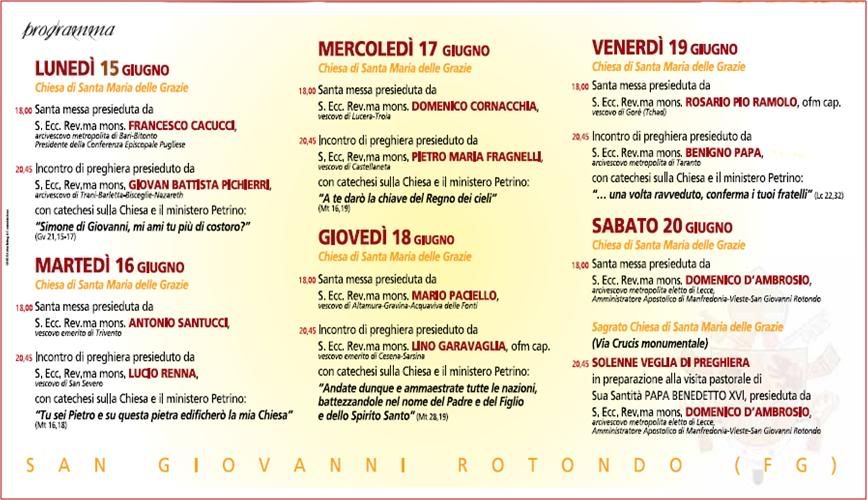
[Modificato da TERESA BENEDETTA 21/06/2009 12:57] |
| |
 21/06/2009 12:55 21/06/2009 12:55 |
|
| | | OFFLINE | | Post: 17.763
Post: 435 | Registrato il: 28/08/2005
Registrato il: 20/01/2009 | Administratore | Utente Senior | |
|

June 21
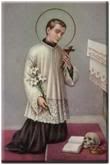 St. Aloysius (Luigi) Gonzaga (Italy, 1568-1591)
St. Aloysius (Luigi) Gonzaga (Italy, 1568-1591)
Jesuit, Confessor
OR today.
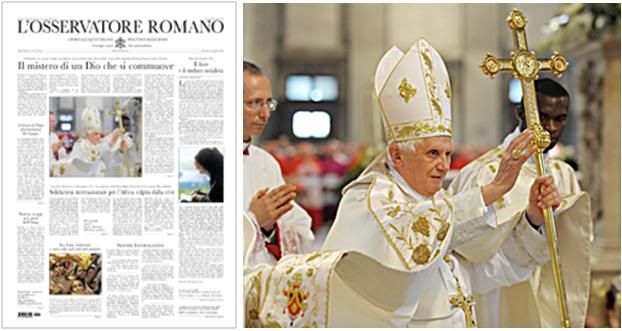 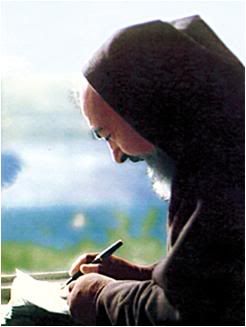
The Holy Father opened the Year for Priests at Second Vespers
on the SoLemnity of the Most Sacred Heart of Jesus:
'The mystery of a God who feels for his people'
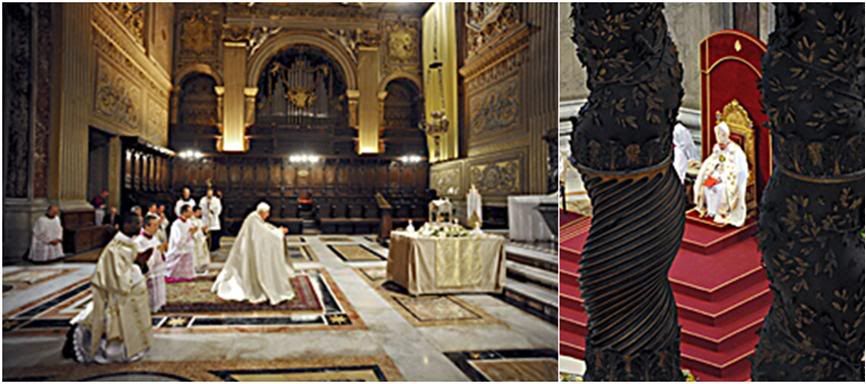 Other Page 1 stories: A story on Padre Pio to introduce other stories in the inside pages on the occasion of the Pope's visit today to his shrine; the Pope's meeting with the De Gasperi Foundation; the letter written by the Pope to German President Koehler asking his help to promote international help to Africa before the Pope's trip to Africa and Koehler's response [it is not known why these letters are revealed at this time]; and increasing hunger in more parts of the world.
THE POPE'S DAY
Other Page 1 stories: A story on Padre Pio to introduce other stories in the inside pages on the occasion of the Pope's visit today to his shrine; the Pope's meeting with the De Gasperi Foundation; the letter written by the Pope to German President Koehler asking his help to promote international help to Africa before the Pope's trip to Africa and Koehler's response [it is not known why these letters are revealed at this time]; and increasing hunger in more parts of the world.
THE POPE'S DAY
PASTORAL VISIT OF THE HOLY FATHER BENEDICT XVI
TO SAN GIOVANNI ROTONDO
Sunday, June 21, 2009

PROGRAM
08.00 Departure by helicopter from the Vatican
09.15 Arrival at the Antonio Massi sport field
09.35 Private visit to the Shrine of Santa Maria delle Grazie
and veneration of the remains of St. Pio of Pietrelcina in the Crypt.
10.30 EUCHARISTIC CONCELEBRATION in front of the Church of St. Pio
Homily by the Holy Father
- RECITAL OF THE ANGELUS
Words from the Holy Father
16.45 Encounter with patients, medical staff and officials
at the Monumental Entrance to the Casa Sollievo di Sofferenza
(House of Relief from Suffering)
Address by the Holy Father
17.30 Encounter with priests, religious, and young people
Church of San Pio
Address by the Holy Father
18.15 Departure for the Vatican
19.30 Arrival at the Vatican
NB: Because of bad weather, the Pope did not travel by helicopter this morning. He took a regular airplane to Foggia airport,
and was drvien by car from there to San Giovanni Rotondo.
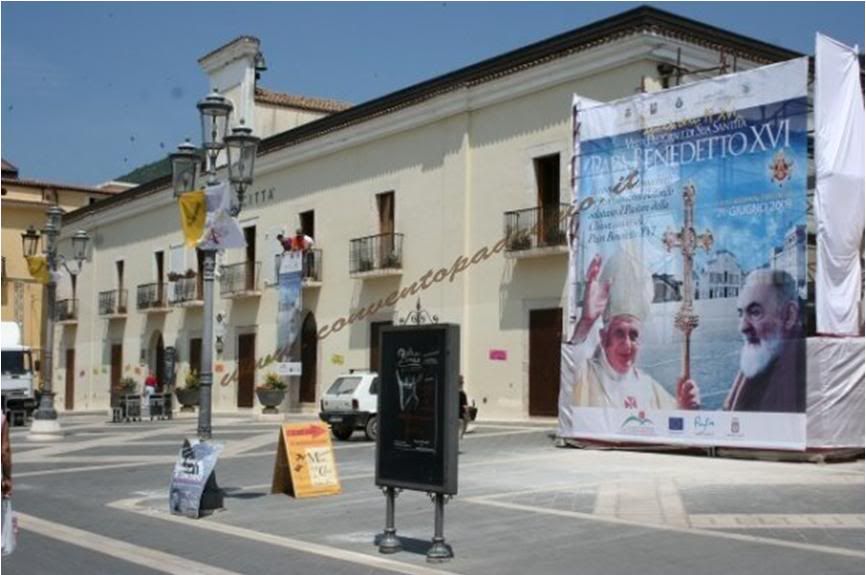
[Modificato da TERESA BENEDETTA 22/06/2009 02:14] |
| |
 21/06/2009 13:19 21/06/2009 13:19 |
|
| | | OFFLINE | | Post: 17.764
Post: 436 | Registrato il: 28/08/2005
Registrato il: 20/01/2009 | Administratore | Utente Senior | |
|
RESERVED FOR TRANSLATION OF O.R. ARTICLES TODAY ON PADRE PIO
AND THE POPE'S VISIT
|
| |
 21/06/2009 14:04 21/06/2009 14:04 |
|
| | | OFFLINE | | Post: 17.765
Post: 437 | Registrato il: 28/08/2005
Registrato il: 20/01/2009 | Administratore | Utente Senior | |
|

 The Pope pays homage
The Pope pays homage
to Padre Pio
Translated from

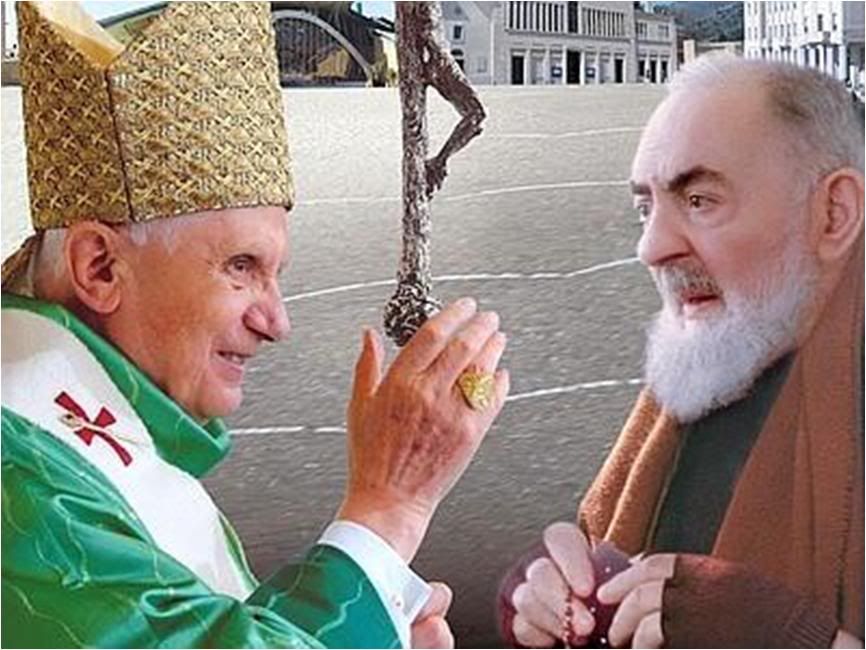
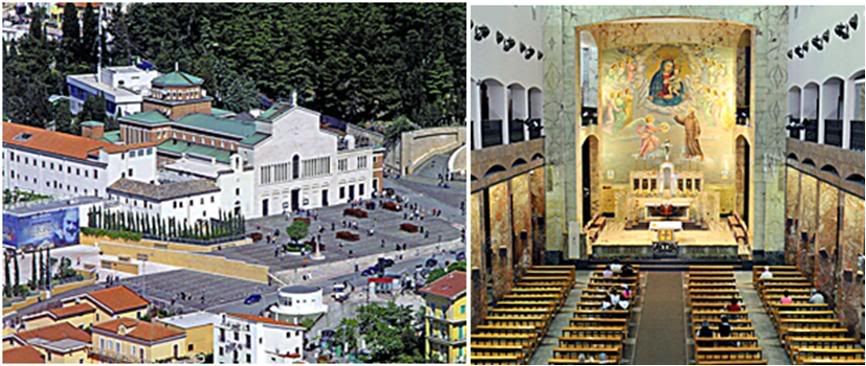 The Church of Santa Maria delle Grazie, where Padre Pio lived and served the last decades of his life and where he was buried.
The Church of Santa Maria delle Grazie, where Padre Pio lived and served the last decades of his life and where he was buried.
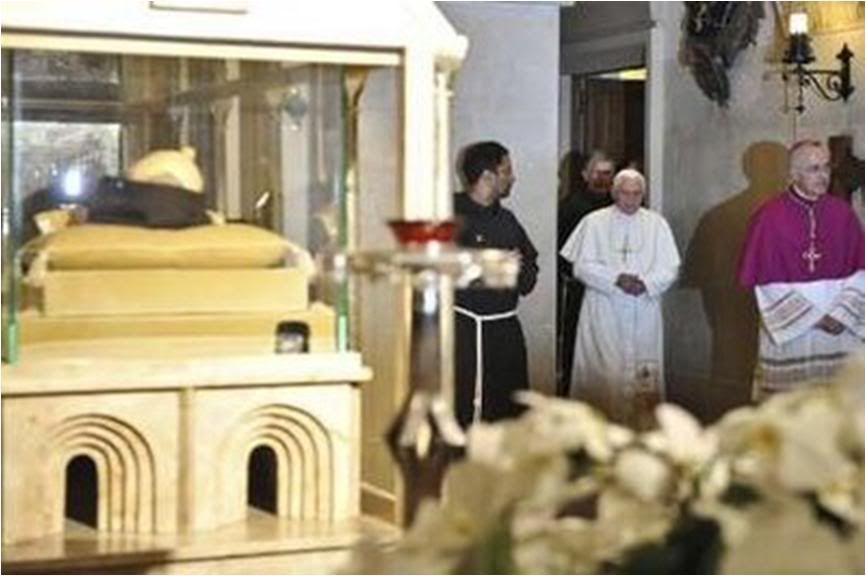
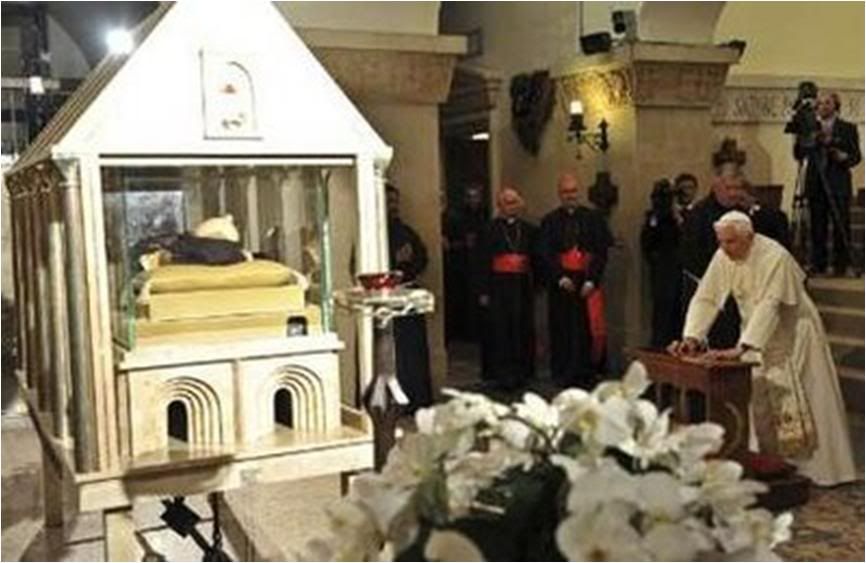
SAN GIOVANNI ROTONDO, June 21 - Benedict XVI is in San Giovanni Rotondo. For the same time since he became Pope, Papa Ratzinger is in Puglia for a pilgrimage in the footsteps of Padre Pio of Pietrelcina.
The Pope arrived by car after landing at the military base of Amendola in Foggia: an unexpected change because of the bad weather which did not allow a helicopter flight from Rome.
The Pope then went through the city in the Popemobile, and was engulfed in a veritable sea of pilgrims, who despite the rain, lined the route in thousands to welcome him.
Meanwhile, the large piazza in front of the church of San Pio, designed to hold as many as 30,000, was already packed since the early hours of the morning.
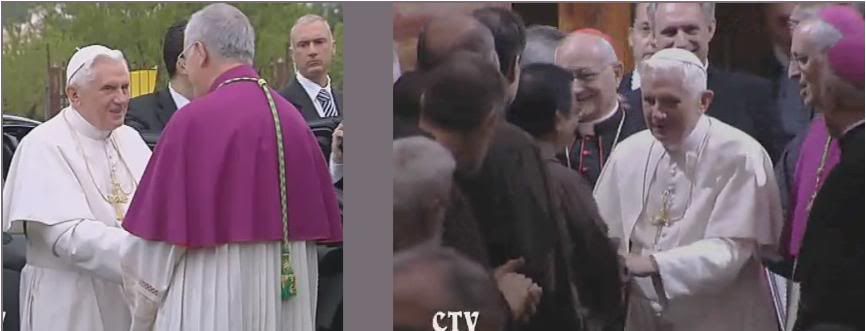
The Pope was welcomed by the Italian Minister for Regional Relations Raffaele Fitto in the name of the Italian government; Nichi Vendola, president of Puglia region; Antonio Pepe, president of Foggia province; and Foggia Mayor Gennaro Giuliani.
Welcoming him for the diocese was Mons. Domenico D'Ambrosio, apostolic administrator of San Giovanni Rotondo who has been named the new bishop of Lecce, farther south in Puglia.
Arriving in San Giovanni Rotondo by car from Foggia, the Pope transferred to the Popemobile which went through viale della Gioventù, via Donatello, corso Roma, via Foggia, piazza padre Pio, corso Umberto I, piazza Europa and viale Cappuccini to get to the Church of Santa Maria delle Grazie where Padre Pio lived and served during the last decades of his life, and where he died in 1968.
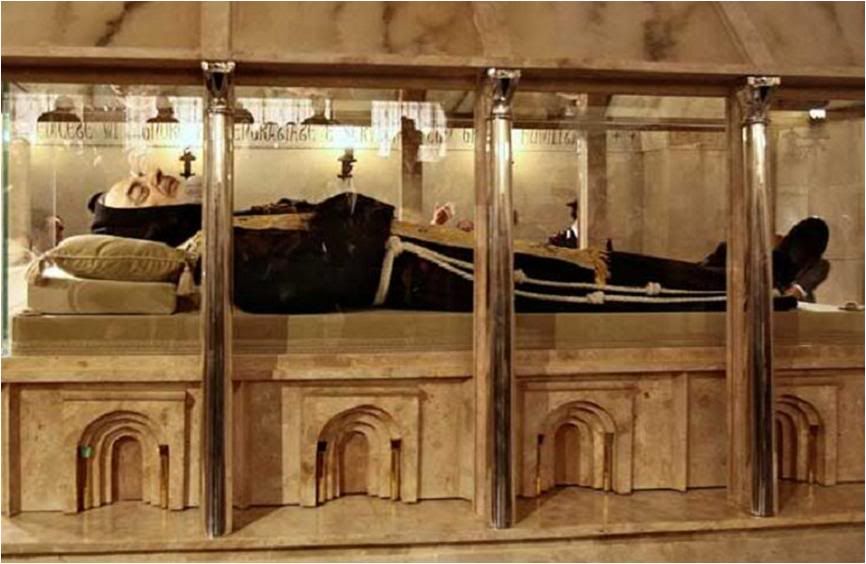 Above photo was taken on the day the saint's remains were first placed on public exposition in April 2008.
Above photo was taken on the day the saint's remains were first placed on public exposition in April 2008.
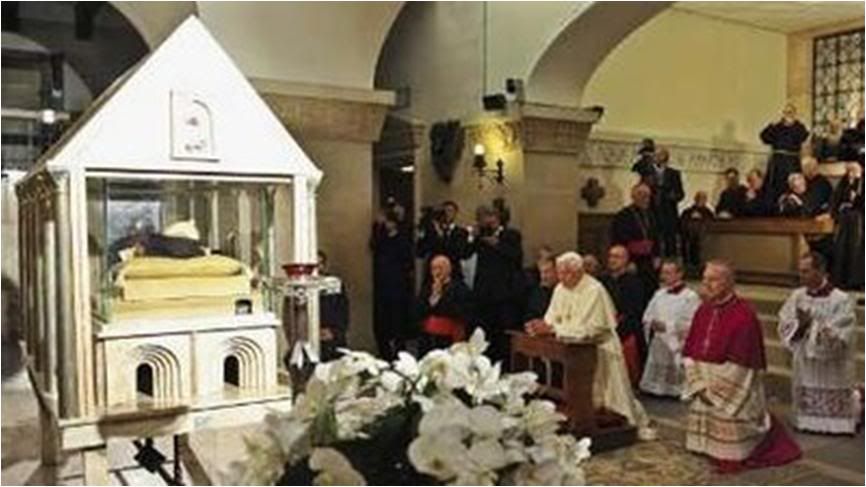
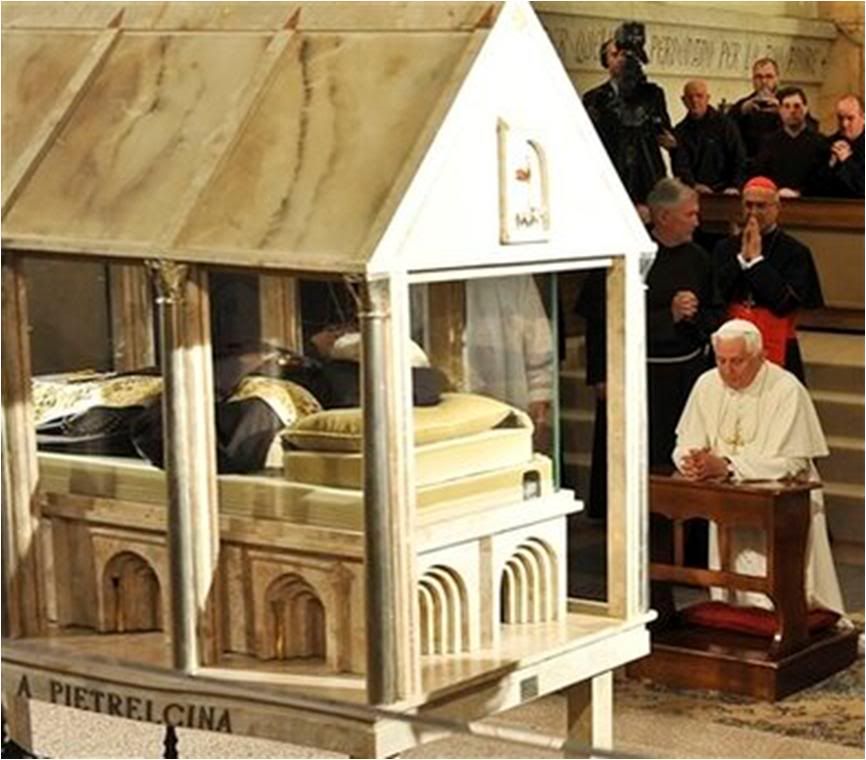
In the Church, the Pope visited the cell where the saint died and then descended to the crypt where the saint's remains have been on public exposition since last April, and knelt in veneration in front of the urn next to the tomb where Padre Pio had been buried for 40 years.
Here, too, John Paul II had knelt in veneration on his visit to San Giovanni Rotondo in 1987, which marked the revival of Padre Pio's beatification process which had been stalled for years.
An Apcom report adds this:
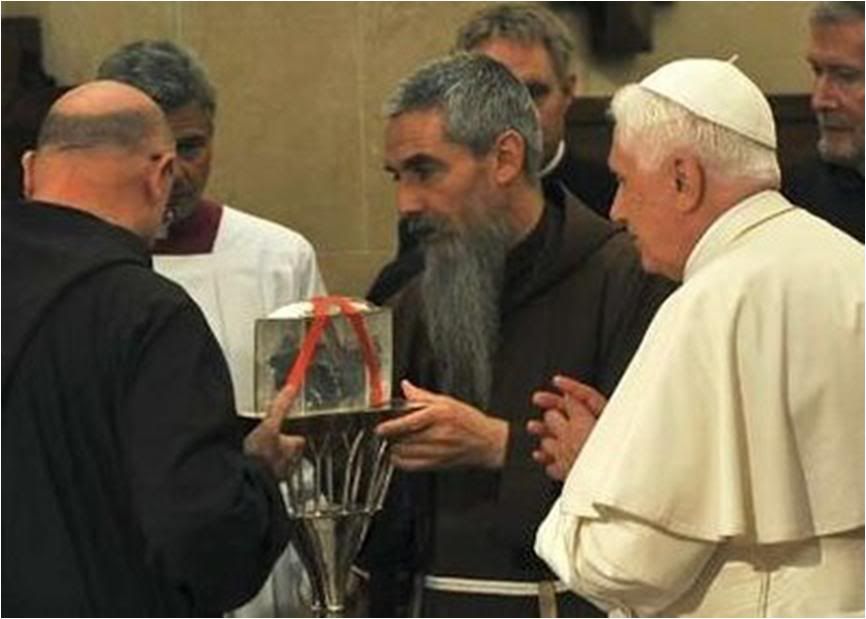
The Pope blessed the reliquary containing the heart of Padre Pio. The reliquary was then brought to the altar where it was displayed during the Mass celebrated by the Pope.
At Santa Maria delle Grazie, the Pope also met Pia Forgione, a niece of Padre Pio, and his eight grandnephews.
Some 30 Capuchin friars were at the crypt during the Pope's visit. Joining the Pope in venerating Padre Pio were Cardinal Tarcisio Bertone and a deputy secretary of state, Mons. Giuseppe Bertello [Has there been an unannounced change of the deputy (Mons. Fernando Filoni) or Sostituto, as he is called in Italian?]
Also present was the monk who had given Extreme Unction to Padre Pio, Fr. Paolo Corvino, now 90, who has met 8 Popes.
Since the remains of the saint went on exposition last year, an average of 15,000 pilgrims have visited daily, peaking on feast days and in the summer.
From Caterina's montage of videocaps:
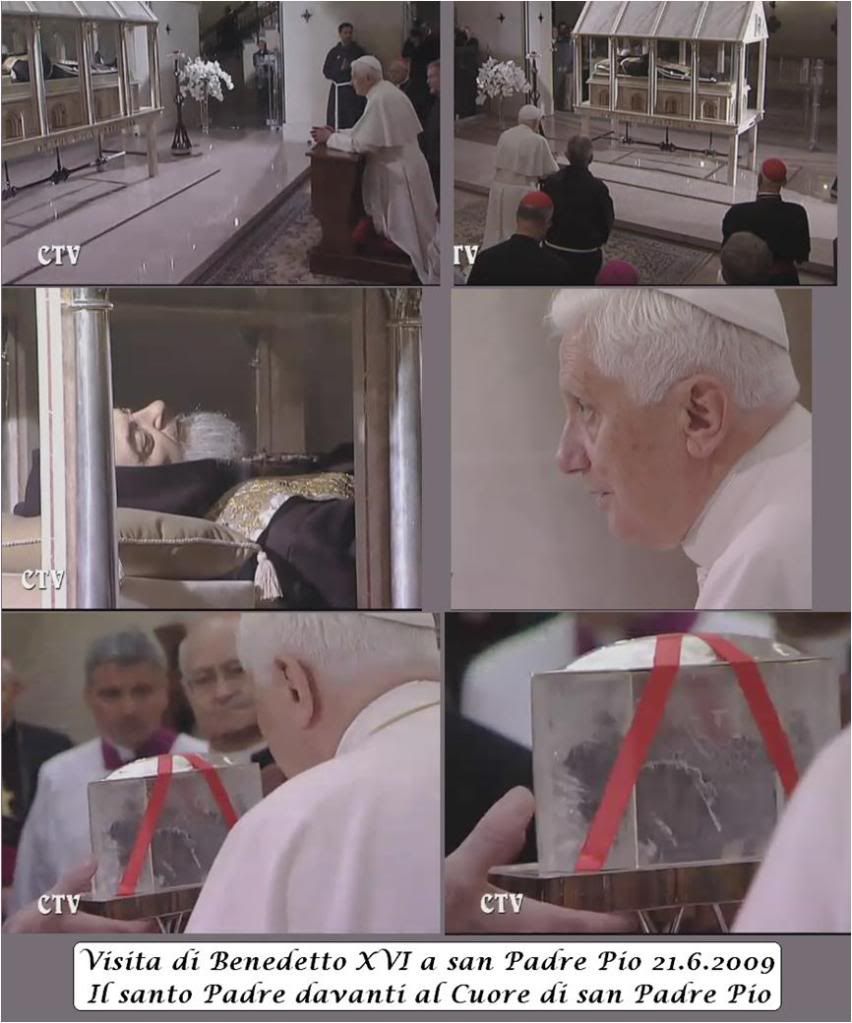

The Pope vested for Mass in Santa Maria delle Grazie and then proceeded by Popemobile to the Church of San Pio to celebrate the Eurcharistic Sacrifice in the main piazza.
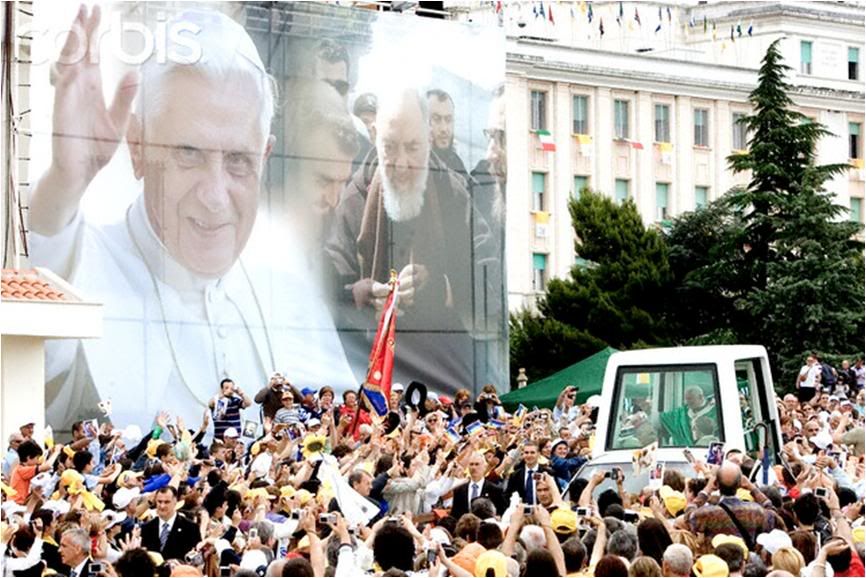
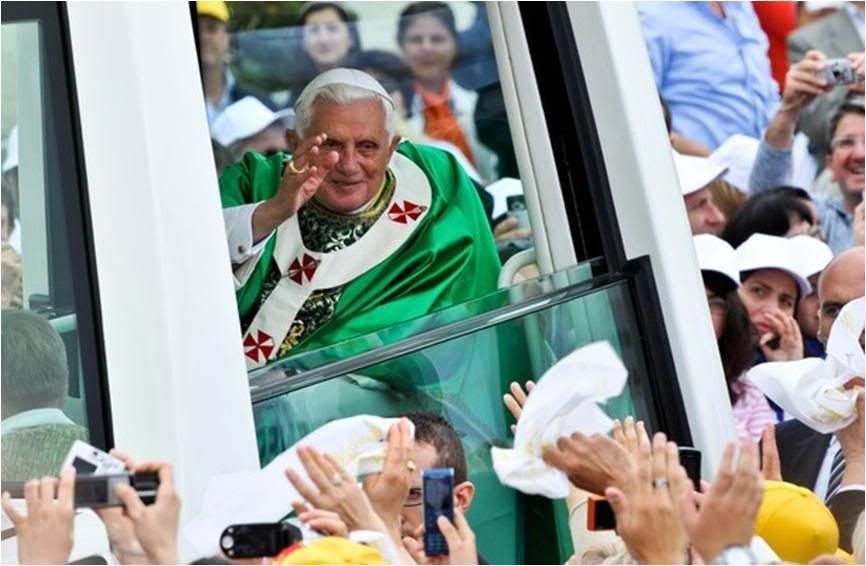
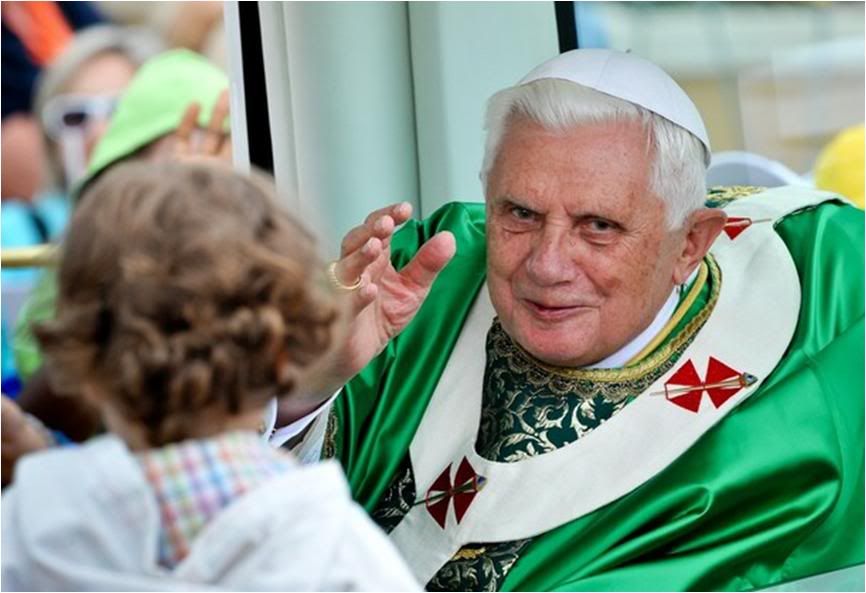
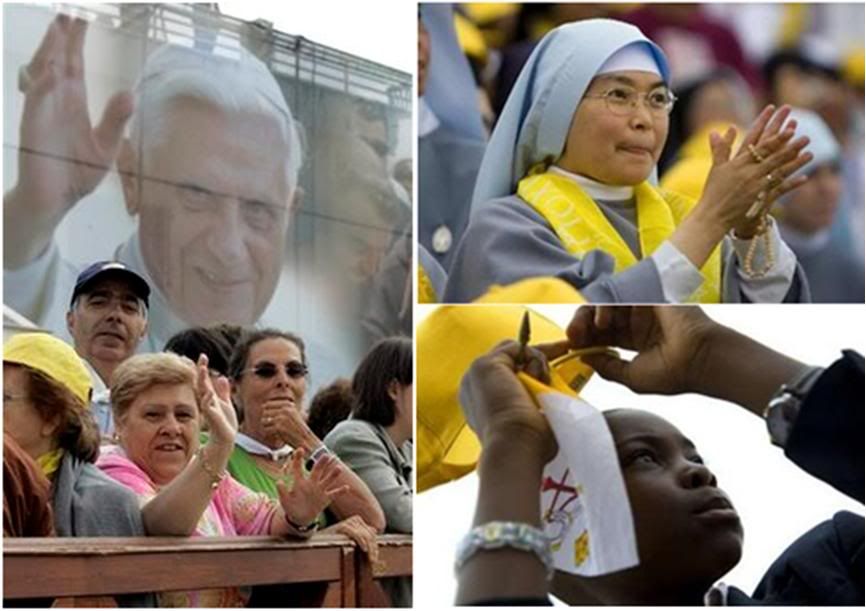
[Modificato da TERESA BENEDETTA 22/06/2009 03:36] |
| |
 21/06/2009 14:17 21/06/2009 14:17 |
|
| | | OFFLINE | | Post: 17.766
Post: 437 | Registrato il: 28/08/2005
Registrato il: 20/01/2009 | Administratore | Utente Senior | |
|

 MASS AT SAN GIOVANNI ROTONDO
MASS AT SAN GIOVANNI ROTONDO
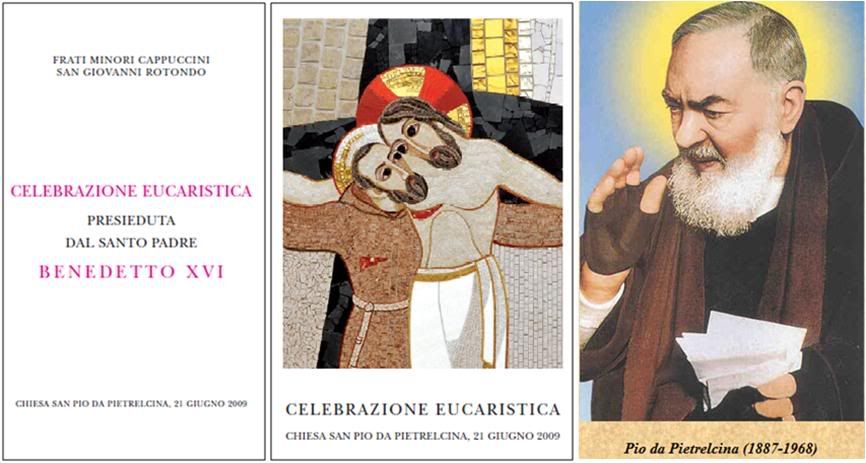 Illustration: Stigmatization of Padre Pio (from the murals by Mark Ruznik, Church of St. Pio)
Illustration: Stigmatization of Padre Pio (from the murals by Mark Ruznik, Church of St. Pio)
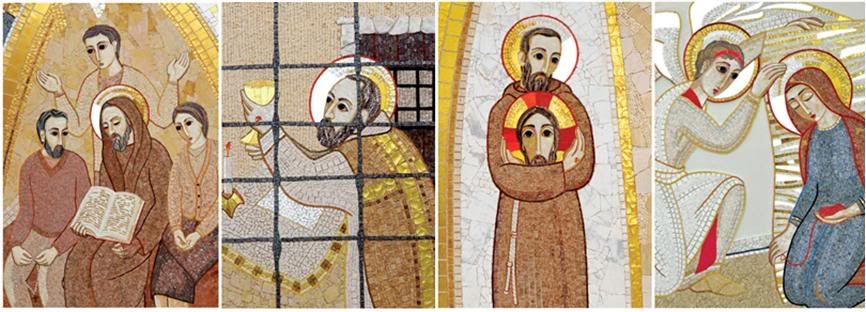 Other illustrations in the Mass booklet, taken from the mural series. From left: 'Word becomes prayer'; St. Pio offers Mass in solitude (1931-1933); St. Pio embraces the life of Christ; The Annunciation: Our Lady opens herself to the Word of God.
Other illustrations in the Mass booklet, taken from the mural series. From left: 'Word becomes prayer'; St. Pio offers Mass in solitude (1931-1933); St. Pio embraces the life of Christ; The Annunciation: Our Lady opens herself to the Word of God.

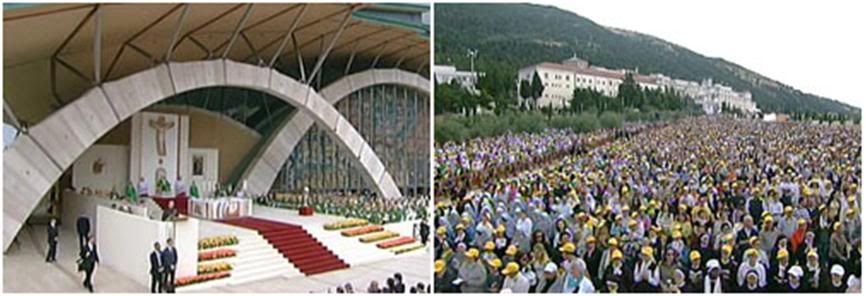
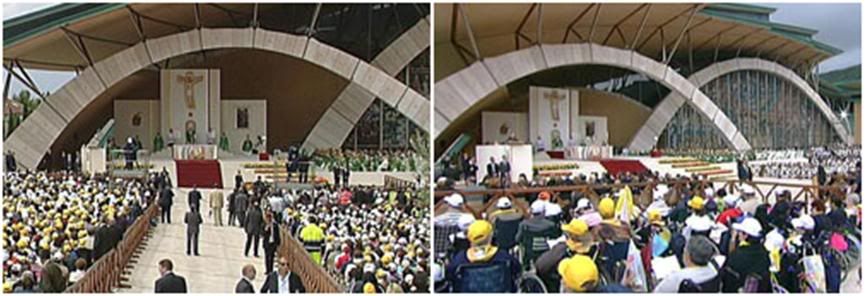
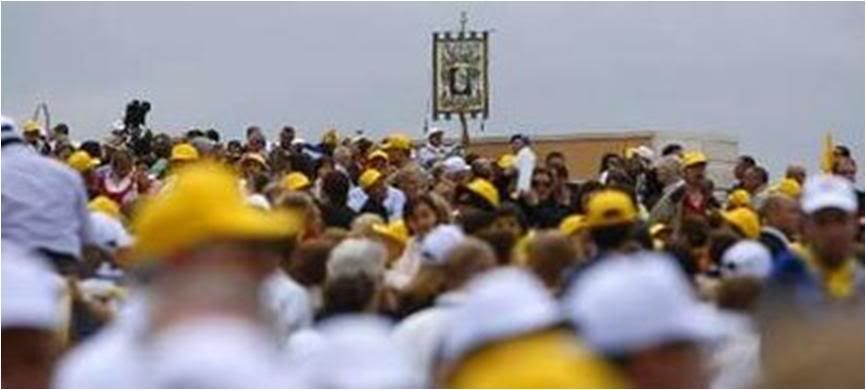
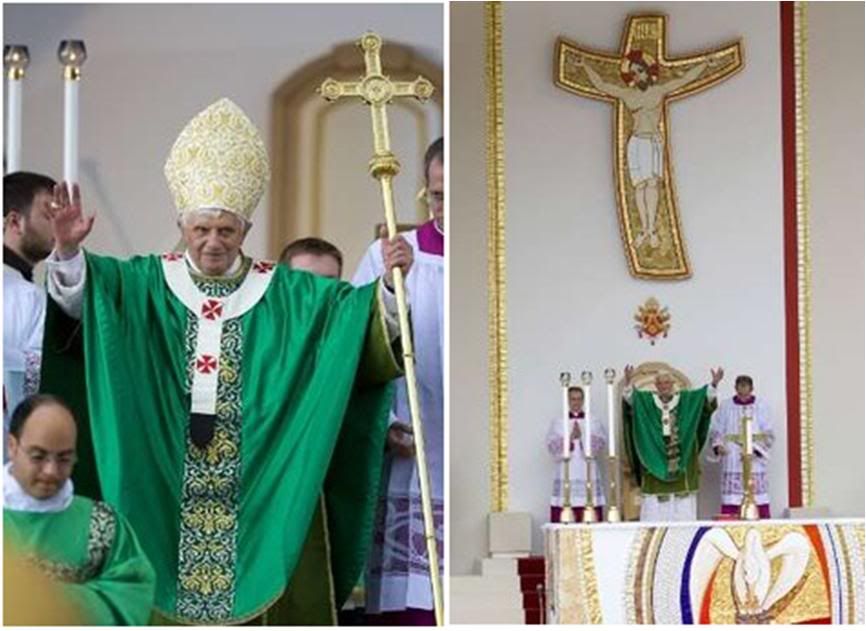
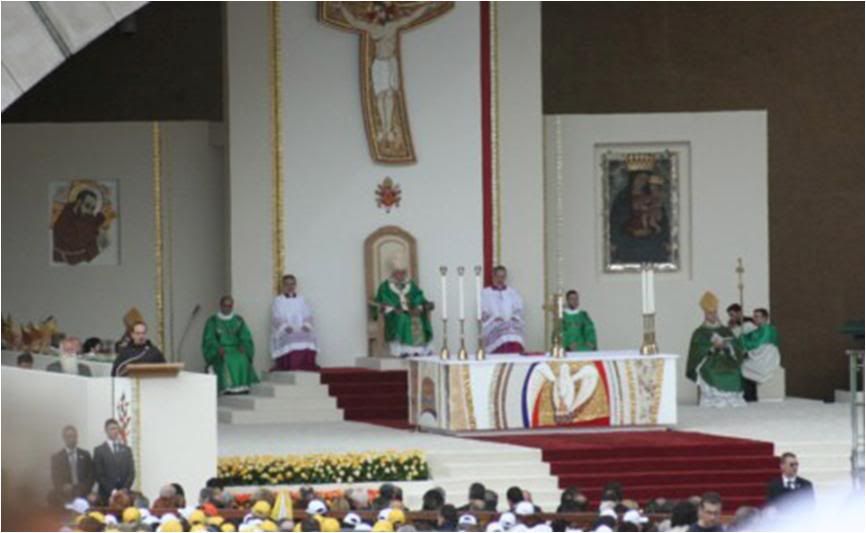
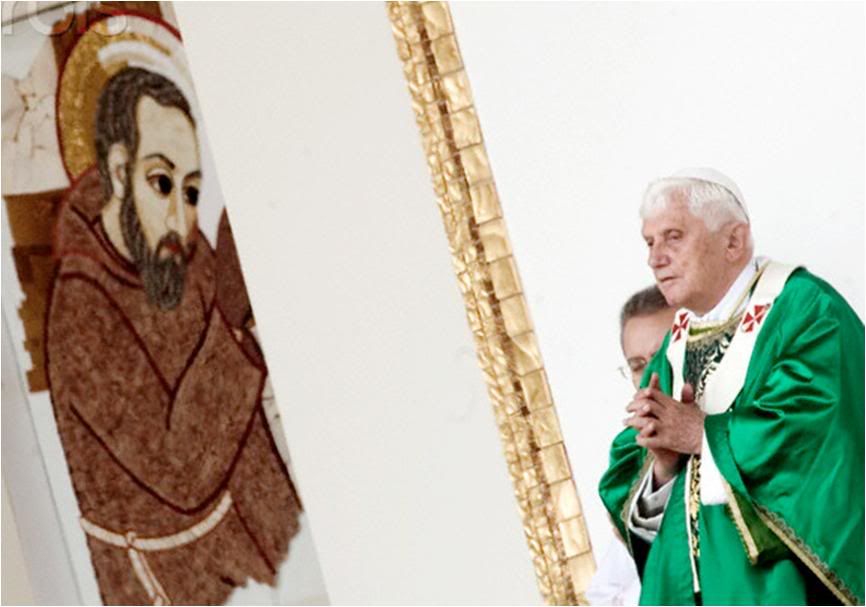 THE HOLY FATHER'S HOMILY
THE HOLY FATHER'S HOMILY
Dear brothers and sisters!
At the heart of my pilgrimage to this place, where everything speaks of the life and holiness of Padre Pio of Pietrelcina, I have the joy of celebrating the Eucharist with you and for you - the mystery which constituted the center of his entire existence, the origin of his vocation, the power of his testimony, the consecration of his sacrifice.
With great affection, I greet you all who have come here in such numbers and all who are with us through radio and television. I greet first of all Archbishop Domenico D'Ambrosio, who, after years of faithful service to this diocesan community, will soon be taking care of the Archdiocese of Lecce. I thank him sincerely, and also because he conveyed your sentiments in your name.
I address a special greeting to the Capuchin Friars with their Minister General, Fra Mauro Jöhri, the General Director, the Provincial Minister, the Custodian of the Convent, the Rector of the Shrine and the Capuchin Fraternity in San Giovanni Rotondo.
With great acknowledgment I greet all those who contribute their services to the Shrine and its related works. I greet the civilian and military authorities, the priests, deacons, religious and all the faithful.
I address an affectionate thought to all those who are at the Casa di Sollievo di Sofferenza, and to all the solitary persons, and all the inhabitants of this city.
We have just heard the Gospel on the tempest stilled [by Christ] which was associated with a brief but incisive text from the Book of Job, in which God reveals himself as Lord of the sea.
Jesus threatened the wind and ordered the sea to calm itself, addressing this as if it was the power of the devil, In fact, as we are told in the First Reading and in Psalm 106/107, the sea is considered in the Bible as a threatening element, chaotic, potentially destructive, which only God, the Creator, can dominate, rule and quiet down.
But there is another power - a positive one - that moves the world, and is capable of transforming and renewing its creatures: the force of 'Christ's love' (2 Cor 5,14) - as St. Paul calls it in the Second Letter to the Corinthians. Therefore, not a cosmic force but rather a divine one, transcendent.
It acts on the cosmos itself, but in itself, the love of Christ is 'another' power, and it is this transcendent otherness that the Lord manifested in his Resurrection, in the 'holiness' of the lives of those chosen by him to liberate us from the dominion of evil, as it was during the exodus from Egypt, when he let the Jews escape through the waters of the Red Sea.
"Your way, O God, is holy," the Psalmist exclaims. "Through the sea was your path; your way, through the mighty waters" (Ps 77/76,14.20).
In the Paschal mystery, Jesus passed through the abyss of death, because God wished to renew the universe in this way: through the death and resurrection of his Son "who died for all", so that all may live "through him who died and resurrected for them" (2 Cor 5,16).
The solemn act of calming the tempestuous sea is clearly a sign of Christ's mastery over negative powers and leads us to think of his divinity: "Who then is this," the disciples asked each other, "whom even wind and sea obey?" (Mk 4,41).
Theirs was not yet a firm faith - it was still being formed. They felt a mixture of fear and trust, whereas the confident abandon of Jesus to the Father was total and pure. That is why he slept during the storm, completely secure in the arms of God.
But the moment would come when even Jesus would feel anguish and fear: and when his time came, he would feel in himself all the weight of the sins of men, like a cresting wave about to break over him.
And yes, that would be a terrible storm, not cosmic, but spiritual. It would be the last and most extreme assault of evil against the Son of God.
But at that moment, Jesus did not doubt the power of God the Father nor his nearness, even if he had to experience in full the distance of hatred from love, of falsehood from truth, of sin from grace. He experienced this drama in himself in a lacerating way, especially on Gethsemane, before his arrest, and then, during the entire passion up to his death on the Cross.
In that time, Jesus was, on the one hand, completely one with the Father, abandoned fully to him. On the other hand, in common with all sinners, he felt separated and abandoned by him.
Some saints have lived intensely and personally this experience of Jesus. Padre Pio of Pietrelcina was one of them. A simple man, of humble origins, "taken possession of by Christ" (Phil 3,12) - as the Apostle Paul write - to make him a chosen instrument of the perennial power of his Cross: the power of love for all souls, of forgiveness and reconciliation, of spiritual paternity, of concrete solidarity with those who suffer.
The stigmata which marked his body united him intimately to the Crucified and Resurrected Lord. An authentic follower of St. Francis of Assisi, he took upon himself, as did the Poverello, the experience of the Apostle Paul as he describes it in his letters: "I have been crucified with Christ; yet I live, no longer I, but Christ lives in me" (Gal 2, 19-20).
This does not mean alienation nor loss of personality - God never cancels out the human, but transforms it with his Spirit and orients it to serving his plan of salvation. Padre Pio kept his own natural gifts, and even his own temperament, but he offered everything to God so he could serve him freely to extend the work of Christ - to announce the Gospel, to remit sins and heal the sick in spirit and in the body.
As it was for Jesus, the true battle, the radical combat that Padre Pio had to bear was not against earthly enemies but against the spirit of evil (cfr Eph 6.12).
The greatest 'storms' that menaced him were the assaults of he devil, from which he defended himself with the 'weapons of God', with 'the shield of faith' and 'the sword of the Spirit which is the Word of God" (Eph 6,11.16.17).
Remaining united to Jesus, he always kept in sight the profundity of the human tragedy, and for this he offered himself and his many sufferings, he spent himself in the care and comfort of the sick: a sign of the mercy of God, of his Kingdom which will come - or, rather, is already in this world - of the victory of love and life over sin and death.
To guide souls and relieve suffering - thus we can summarize the mission of St. Pio of Pietrelcina, as the Servant of God Pope Paul VI said of him, "he was a man of prayer and suffering" (To the Capuchin Chapter Fathers, 20 February 1971).
Dear friends, Capuchin friars minor, members of the prayer groups and the faithful of San Giovanni Rotondo, you are the heirs of Padre Pio, and the legacy he left you is holiness.
In one of his letters, he writes: "It seems Jesus had no other concern but to sanctify your souls" (Epistolary II, p. 155). This was always his first concern, his priestly and paternal anxiety: that the person returns to God, that he might experience God's mercy and, renewed interiorly, rediscover the beauty and the joy of being Christian, of living in communion with Jesus, of belonging to his Church and practising the Gospel.
Padre Pio attracted others to his way of holiness with his own testimony, showing by example the 'binary' track which leads to it: prayer and charity.
First of all, prayer. Like all great men of God, Padre Pio became prayer himself, body and soul. His days were a lived rosary, that is, a continuous meditation and assimilation of the mysteries of Christ in spiritual union with the the Virgin Mary.
That explains the singular simultaneous presence in him of supernatural gifts and human concreteness. Everything culminated in the celebration of Holy Mass - in which he united himself completely to the Lord who had died and resurrected.
From prayer, as from an always living spring, came charity. The love he carried in his heart and transmitted to others was full of tenderness, always attentive to the real situations of persons and families.
He felt the special predilection of the Heart of Christ for the sick and the suffering, and it is from this that his project took origin and shape for a great work dedicated to the 'relief of suffering'. Such an institution cannot be understood nor interpreted adequately apart from its source of inspiration, which is evangelical charity, inspired in turn by prayer.
All this, dearest ones, Padre Pio re-proposes today to our attention. The risks of activism and secularization are always present. That is why my visit also has the purpose of confirming you in faithfulness to the mission you inherited from your beloved Father.
Many of you, religious and laymen, may have been so caught up in the thousands of demands for service to pilgrims or to the patients in the hospital, that you may risk neglecting what is truly necessary: to listen to Christ in order to comply with the will of God.
Whenever you feel that you are running this risk, look to Padre Pio, to his example, his sufferings - and invoke his intercession, so that you may obtain from the Lord the light and the strength that you need to continue with a mission that weaves together love for God and fraternal charity.
From heaven, may he continue to exercise that exquisite spiritual fatherhood that distinguished him during his earthly existence; may he continue to accompany his brothers, his spiritual children, and the entire work that he began.
Together with St. Francis and Our Lady, whom he so loved and made loved in this world, may he always watch over you and protect you. Then, even in the storms that can arise unexpectedly, may you experience the breath of the Holy Spirit which is stronger than any contrary wind and propels the boat of the Church and each of us.
That is why we must always live in serenity and cultivate joy in our hearts, giving thanks to the Lord: "Your love is for always" (Resp. Psalm). Amen.
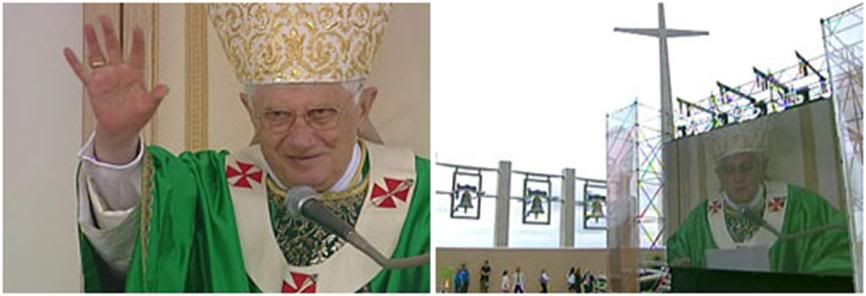
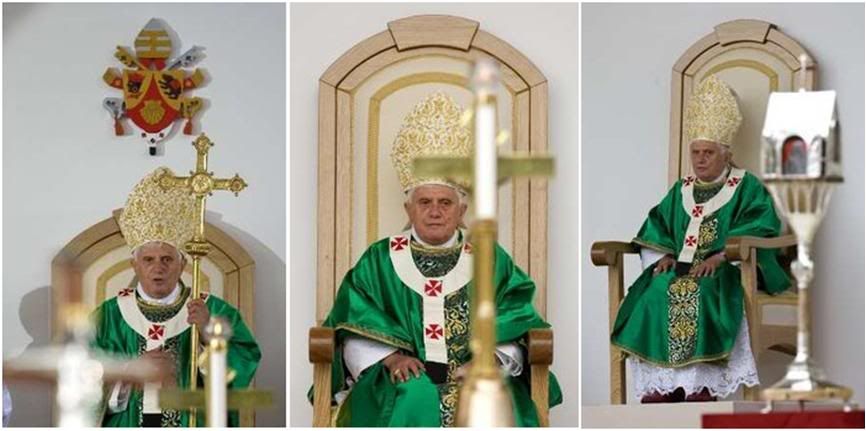
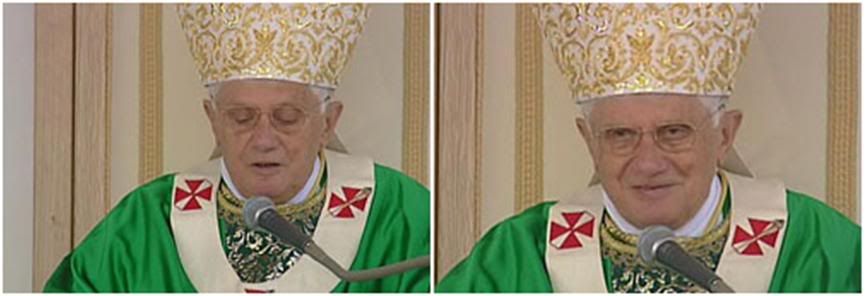

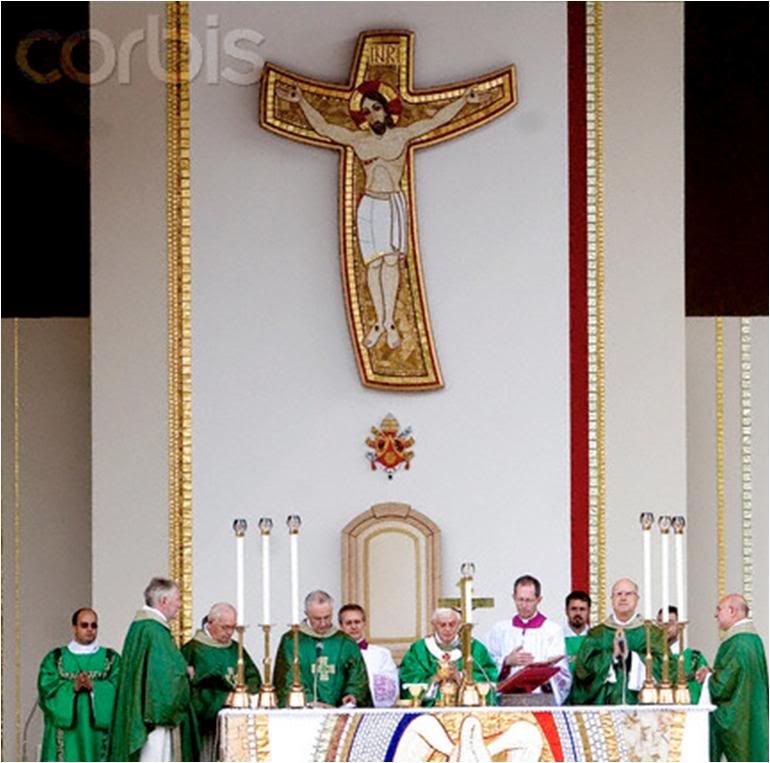
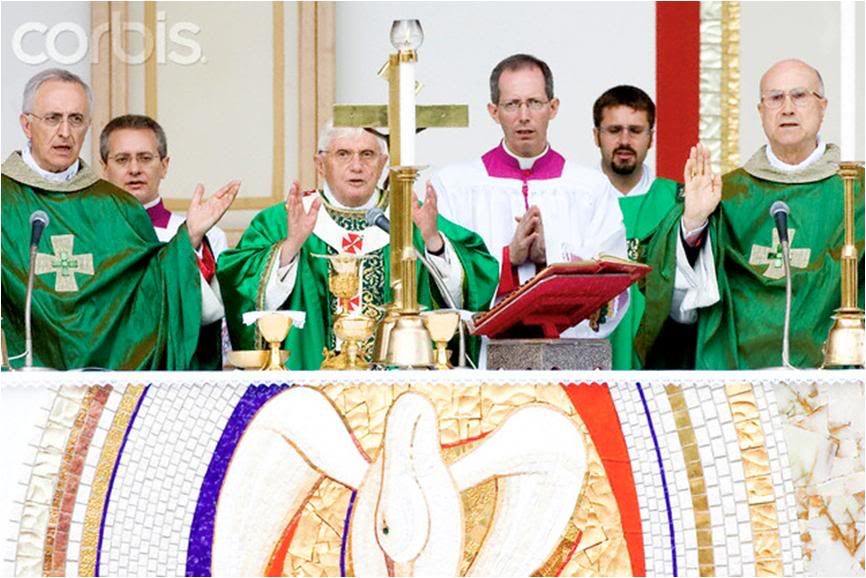
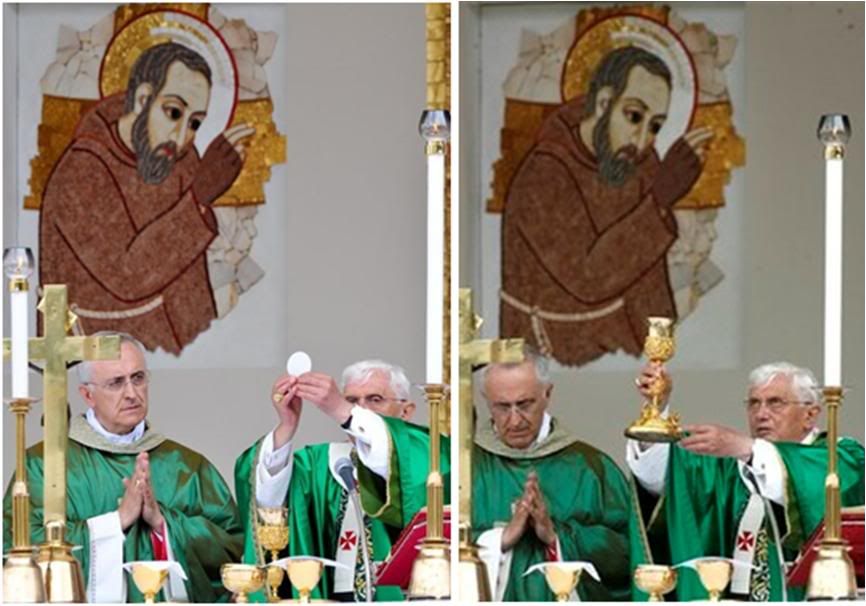
[Modificato da TERESA BENEDETTA 22/06/2009 00:40] |
| |
 21/06/2009 18:37 21/06/2009 18:37 |
|
| | | OFFLINE | | Post: 17.767
Post: 439 | Registrato il: 28/08/2005
Registrato il: 20/01/2009 | Administratore | Utente Senior | |
|

 More than 50,000 attended
More than 50,000 attended
the Pope's Mass today
San Giovanni Rotondo, June 21 (Translated from AGI) - More than 50,000 faithful were in attendance at the Mass celebrated by Benedict XVI today in front of the futuristic church of San Pio, according to the spokesman of the shrine.
No sooner had the Pope imparted the concluding blessing for the Mass and Angelus, then a torrential rain came down again which created quite a problem for the Massgoers trying to leave after the Mass.
Bad weather had earlier caused the Pope to be flown from Rome in a military airplane to Foggia military airbase instead of the planned helicopter ride straight to San Giovanni Rotondo. Despite the rain, the faithful lined both sides of the 4-kilometer route of his Popemobile through the streets of San Giovanni Rotondo.
Since the main piazza was designed to hold only 30,000, Massgoers had spilled over into the piazza in front of the old shrine (Santa Maria delle Grazie), along the entire via Cappuccini leading to it and surrounding streets.
The rain stopped and the clouds lifted just before the Mass began.
A visibly emotional Benedict XVI concelebrated the Mass with Cardinal tarcisio Bertone, Secretary of State; Cardinal Salvatore Di Giorgi, who is a Pugliese; and all the bishops of Puglia.
The Pope used the pyx [container for the hosts) and chalice used by Padre Pio for his daily Masses, which had also been used for the Mass John Paul II offered when he visited San Giovanni Rotondo in 1987.
[The rest of the story quotes from the Pope's Angelus message, posted in full translation lower down on this post.]
PHOTO POST-SCRIPTS TO THE MASS -
CATERINA'S VIDEOCAPS
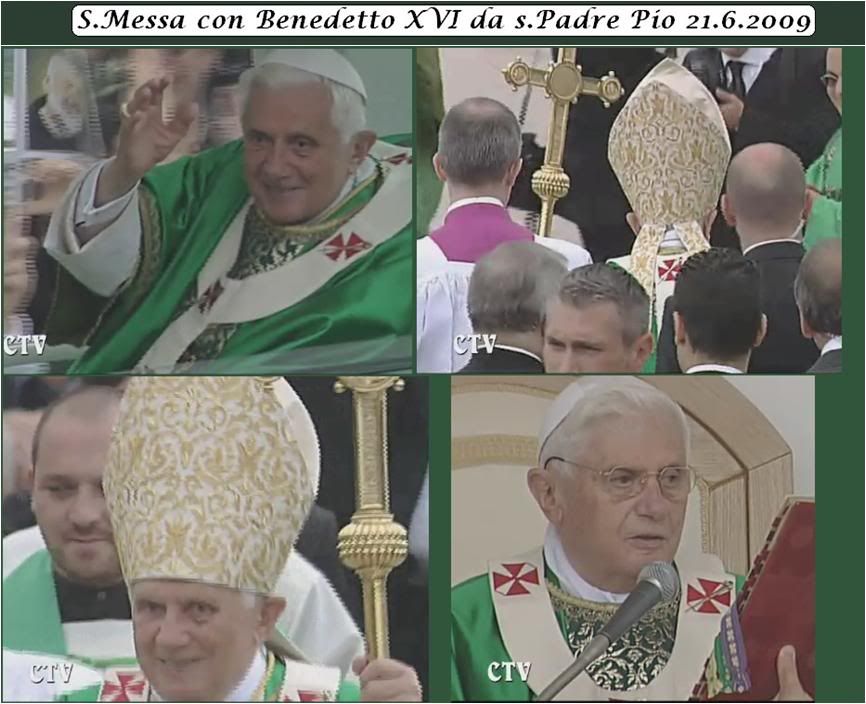
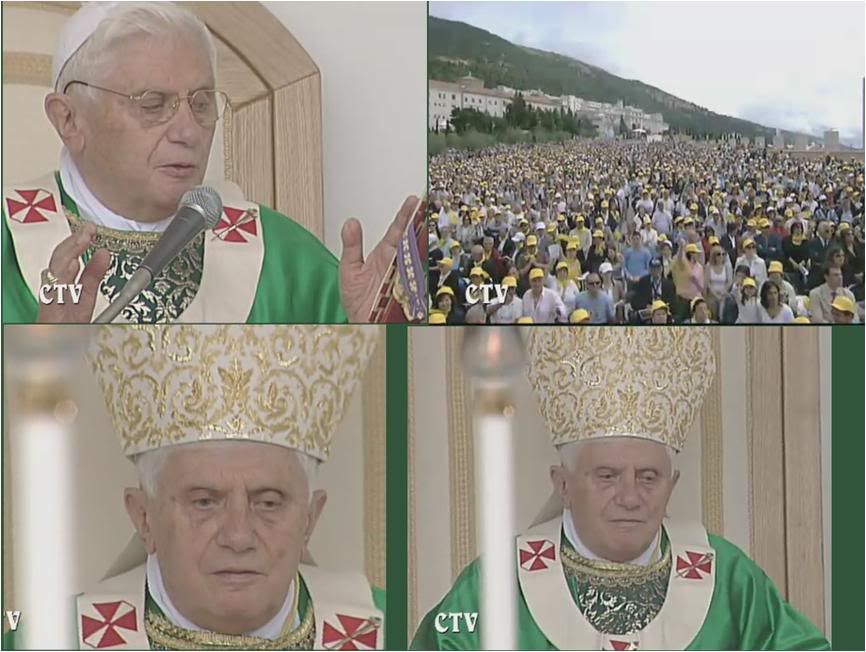
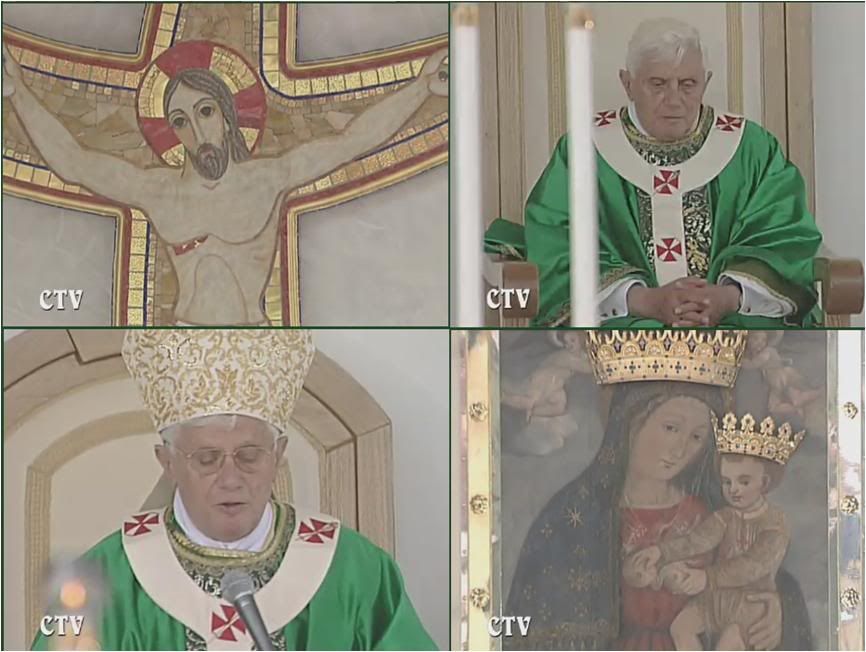


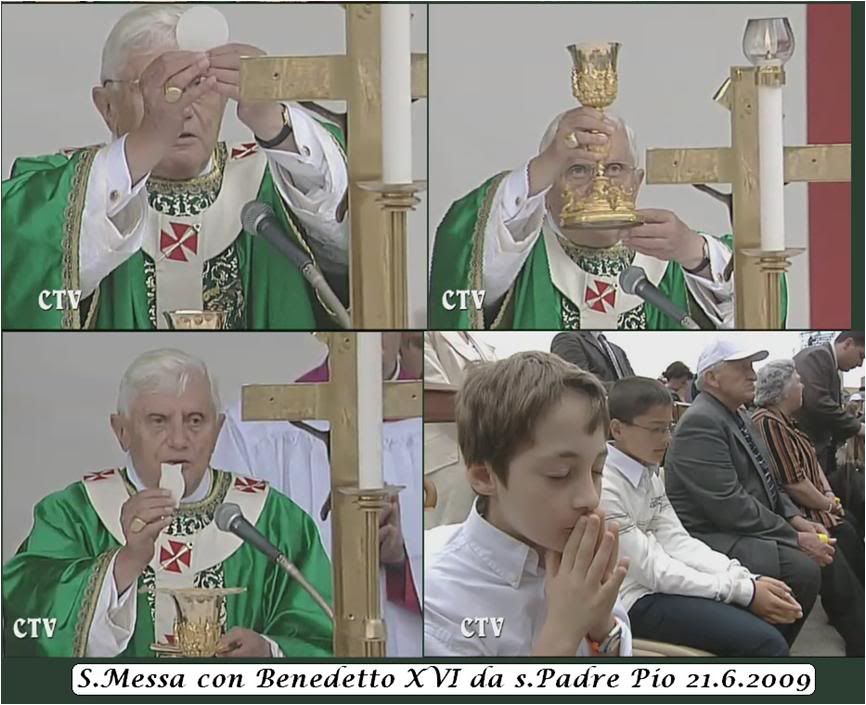 THE POPE'S MESSAGES
THE POPE'S MESSAGES
AT ANGELUS TODAY
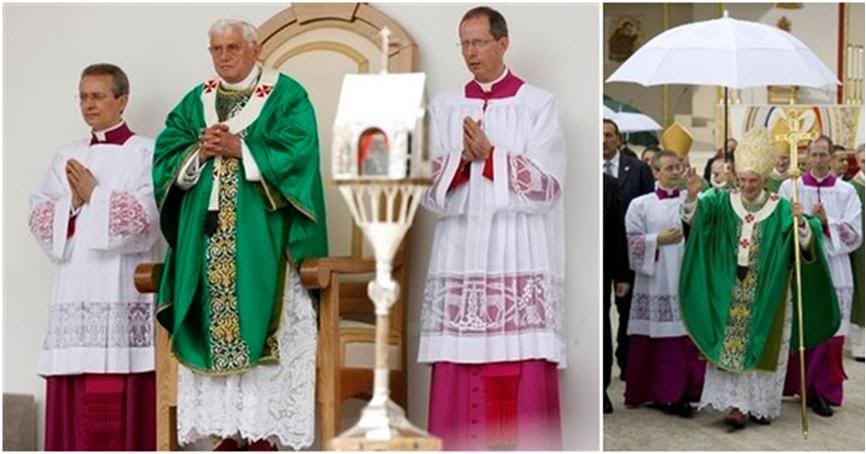
At the end of the Mass celebrated in front of the Church of St. Pio this morning, the Pope led the recitation of the Angelus. Here is a translation of his words before the prayers:
Dear brothers and sisters,
At the end of this solemn celebration, I invite you to recite with me - as you do every Sunday - the Marian prayer of the Angelus.
Here, at the shrine of San Pio da Pietrelcina, we seem to hear his voice exhorting us to turn our filial hearts to the Blessed Virgin: "Love Our Lady, and make her be loved".
Baptized at the church of Santa Maria degli Angeli in Pietrelcina with the name Francesco, he always felt a very tender love for the Virgin like the Poverello of Assisi.
Providence then led him here, to San Giovanni Rotondo, at the Shrine of Santa Maria delle Grazie, where he remained until he died and where his mortal remains rest.
Thus, all his life and his apostolate took place under the maternal regard of Our Lady and with the power of her intercession. Even the Casa Sollievo della Sofferenza he considered to be a work of Mary, 'health of the sick'.
Therefore, dear friends, following the example of Padre Pio, I wish to entrust you today to the maternal protection of the Mother of God.
I specially invoke it for the community of the Capuchin brothers, for the patients in the hospital and for those who take loving care of them, as well as the Prayer Groups who carry forward in Italy and in the world the spiritual legacy of their sainted founder.
To the intercession of Our Lady and of St. Pio da Pietrelcina, I also wish to entrust in a special way the Year of Priests that I opened last Friday, on the Solemnity of the Sacred Heart of Jesus.
May this year be a privileged occasion to highlight the value of the mission and holiness of priests in the service of the church and of mankind in the third millennium.
Let us also pray today for the difficult and often tragic situation of refugees. Yesterday was the World Day for Refugees, promoted by teh United Nations.
There are many persons today who seek refuge in other countries fleeing situations of war, persecution and calamity, and accepting them poses not a few difficulties, but it is nonetheless a duty.
God grant that with the commitment of everyone, we will succeed as soon as possible to take away the causes of a phenomenon as sad as this.
With great affection, I greet all the pilgrims who have come here. I express my gratitude to the civilian authorities and all who worked together to prepare for my visit. I thank you from the heart.
To all, I repeat: walk along the path that Padre Pio has shown you, the way of holiness according to the Gospel of our Lord Jesus Christ. Along this way, the Virgin Mary will always precede you, and with her maternal hand, she will guide you to the celestial homeland.
After the prayers, he had a special greeting for the Polish people:
From San Giovanni Rotondo, at the shrine of St Pio of Pietrelcina, I cordially greet the Polish people, particularly those taking part in the millenary celebration of the martyrdom of St. Bruno of Querfurt, who today, in Giżycko, thank the Lord for the gift of faith brought by this great missionary.
May his efforts for good relations among nations bear fruit in concord among them and in zeal for announcing the Gospel. I bless you all from the heart.

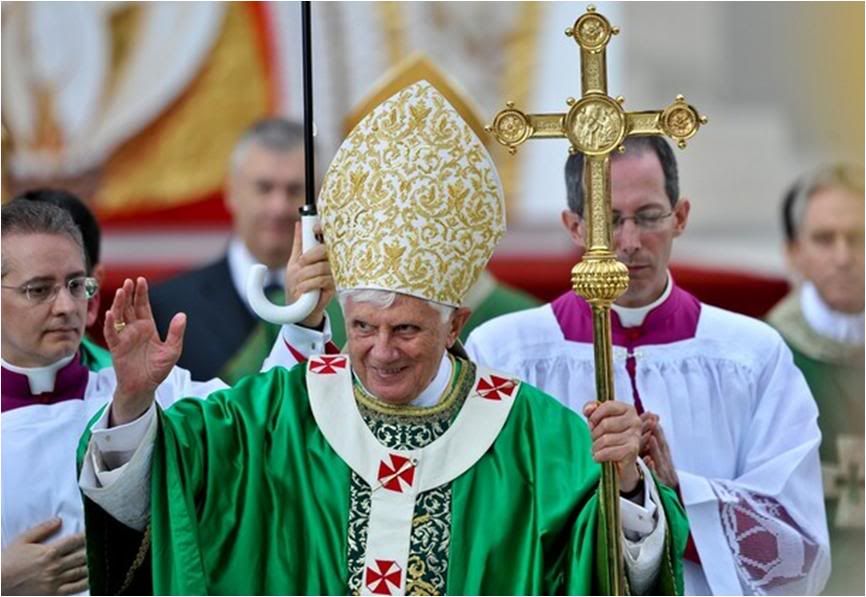
From the Shrine, the Holy Father proceeded to the Casa di Sofferenza for lunch and a brief rest.

[Modificato da TERESA BENEDETTA 16/08/2009 19:38] |
| |
 21/06/2009 19:42 21/06/2009 19:42 |
|
| | | OFFLINE | | Post: 17.768
Post: 440 | Registrato il: 28/08/2005
Registrato il: 20/01/2009 | Administratore | Utente Senior | |
|

 VISIT TO
VISIT TO
CASA SOLLIEVO DI SOFFERENZA
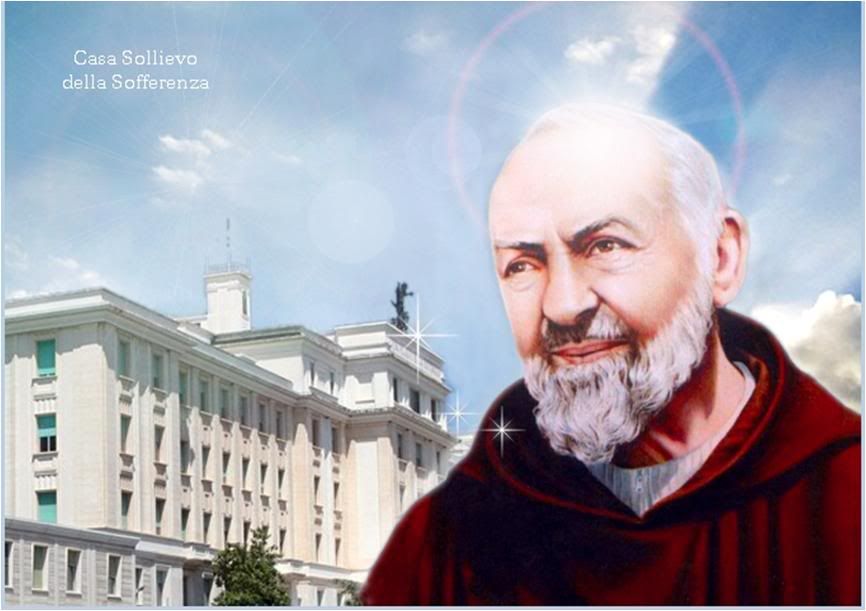
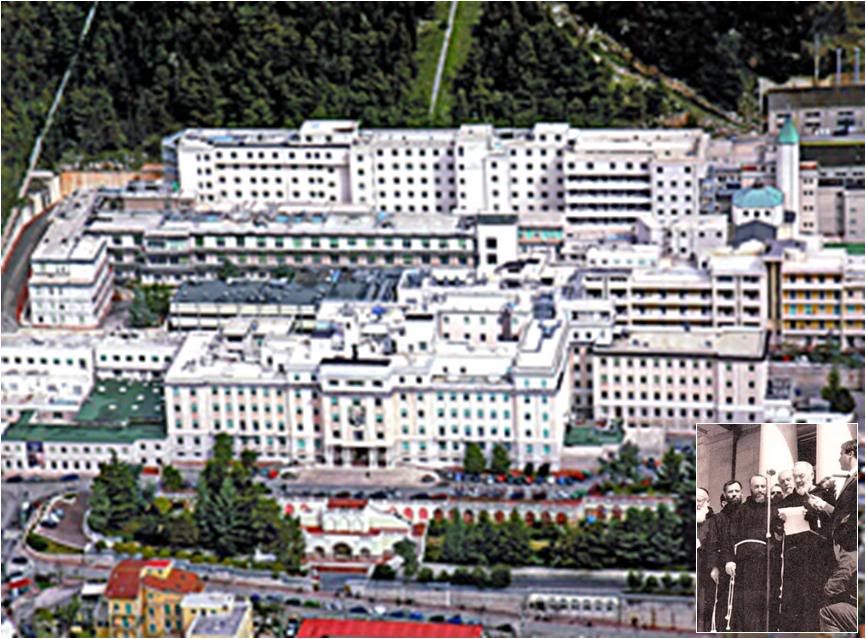 Padre Pio's flagship charity has grown over the years from the initial 250-bed primary-care hospital he inaugurated in 1956 Lower right, inset photo) to the sprawling tertiary-care specialized hospital today with 1200 beds and a building complex that is almost most a mini-city, recognized as one of Europe's best hospitals.
Padre Pio's flagship charity has grown over the years from the initial 250-bed primary-care hospital he inaugurated in 1956 Lower right, inset photo) to the sprawling tertiary-care specialized hospital today with 1200 beds and a building complex that is almost most a mini-city, recognized as one of Europe's best hospitals.
Here is a translation of the Holy Father's address to the patients, staff and personnel of the Casa Sollievo di Sofferenza this afternoon (6/21):
Dear brothers and sisters,
dear patients:
On this visit of mine to San Giovanni Rotondo, I could not fail to come to the Casa Sollievo della Sofferenza which was conceived and created by St. Pio of Pietrelcina as a "place of prayer and science where the human species comes together in the Crucified Christ as one single flock with a single shepherd."
Because of this, he entrusted it to the material and, above all, spiritual support of the Prayer Groups who have here the center of their mission of service to the Church.
Padre Pio intended that in this well-equipped health facility, one could experience first hand that the commitment of science to cure the sick should never be separated from filial trust in God, who is infinitely kind and merciful.
When he inaugurated it on May 5, 1956, he called it 'a creature of Providence' and spoke of this institution as "a seed deposited by God on earth that he will warm with the rays of his love".
So here am I among you to thank God for the good which, faithful to the instructions of a humble Capuchin friar, you have been doing for more than 50 years in this house for the relief of suffering, with well-known results on both the scientific and medical levels.
Unfortunately, it is not possible for me, much as I wish it, to visit every ward and greet the patients one by one, as well as those who are taking care of them.
But I do wish to extend to each one - patients, doctors, relatives, health care workers and pastoral workers - a word of paternal comfort and encouragement to continue on with this evangelical work for the relief of suffering lives, utilizing every resource for the human and spiritual good of the sick and their families.
With these sentiments, I greet all of you, starting with you, brothers and sisters, who are being tried through illness. I greet the doctors, nurses and the health care and administrative personnel. I greet you, venerated Capuchin Fathers who, as chaplains, are continuing the apostolate of your sainted brother friar.
I greet the [relates, first of all, Archbishop Domenico Umberto D'Ambrosio, who has been the pastor of this diocese and who has been called to guide the archdiocese of Lecce - I am grateful to him for the words he delivered in your behalf.
I greet the Director General of the hospital, Dr. Domenico Crupi, and the representative of the patients - I appreciate the kind words that they have just now addressed to me, which have allowed me to better know what is being done here and the spirit in which it is being done.
Every time one enters a place of healing, one thinks naturally of the mystery of sickness and pain, of the hope for healing, and the inestimable value of good health which we often do not realize until we lose it.
In hospitals, one sees firsthand the preciousness of existence, but also its fragility. Following the example of Jesus, who travelled throughout Galilee, "curing every disease and illness among the people" (Mt 4,23), the Church from its beginnings, moved by the Holy Spirit, has always considered it as its duty and privilege to be at the side of those who suffer, with preferential attention to the sick.
Illness, which manifests itself in so many forms and strikes in different ways, raises disquieting questions: Why do we suffer? Can one consider the experience of pain to be positive? Who can liberate us from suffering and death?
These are existential questions which remain humanly unanswerable for the most part, since suffering constitutes an enigma that is inscrutable to human reason. Suffering is part of the mystery of the human being himself.
It is what I underscored in my encyclical Spe salvi, noting that "it stems partly from our finitude, and partly from the mass of sin which has accumulated over the course of history, and continues to grow unabated today".
I added that "Indeed, we must do all we can to overcome suffering, but to banish it from the world altogether is not in our power
simply because... none of us is capable of eliminating the power of evil... a constant source of suffering." (cfr No, 36).
Only God can eliminate the power of evil. Precisely because Jesus Christ came into the world to reveal the divine plan for our salvation, faith helps us to penetrate the sense of everything human, and therefore, even of suffering.
Thus there exists an intimate relation between the Cross of Jesus - symbol of supreme pain and the price of our true freedom - and our pain, which is transformed and sublimated in the knowledge of the nearness and solidarity of God.
Padre Pio sensed this profound truth and on the first anniversary of inaugurating this particular work, he said that in this hospital, "the suffering person must experience the love of God through the wise acceptance of his pains, in serene meditation of his destiny" (Address on May 5, 1957).
He also noted that in the Casa Sollievo, "patients, doctors and priests shall be reservoirs of love, which the more it is abundant in oneself, the more it is communicated to others" (ibid.).
To be a 'reservoir of love": This, brothers and sisters, is the mission that our Saint reminds you tonight, you who in diverse ways make up the great family of this Casa Sollievo della Sofferenza.
May the Lord help you to realize the project begun by Padre Pio with the contribution of everyone: doctors and scientific researchers, health care workers and various administrative personnel, volunteers and benefactors, Capuchin friars and other priests.
Not to forget the Prayer Groups who "alongside the Casa del Sollievo, are the front lines of this citadel of charity, nurseries of faith, hearths of love" (Padre Pio, address on May 6, 1966).
On all and on each one I invoke the intercession of Padre Pio and the maternal protection of Mary, health of the sick.
I thank you once more for your hospitality, and as I assure you of my prayers, I bless you all from the heart.
[Modificato da TERESA BENEDETTA 22/06/2009 14:50] |
| |
 21/06/2009 20:11 21/06/2009 20:11 |
|
| | | OFFLINE | | Post: 17.769
Post: 441 | Registrato il: 28/08/2005
Registrato il: 20/01/2009 | Administratore | Utente Senior | |
|

 MEETING WITH CLERGY,
MEETING WITH CLERGY,
RELIGIOUS AND YOUNG PEOPLE
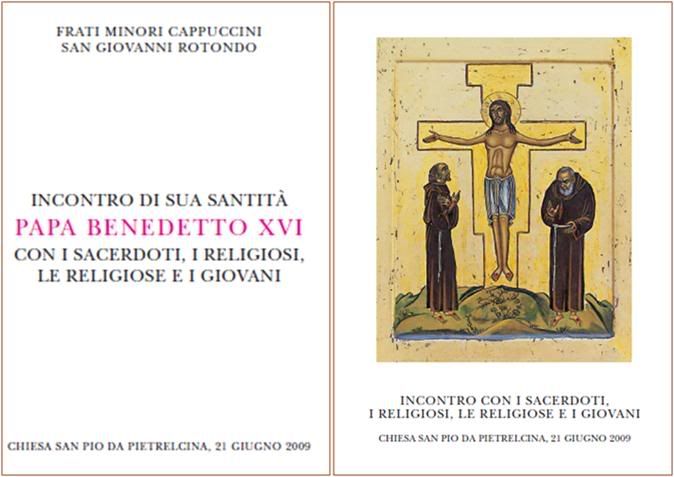 Cover illustration: Icon, 'I bear the stigmata of Christ in my body', Anna Maria di Domenico, 1999. Provincial Curia of the Capuchins, Foggia
Cover illustration: Icon, 'I bear the stigmata of Christ in my body', Anna Maria di Domenico, 1999. Provincial Curia of the Capuchins, Foggia
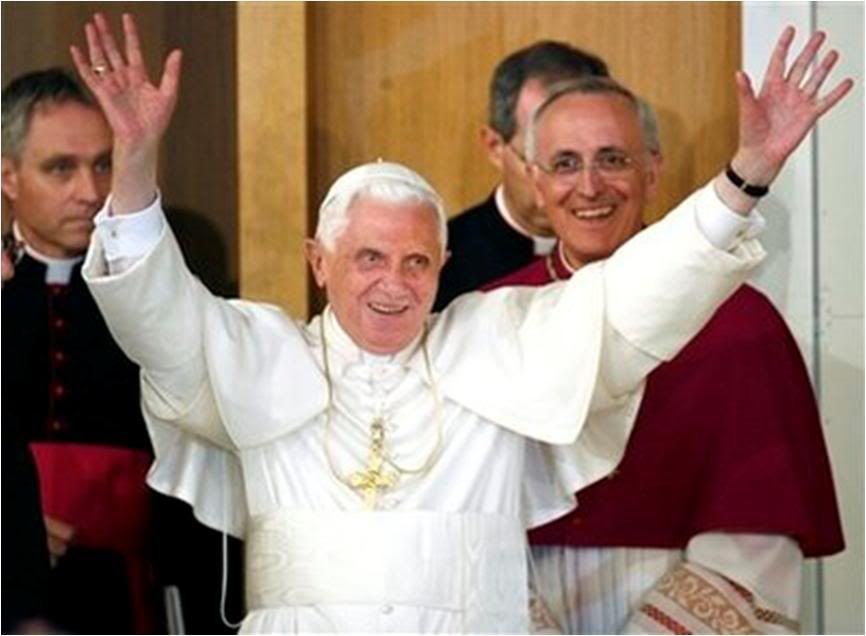
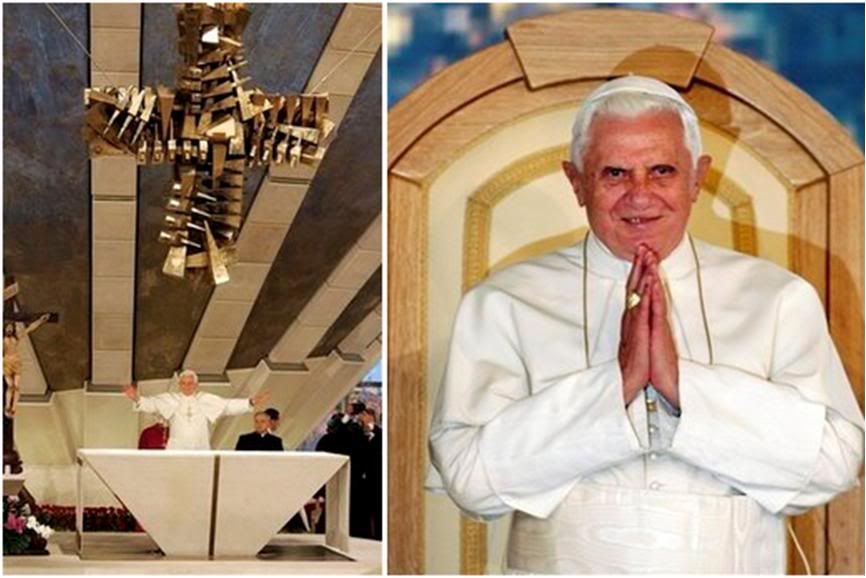

Dear priests,
dear religious men and women,
dear young people!
With this meeting, my pilgrimage to San Giovanni Rotondo comes to a close. I am grateful to the Archbishop of Lecce, Apostolic Administrator of this diocese, Mons. Domenico Umberto d’Ambrosio, and Fr. Mauro Jöhri, Minister General of the Capuchin Friars Minor, for the kind words that they have addressed to me in your name.
And now my greeting extends to you, dear priests, who are engaged daily in service to the people of God as wise guides and assiduous workers in the vineyard of the Lord.
I also greet affectionately our dear consecrated persons who are called to offer testimony of total dedication to Christ through the faithful practice of evangelical counsel.
And a special thought for you, dear Capuchin friars, who lovingly tend these homes of spirituality and evangelical solidarity, welcoming pilgrims and devotees drawn here by the living memory of your sainted brother Padre Pio of Pietrelcina.
I thank you from the heart for this precious service that you render to the Church and to the souls who rediscover here the beauty of faith and the warmth of divine kindness.
And I greet you, dear young people, to whom the Pope looks with confidence as the future of the Church and of society.
Here, in San Giovanni Rotondo, everything speaks of the holiness of a humble friar and zealous priest, who this evening invites us to open our hearts to the mercy of God. He exhorts us to be saints, that is, sincere and true friends of Jesus. And I thank you for the words of your youth representative.
Dear priests, just the other day, on the Solemnity of the Sacred Heart of Jesus and World Day of Priestly Sanctification, we began the Year for Priests, during which we remember with veneration and affection the 150th death anniversary of St. Jean-Marie Vianney, the holy Curate of Ars.
In the letter that I wrote for the occasion, I wished to underscore how important the holiness of priests is to the life and mission of the Church.
Like the holy Curate of Ars, Padre Pio reminds us of the dignity and responsibility of the priestly ministry.
Who has not been struck by the fervor with which he relived the Passion of Christ in every Eucharistic celebration? From his love for the Eucharist, there flowed from him, as from the Holy Curate of Ars, a total availability to all the faithful, especially sinners.
Moreover, if St. Jean Marie Vianney, in a troubled and difficult period, sought in every way to make his parishioners rediscover the meaning and the beauty of sacramental penance, for the holy Friar of Gargano, the care of souls and the conversion of sinners was a desire that consumed him until his death.
How many persons changed their lives thanks to his patient priestly ministry! How many long hours he spent in the confessional! As for the holy Curate of Ars, it was the ministry of confessor which constituted his biggest claim to glory and the distinctive characteristic of the holy Capuchin.
How can we not then be aware of the importance of taking part devoutly in the Eucharistic celebration and to avail frequently of the sacrament of Confession?
In particular, the sacrament of Penance must be better valued, and priests must never be resigned to seeing their confessionals deserted nor limit themselves to observing the disaffection of the faithful for this extraordinary source of serenity and peace.
There is another great teaching that we can draw from the life of Padre Pio: the value and necessity of prayer. To whoever asked him what he thought of himself, he usually answered, "I am only a poor friar who prays".
Indeed he prayed - always and everywhere - with humility, trust and perseverance. Here then is a fundamental point not only for the spirituality of a priest, but for that of every Christian, but even more for yours, dear religious men and women, who have been chosen to be closer to Christ through practising your vows of poverty, chastity and obedience.
Sometimes you may be overcome by discouragement at the weakening and even the abandonment of the faith which has taken place in our secularized societies.
Certainly, one must seek new channels for communicating the evangelical truth to the men and women of our time, but since the essential content of the Christian announcement must always remain the same, one must go back to its original source, to Jesus Christ who is "the same yesterday, today, and for always" (Heb 13,8).
The human and spiritual experience of Padre Pio teaches us that only a soul who is intimately united to the Crucified Lord can succeed in transmitting even to those who are far away the joy and the richness of the Gospel.
Love of Christ is inevitably united with love for his Church, guided and inspired by the power of the Holy Spirit, in which each of us has a role and a mission to fulfill.
Dear priests, dear religious men and women, you all have different tasks assigned to you as well as different charisms, but the spirit with which to realize them must be one and the same so that your presence and activity among the Christian people may be eloquent testimonials to the primacy of God in your existence. Was this not perhaps what everyone perceived in St. Pio of Pietrelcina?
Allow me now to address a special word to the young people whom I see here numerous and enthusiastic.
Dear friends, thank you for your warm welcome and for the fervent sentiments that your representative expressed in your behalf.
I have noted that the pastoral plan for your diocese for the triennium 2007-2010 dedicates a lot of attention to the mission to the youth and to the family, and I am sure that through the itinerary of listening, confrontation, dialog and verification in which you have been engaged, there will come forth an ever greater attention to families and a ready ear to listen to the real expectations of the new generations.
I am aware of the problems which assail you, dear boys and girls, which threaten to suffocate the enthusiasms typical of youth. Among these, in particular, I would cite unemployment which dramatically affects not a few young people in the South of Italy.
But do not lose heart! You are 'young people with great heart', as you have been told often this year with the Diocesan Youth Mission which was inspired and led by the Regional Seminary of Molfetta last September.
The Church will not abandon you. Do not abandon the Church! Your contribution is needed to build living Christian communities and societies that are more just and open to hope.
And if you wish to keep a big heart, enlist yourself in the school of Jesus. Just the other day, we contemplated his big heart full of love for humanity. He will never abandon you nor betray your trust - he will never lead you down the wrong paths.
Like Padre Pio, be faithful friends of the Lord Jesus, carrying on with him a daily relationship through prayer and listening to his Word, the assiduous practice of the sacraments, and heartfelt belonging to his family which is the Church.
This should be the basis for your program for life, each of you, dear young people, as also you, dear priests, and you, dear religious men and women.
For each and everyone, I assure my prayers as I implore the maternal protection of Santa Maria delle Grazie to watch over you from her shrine in whose crypt repose the mortal remains of Padre Pio.
I thank you from my heart, once more, for your welcome, and I bless you all, along with your families, communities, parishes and the entire diocese.
Thank you.

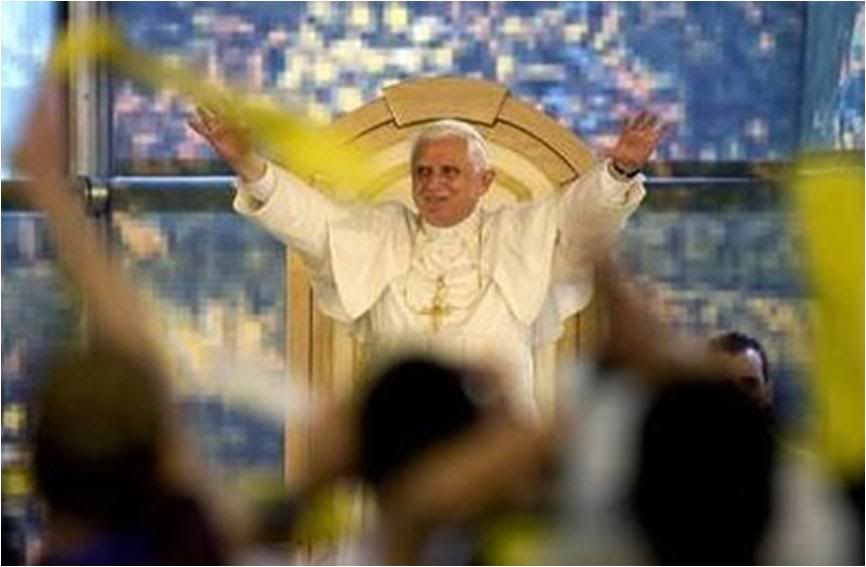 Footnote on the pilgrimage Church of San Pio:
Footnote on the pilgrimage Church of San Pio:
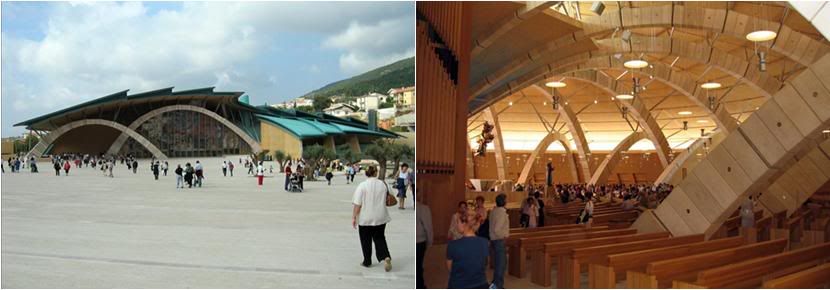 It has been controversial since its design was first made known because its ultra-modern design by one of Italy's best-known contemporary architects, Renzo Piano, is such a contrast to the person and temperament of Padre Pio. It was built to accommodate 6,500 seated, with a piazza designed to hold 30,000.
It has been controversial since its design was first made known because its ultra-modern design by one of Italy's best-known contemporary architects, Renzo Piano, is such a contrast to the person and temperament of Padre Pio. It was built to accommodate 6,500 seated, with a piazza designed to hold 30,000.
It's hard to find pictures of the interior and its fixtures, but I really find the hanging Cross (shown in the photos with the Pope) rather monstrous. It looks to me like a giant guerilla's bandolier, bristling with lance-shaped bullets.
[Modificato da TERESA BENEDETTA 22/06/2009 03:52] |
| |
 22/06/2009 06:48 22/06/2009 06:48 |
|
| | | OFFLINE | | Post: 17.770
Post: 442 | Registrato il: 28/08/2005
Registrato il: 20/01/2009 | Administratore | Utente Senior | |
|

 Pope ends pilgrimage by blessing
Pope ends pilgrimage by blessing
future resting place of Padre Pio
by Salvatore Izzo

San Giovanni Rotondo, June 21 (Translated from AGI) - The Pope's last act before going back to Rome this evening was to bless the 'lower church' of the futuristic pilgrimage Church of San Padre Pio designed by Renzo Piano in which traditionalists claim to see many Masonic symbols.
In a yet-to-be-determined future this is where the mortal remains of the saint are supposed to rest eventually.
One must use the conditional because even at the end of the public exposition in September, the body will remain in the crypt of the Church of Santa Maria delle Grazie, the modest building that Padre Pio called a 'matchbox'.
But among the mosaics and frescoes of the Jesuit artist Mark Rupnik decorating the lower church blessed by the Pope today is a marker commemorating today's event, stating that this will be the place where the saint's body will be kept in custody.
This effectively declares a fait accompli to all those who oppose the transfer even while a decision about this is still awaited from the Congregation for the Causes of Sainthood.
In any case, Archbishop Domenico D'Ambrosio, who has been named bishop of Lecce, will be leaving his successor significant problems, especially since some extremists have accused nim of profaning a cadaver for having authorized the exhumation of the saint's body last year.
Whoever takes his place must be a courageous man because both the Capuchin Order which built the new church and the Casa Sollievo della Sofferenza - the huge hospital founded by Padre Pio to offer first-rate medical asasistance to the South of Italy - are debt-ridden despite the millions of pilgrims coming every year.
Huge crowds are not news in San Giovanni Rotondo, and they were there today: at least 50,000 persons attended the Pope's Mass. Nor did the rain turn away those who stood against the police barriers all day to catch a glimpse of the Pope as his Popemobile went by.
In the same way, all the polemical talk that preceded this trip failed to dampen the Pope's spirits.
"The risks of activism and secularization," he said, addressing the local clergy and perhaps, the Capuchins most of all, "are always present, and that is why my visit also has the purpose of confirming you in faithfulness to the mission you inherited from your most beloved Padre Pio."
"Sometimes you may be too caught up in the many demands required in serving the needs of pilgrims, or of patients in the hospital," he pointed out, "that you risk neglecting what is truly necessary: listening to Christ in order to comply with the will of God."
[ The bulk of the story is made up of more citations from the Pope's four texts today - all of which are posted on this page in full translations.]
The theologian Pope began his visit to San Giovanni Rotondo by venerating the remains of the saint in the crypt chapel of Santa Maria delle Grazie, where Padre Pio had lived, worked and died.
The Capuchin spokesman said "The Pope venerated the body kneeling down - it was a very intense moment."
Among the Capuchins who joined the Pope in the crypt were Fr. Paolo Covino, 90, who had given the last rites to Padre Pio, and the legendary Fra Modestino, even older, the best-known of Padre Pio's disciples.
For years now, pilgrims form long lines, even as early as 4 o'clock in the morning, at Fra Modestino's gatekeeper's lodge but because of his age, he is no longer able to bless everybody.
In the absence of the right photos to illustrate this item, I am posting two of the images I found very striking in today's coverage:
 The Crucifix that is the centerpiece of the altar stage is in the style of Fr. Rupnik's mosaics. Details of some of these scenes were used to illustrate yesterday's Mass libretto. Rupnik and his group executed 56 scenes from the lives of Jesus, Francis of Assisi, and Padre Pio, in gilt mosaic to decorate the 'lower church' which the Pope inaugurated yesterday.
The Crucifix that is the centerpiece of the altar stage is in the style of Fr. Rupnik's mosaics. Details of some of these scenes were used to illustrate yesterday's Mass libretto. Rupnik and his group executed 56 scenes from the lives of Jesus, Francis of Assisi, and Padre Pio, in gilt mosaic to decorate the 'lower church' which the Pope inaugurated yesterday.
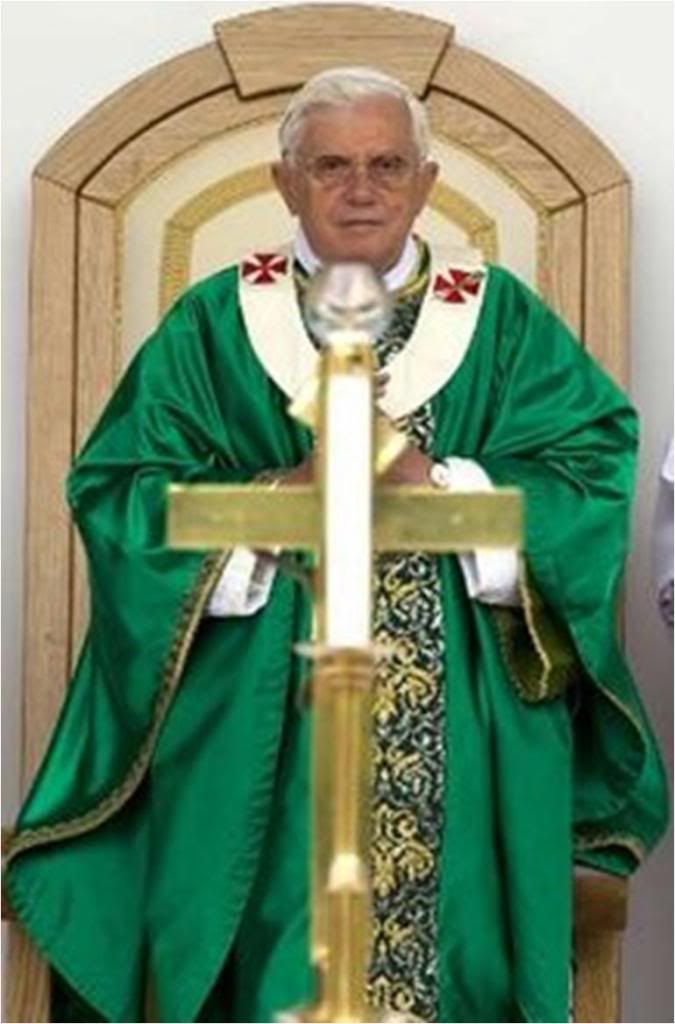 [Modificato da TERESA BENEDETTA 22/06/2009 15:01] |
| |
|
|
|
|